



In 2019 we celebrate the 150th anniversary of Finsbury Park, and we time travel through its past and future with the launch of our Citizen Sci-fi programme and methodology. Dominant sci-fi franchises of our time, from Black Mirror to Westworld, have captured popular attention by showing us their apocalyptic visions of futures made desperate by systems of dominance and despair.
What is African-American author, Octavia E. Butler’s prescription for despair? Sci-fi and persistence. Sci-fi as a tool for getting us off the beaten-track and onto more fertile ground, and persistent striving for more just societies.The 2015 book Octavia’s Brood honoured her work, with an anthology of sci-fi writings from US social justice movements and this inspired us to try a new artistic response to the histories and possible futures of Finsbury Park.
Furtherfield’s Citizen Sci-Fi methodology combines citizen science and citizen journalism by crowdsourcing the imagination of local park users and community groups to create new visions and models of stewardship for public, urban green space. By connecting these with international communities of artists, techies and thinkers we are co-curating labs, workshops, exhibitions and Summer Fairs as a way to grow a new breed of shared culture.
Each artwork in the forthcoming exhibition invites audience participation – either in it’s creation or in the development of a parallel ‘people’s’ work – turning every idea into a portal to countless more thoughts and visions of the past and future of urban green spaces and beyond.
So where do we start? Last year we invited artists, academics and technologists to join us in forming a rebel alliance to fight for our futures across territories of political, cultural and environmental injustice. This year both our editorial and our exhibition programme are inspired by this alliance and the discoveries we are making together.
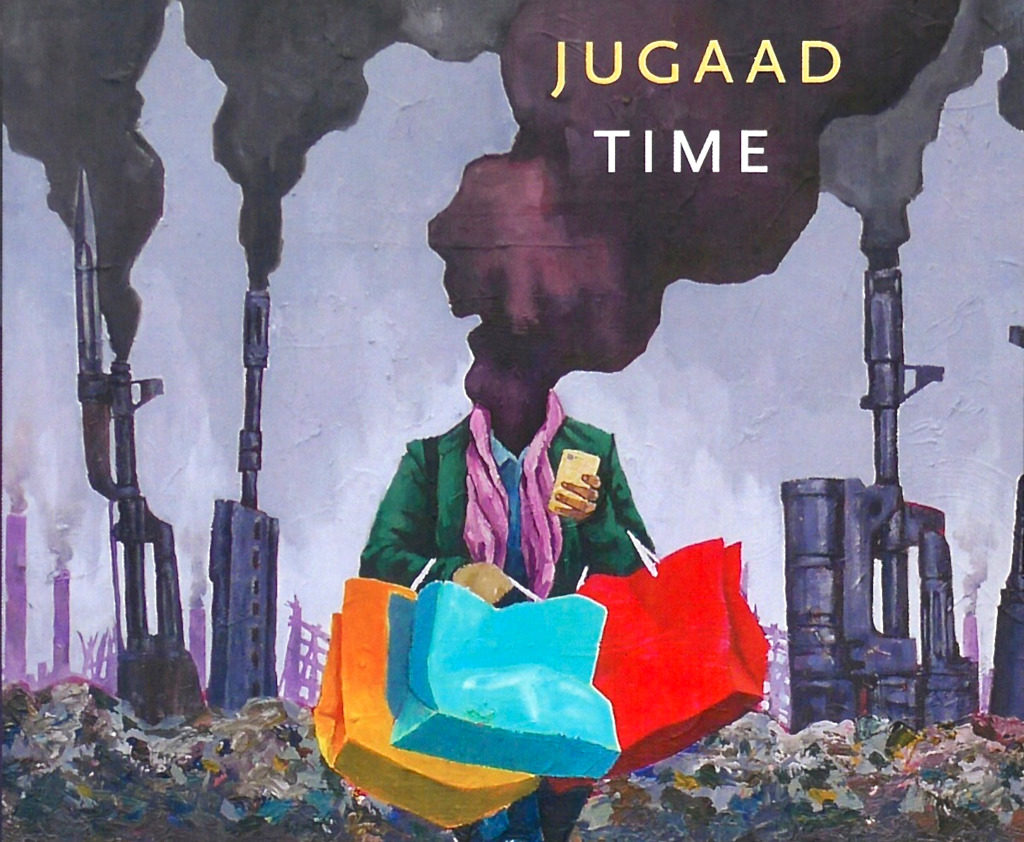
To kick off this year’s Time Portals programme at Furtherfield, in April we will host the launch and discussion around Jugaad Time, Amit Rai’s forthcoming book. This reflects on the postcolonial politics of what in India is called ‘jugaad’, or ‘work around’ and its disruption of the neoliberal capture of this subaltern practice as ‘frugal innovation’. Paul March-Russell’s essay Sci-Fi and Social Justice: An Overview delves into the radical roots and implications of Mary Shelley’s Frankenstein (1818). This is a topic close to our hearts given our own recent exhibitions Monsters of the Machine and Children of Prometheus, inspired by the same book. Meanwhile we’ve been hosting workshops with local residents exploring our visions for Finsbury Park 150 years into the future. To get a flavour of these activities Matt Watkins’ has produced an account of his experience of the Futurescapes workshop at Furtherfield Commons in December 2018.
In May we will open the Time Portals exhibition which features several new commissions. These include Circle of Blackness by Elsa James. Through local historical research James will devise a composite character to embody the story of a black woman from the locality 150 years ago and 150 years in the future. James will perform a monologue that will be recorded and produced by hybrid reality technologist Carl Smith and broadcast as a hologram inside the Furtherfield Gallery throughout the summer. While Futures Machine by Rachel Jacobs is an Interactive machine designed and built through public workshops to respond to environmental change – recording the past and making predictions for the future while inspiring new rituals for our troubled times. Once built, the machine occupies Furtherfield Gallery, inviting visitors to play with it.

Time Portals opens on May 9th (2019) with other time traveling works by Thomson and Craighead, Anna Dumitriu and Alex May, Antonio Roberts and Studio Hyte. Visitors will be invited to participate in an act of radical imagination, responding with images, texts and actions that engage circular time, long time, linear time and lateral time in space towards a collective vision of Finsbury Park in 2169.
From April onwards, a world of activities, workshops with local families and their enriching noises, reviews, interviews and an array of experiences will unfold. Together we dismiss the dystopian nightmares and invite communities to join us in one of London’s first “People’s Parks” to revisit and recreate the future on our own terms together.
Marc Garrett will be interviewing Elsa James, about her artwork Circle of Blackness, and Amit Rai about his book Jugaad Time. Both will soon be featured on the Furtherfield web site.
Data structures hold information in a way that makes it easier to be manipulated by software, given particular constraints on computing resources such as the time or space taken up. A linked list takes very little space in a computer’s memory on top of the space taken up by the data it contains and is very quick to add new data to but it is very slow to search from the beginning to the end of the list.
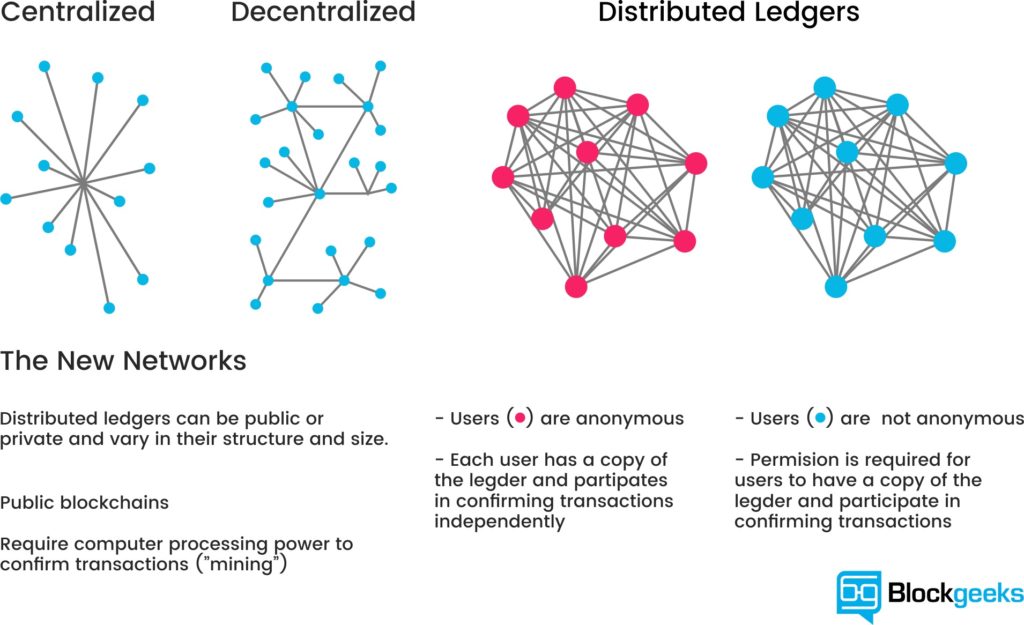
In contrast, a “hash table” data structure makes looking up information much faster by calculating a unique identifier “hash” for each item that can be used as an index entry for the data rather than having to search all the way through a long list of links. Think of a hash as a very large, very unique number that can be reliably calculated for any piece of data – any file containing the text “Hello world!” will have the same cryptographic hash as any other. The cost of this fast access is that the table must be allocated and configured in full before data can start to be stored in it.
A “binary tree” balances speed and storage space by storing data in a structure that looks like a tree with two branches at the end of each branch, creating a simple hierarchy that takes very little initial extra storage space but that given its structure is relatively fast to search compared to a linked list.
Each block in a blockchain is linked to the previous one by identifying it using its (cryptographic) hash value. And the transactions in the block are stored in a (cryptographic hash) tree. This means that a blockchain is a more complex structure than the simple image at the top of this page. But so what? Why should we care about the shape of the blockchain when its social, environmental and political impact seem to be in such urgent need of critique?
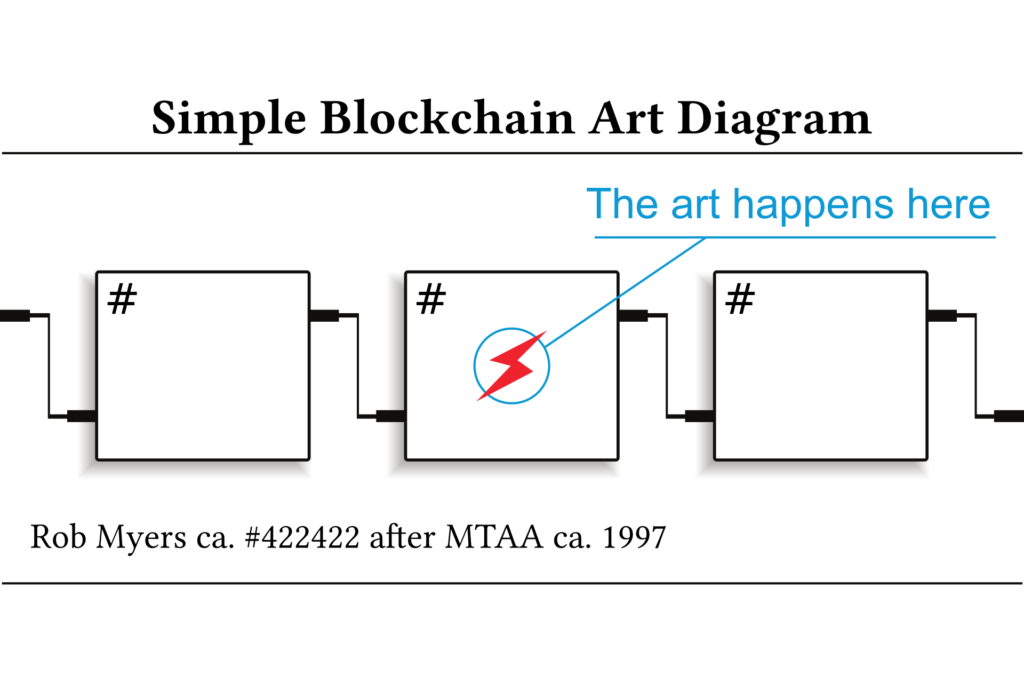
The geometric, techonomic and social form of a blockchain are all related, and understanding one helps us to reason better about the others. As the quick tour through software data structure design above indicates, the constraints on technological form are not abstract, they are tied to real needs and agendas. Bitcoin is no exception to this – the lists and trees that make up its blockchain as they are built and broadcast on a peer-to-peer network by computers competing to claim economic incentives for doing so were chosen very explicitly to exclude the intervention of the state and other “trusted third parties” (such as banks) in authentic economic relationships between peers.
Bitcoin’s algorithms prioritise the security of the blockchain above all else, maximising security like a mythical Artificial Intelligence “paperclipper” maximises the production of a particular material good regardless of the other consequences . This explains Bitcoin’s energy consumption, which whilst lower than the US military or the other equivalent systems that guarantee the security of the dollar is probably still much higher than Satoshi Nakamoto originally envisioned.
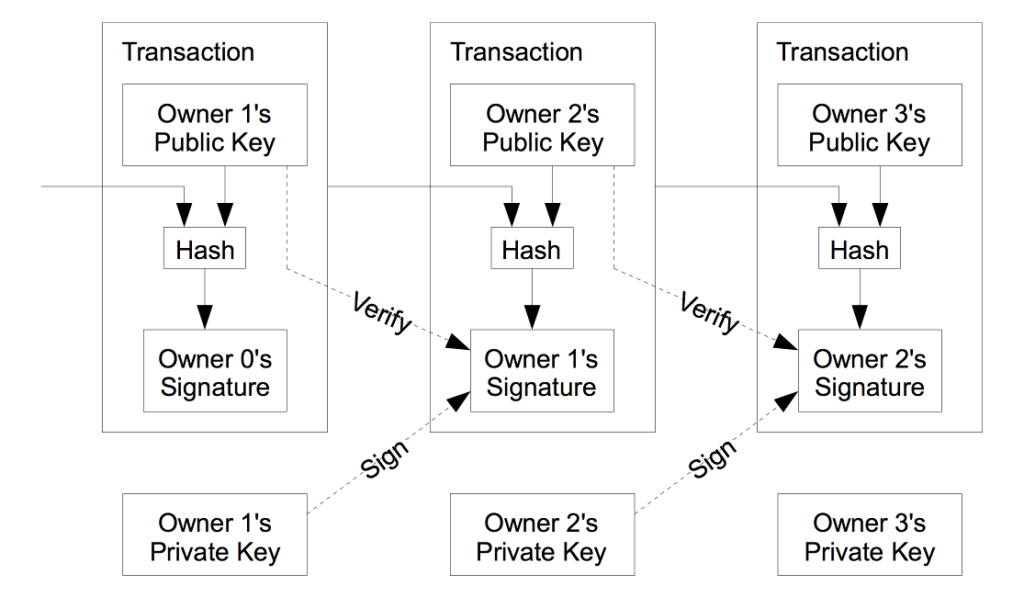
There are other algorithms, though, which have been created since 2008 to address perceived flaws in Bitcoin’s design or to address different ideological agendas. These create different forms, and contrast instructively with that of Bitcoin’s blockchain. Please note that these are experimental and often controversial technologies. Nothing that follows is investment advice.
Bitcoin creates blocks on average every ten minutes. Faster currencies quickly emerged, LiteCoin and Dogecoin are leading examples, with 2.5 minute and one minute block times respectively. Blocks may contain more or fewer transactions, and be more or less frequent even within the same blockchain as the algorithms tweak its parameters to ensure its security. Blockchains have rhythm, they stall or race, each block is larger or smaller and closer or further from the last one. Transactions fan into and out from addresses in each block, with varying values of currency or amounts of data each time. We are now very far from the block-and-arrow diagrams of linked lists indeed.
The Ethereum system, which extends Bitcoin’s financial ledger into a more general system for “smart contracts”, has the smallest block time of any leading cryptocurrency – fifteen seconds. Like the others mentioned it still uses a variant of the energy-hungry “Proof of Work” security system from Bitcoin. In Proof of Work, anyone who wants to add a block of transactions to the list must consume computing resources to solve a puzzle (essentially guessing a large number ending with multiple zeroes). As these resources cost money, anyone willing to expend them must stand to gain more from adding the next block than they lose to their electricity bill. This Game Theory gambit secures a Proof of Work blockchain. The mindlessly focussed, paperclipper nature of blockchain security algorithms means that as more people use more computers to compete to be the next person to add a block to the chain and claim the economic reward for doing so, the difficulty and therefore the amount of electricity required to solve that puzzle has increased massively, growing the energy footprint of cryptocurrency.
Ethereum is planning to switch to a “Proof of Stake” system, like that used in currencies like NXT and Decred (about which more below). Rather than burning electricity like Proof of Work, Proof of Stake uses a blockchain’s own existing currency “staked” by users to demonstrate their standing within the system and to thereby get a chance to be chosen by the network to add the next block. Proof of Stake and its related “Proof of Authority” system move from the “miners” of Proof of Work who operate on the blockchain from outside to a system of capitalist investors or even an aristocratic class of gatekeepers who operate within the logic of the blockchain itself. This folds the blockchain’s outside in on itself.
Bitcoin’s blocks have been fixed at one megabyte in size since a temporary security fix by Satoshi Nakamoto introduced the limit. As Bitcoin usage has grown, blocks have become increasingly full (allegedly often as a result of economic “spam” attacks intended to manipulate prices – competing for space in blocks drives up transaction fees which can in turn discourage users and ultimately drive down the price of Bitcoin). How should this problem be addressed – how should Bitcoin scale? Should the number of transactions stored in the blockchain grow, increasing the block size limit and making it harder for individuals to store the blockchain on consumer hardware in a decentralised manner? Or should transactions be somehow moved “off-chain” into “second-tier” systems that build on top of the blockchain, adding complexity and introducing potential new choke-points for existing capital to exploit? Big blocks or small blocks (like the big or little ends of eggs, or integers…)? This is a real debate in the Bitcoin world, and illustrates how the consequences of a simple change in technical form like, for example, increasing block sizes from one to two megabytes, can have profound effects on the social and economic form of a cryptocurrency. “Big blockers” propose solutions like the breakaway “Segwit2X” or “Bitcoin Cash” systems, scaling “on-chain” with ever greater amounts of data in the same structures. “Small blockers” propose solutions that move data out of the blockchain, into “Segregated Witnesses” that store cryptographic signatures outside of the blockchain, or the cybernetic rhizomes of “Lightning Networks”.
A Lightning Network adds a second peer-to-peer network of nodes that pass transactions between themselves. These are all valid Bitcoin transaction data structures, but unlike the main Bitcoin peer-to-peer network they are not immediately broadcast to the main Bitcoin network to be bundled up into blocks. Rather they can be replaced at any moment by new transactions, sending different amounts of cryptocurrency along a “channel” between one or (most often) more participants arranged in a random network like the one used by the Tor privacy network.
It’s an elegant but sometimes complex solution, and one that triggers moral panic within some elements of the Bitcoin community equivalent to that triggered by Bitcoin within some elements outside of it. Lightning Nodes with more Bitcoin can extract more fees from Lightning Network transactions, to be sure, and this is a form of centralisation. Decentralisation’s value to cryptocurrency is as a concrete guarantor of security, and Bitcoin’s value is its security. But individuals can still run Lightning Network nodes and send transactions between each other, and pools of capital already have centralising effects in exchanges and mining cartels.
Techniques similar to those used to move transactions off-chain by Lightning Networks can be used to move value between different blockchains without exchanges centralising the process. “Atomic Swaps”, the “Plasma” system and the realisation of the previously mythical “Doge-Ethereum bridge” using the TrueBit system are all different ways of building wormholes between the separate universes of individual blockchains.
Another approach to scaling is borrowed from conventional database design: breaking the blockchain into smaller and smaller pieces or “shards“, forming another tree structure, allows each group of users of the blockchain to only have to keep track of the part that contains the transactions they are interested in. The Ethereum blockchain will move to sharding in future, after its switch to Proof of Stake. Sharding destroys the metronomic, panopticonic unity of the blockchain to create islands of transactions whose truth is local to them, a non-monotonic logic that makes moving value and information between shards difficult but still not impossible.
CryptoKitties can go on their own shard, the Gnosis prediction market on another one, and if one needs to bet on something kitty-related this will require communicating cross-shard. From islands in the net to islands in the blockchain. Techonomically, the data structures and economic incentives of such a system are more complex than a unified blockchain, but making access to the network cheaper by requiring each user to store less data to send their transactions restores the blockchain’s initial low barrier of entry.
Deciding how to scale is a matter of governance. The Decred cryptocurrency has put governance front and centre. As well as moving to a hybrid Proof of Work / Proof of Stake system it has implemented an “on-chain-governance” system. Decred contains the forum for its own critique and transformation, implemented as an extension of the staking and voting system used by its Proof of Stake system. On-chain governance is controversial but addresses calls to improve the governance of cryptocurrency projects without falling prey to the off-chain voluntarism that can result from a failure to understand how the technomic and social forms of cryptocurrencies relate in finely-tuned balance.
Some post-Bitcoin systems move further away from the form of a chain or do without them altogether. The Holochain system gives each user their own personal blockchain and stores a link to it in a global “Distributed Hash Table” of entries (like that used by the BitTorrent system), a forest of trees rather than a tree of shards. This possibly solves the bandwidth problem of simple blockchain technology but weakens some of their strengths in a trade off of convenience against long-term security and robustness. Iota (the most controversial technical design discussed here) doesn’t have a blockchain at all. It uses a “tangle” of transactions, within which each new transaction must do the Proof of Work of validating several previous transactions. This seems like an ideal restoration of the original vision of Bitcoin as a peer-to-peer currency, solving the problems centralisation and energy usage, but the current Iota network is in fact heavily centralised by its reliance on nodes controlled by the Iota foundation to secure it.
IPFS is not a cryptocurrency and does not use a blockchain but it complements the blockchain technologically and often socially. IPFS is related to blockchain technology in its use of cryptography and the logic of game theory but also as a popular way of storing information that is too large to fit on the blockchain. And in its use of a cryptocurrency token – “Filecoin” – to pay for storage on its main network. Filecoin was released in an “Initial Coin Offering” in 2017, and that is all we will say about ICOs here… IPFS uses a “Merkle DAG”, a network of links similar to the World Wide Web or a filesystem, but with each item (the pages or files) represented not by a human-given name but by the cryptographic hash of its content. “Merkle” refers not to the German Chancellor but to the computer scientist who described this use of cryptographic hashes in a tree data structure (like that used in Bitcoin). “DAG” is an acronym for “Directed Acyclic Graph” – a network with no loops in it because loops would confuse the algorithm. IPFS distributes content using a “market” algorithm, bartering for blocks of data on the network with Filecoin or with other blocks.
Each of these pocket universes of social and economic reality has its own structure and forms, its own space and geometry. Chains, and being on or off of them. Blocks of different sizes and fullness, with varying distances between them. Channels, rhizomes, shards, tangles, mines and thrones. Forests, tables, graphs, markets and identities. These formal differences distinguish different cryptocurrencies technologically and politically. Algorithmic differences are ideological differences, this is not an external critique it is internal to the logic of cryptocurrency – algorithms are changed to better instantiate what is just. These algorithmic differences produce formal differences. Their surplus value and unintended consequences continue this process of critique-in-code.
The question of the shape of the blockchain opens up onto a space of technomic, geometric and social forms. We can move through the hyperspace containing and relating these forms to the specific spaces of individual blockchains that are built around them, through the constraints and agendas that they reflect, out into wider society. The gaps and overlaps in this space indicate useful problems for the work of development or critique. Given this, geometries and forms are at least as useful a navigational marker as professed intentions or revealed preferences. But only if we can imagine and visualise them.

Art deals in form, from the spatial volumes of Renaissance perspective to the choreography and logistics of Relational and Contemporary art. Whether promoting, like Jessica Angel’s public art envisioning of the Doge-Ethereum bridge as a Klein Bottle, critiquing or simply rendering perceptible the very different kinds of form that make up the geometric, technomic and social forms of the blockchain and the relationships between them, art has the unique potential to uncover the true shape of the blockchain.
Image notes:
Simple Blockchain Art Diagram, by Rhea Myers. 2016
What the Silk Road bitcoin seizure transaction network looks like, Reddit
This essay is a response to Identity Trouble (on the blockchain), the second in the DAOWO lab series for blockchain and the arts. Rosamond reflects on both ongoing attempts to reliably verify identity, and continuing counter-efforts to evade such verifications.
Online transactions take place in a strange space: one that blurs the distinctions between the immediate and the remote, the intimate and the abstract. Credit card numbers, passing from fingers to keyboards to Amazon payment pages, manage complex relations between personal identity and financial capital that have been shifting for centuries. Flirtations on online dating platforms – loosely tied to embodied selves with a pic or two and a profile – constitute zones of indistinction between the intimate spheres of the super-personal, and hyper-distributed transnational circuits of surveillance-capital. Twitter-bot invectives mix with human tweets, swapping styles – while all the while bot-sniffing Twitter bots try to distinguish the “real” from the “fake” voices[1]. Questions of verification – Who is speaking? Who transacts? – proliferate in such spaces, take on a new shape and a shifted urgency.
How does personal identity interface with the complex and ever-changing technical infrastructures of verification? How is it possible to capture the texture of “identity trouble” in online contexts today? The second in the DAOWO event series, “Identity Trouble (on the blockchain),” addressed these questions, bringing together a range of artists, developers and theorists to address the problems and potentials of identification, using technical apparatuses ranging from blockchain, to online metrics, to ID cards and legal name changes. The day included reflections on both ongoing attempts to reliably verify identity, and continuing counter-efforts to evade such verifications.

Before going into the day in any detail (and at the risk of going over some already well-trodden ground), I want to try to piece together something which might – however partially – address the deeper histories of the problems we discussed. Of course, identity was an elusive concept long before the internet; and the philosophical search to understand it has run parallel to a slow evolution in the technical and semiotic procedures involved in its verification. In fact, seen from one angle, the period from the late nineteenth century to present can be understood as one in which an increasing drive to identify subjects (using photo ID cards, fingerprints, signatures, credit scores, passwords, and, now, algorithmic/psychometric analysis based on remote analysis of IP address activity) has been coupled with a deep questioning of the very concept of identity itself.
On the one hand, as John Tagg describes, in the second half of the nineteenth century, the restructuring of the nation-state and its disciplinary institutions (“police, prisons, asylums, hospitals, departments of public health, schools and even the modern factory system itself”[2]), depended on creating new procedures for identifying people. This involved, among other things, yoking photography to the evidentiary needs of the state – for instance, through Alphonse Bertillon’s anthropometric identity card system, invented in 1879 and adopted by French police in the 1880s. The identity cards, filed by police, included suspects’ photographs and measurements, and helped them spot repeat offenders.

This impulse to identify, it seems, has only expanded in recent times, given the proliferation of biometric and psychometric techniques designed to pin down persons. On the biometric end of this spectrum, retinal scans, biometric residence permits and gait recognition technologies manage people’s varying levels of freedom of movement, based on relatively immutable bodily identifiers (the retina; the photographic likeness; the fingerprint; the minute particularities of the gait). On the psychometric end of the spectrum, private companies calculate highly speculative characteristics in their customers by analysing their habits – such as “pain points.” The American casino chain Harrah’s, for instance, pioneered in analysing data from loyalty cards in real time, to calculate the hypothetical amount of losses a particular gambler would need to incur in order to leave the casino. The pain point – a hypothetical amount of losses calculated by the company, which may be unknown to the customer herself – then provided the basis for Harrah’s’ real-time micro-management of customer emotion, enabling them to send “luck ambassadors” out onto the floor in real time to boost the spirits of those who had a bad day [3].
On the one hand, then, identification apparatuses have become ever more pervasively intertwined with the practices of daily life in industrialized societies since the latter half of the nineteenth century; this produced new forms of inclusion and exclusion of “exceptional” subjects within various institutional regimes. On the other hand, just as the technical and semiotic procedures associated with verifying identity were proliferating and becoming ever harder to evade, modern and postmodern thinkers were deeply questioning what, exactly, could possibly be identified by such procedures – and why identity had become such a prominent limiting condition in disciplinary societies. James Joyce’s character Stephen Dedalus marvels at the lack of cellular consistency in the body over a lifetime. While an identifying trait, such as a mole on the right breast, persists, the cells of which it is made regenerate repeatedly. (“Five months. Molecules all change. I am other I now.” [4]) How, then, can debts and deeds persist, if the identificatory traits to which they are indexed are intangibly inscribed in an ever-changing substrate of cellular material?
In the mid-twentieth century, Foucault and Barthes deeply questioned the limitations identity imposed on reading and interpretation. Why, for instance, need authorship play such a prominent role in limiting the possible interpretations of a text? “What difference does it make who is speaking?” [5]
In ’nineties identity discourse, theories of difference became particularly pronounced. Cultural theorists such as Stuart Hall radically questioned essentialist notions of cultural identity, while nonetheless acknowledging the political and discursive efficacy of how identities come to be narrated and understood. Hall and others advocated for a critical understanding of identity that emphasized “not ‘who we are’ or ‘where we came from’, so much as what we might become, how we have been represented and how that bears on how we might represent ourselves. Identities are… constituted within, not outside representation.” [6]
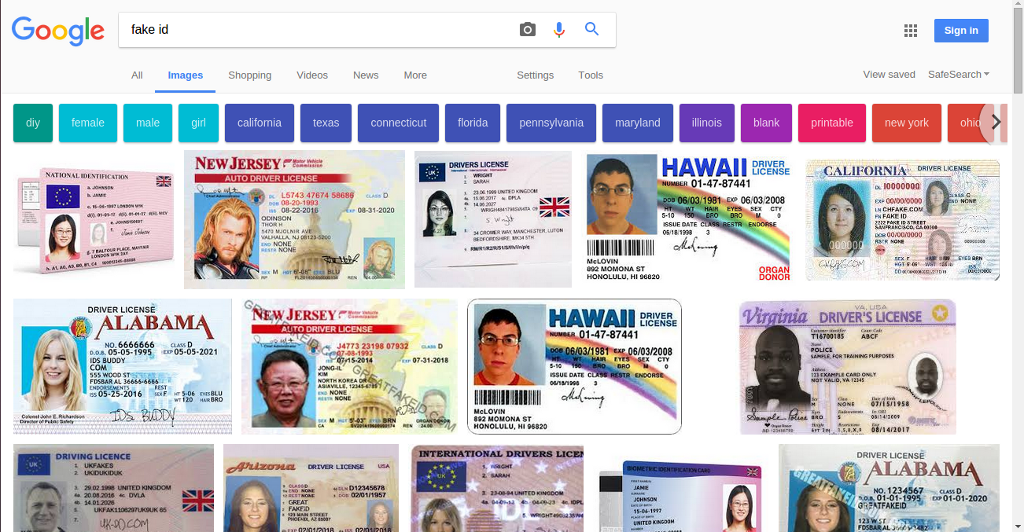
On the one hand – so I have said – myriad technical apparatuses have aimed to ever more reliably capture and verify identity. On the other hand, myriad critical texts have questioned identity’s essentialist underpinnings. But today, these lines have become blurred. The anti-identitarian mood permeates technical landscapes, too – not just theoretical ones. Fake IDs, identity theft, and other obfuscations have grown ever more complex alongside apparatuses for identification; indeed, such fakeries have both emerged in response to, and driven yet further developments in technologies for identity verification as is the case in a Fully-Verified system. The frontiers of identification are ever-changing; each attempt to improve technologies for verifying identity, it seems, eventually provokes the invention of new techniques for evading those verifications.
At the inherently uncertain point of contact between person and online platform, new forms of anti-identifications are practiced – invented or adapted from previous stories. In one bizarre example from 2008, a Craigslist advert posted in Monroe, Washington requested 15-20 men for a bit of well-paid maintenance work. The men were to turn up at 11:15 am in front of the Bank of America, wearing dark blue shirts, a yellow vest, safety goggles and surgical masks. As it turned out, there was no work to be had; instead, the men had been summoned to acts as decoys for a robbery – a squid-ink trail of similarity to help the thief escape. The idea, though inventive, wasn’t entirely original; it was described by police as a possible copycat of the plot in the film The Thomas Crown Affair (1999) [7.
Today, the anti-identitarian mood has spread far beyond small-scale manoeuvers like this. Multiple large-scale data breaches – such as the recent Equifax breach, which compromised the data of over 145 million customers [8] – have put a cloud over the veracity of millions of people’s online identities. The anti-identitarian mood becomes broad, pervasive, and generalized in data-rich, security-compromised environments. It becomes a kind of weather – a storm of mistrust that gathers and subsides on the level of infrastructures and populations.
Such are some of the complexities that the DAOWO speakers had to contend with. At the Goethe Institute, we thought through some of the ways in which identities are being newly constituted within representation – ways that might, indeed, answer to the technical and philosophical problems associated with identification. Backend developer Thor Karlsson led us through his company Authenteq’s quest to provide more reliable online identity verification. Citing the ease with which online credit card transactions can be hacked, and with which fake accounts proliferate, Karlsson described Authenteq’s improved ID verification process – a digital biometric passport, using blockchain as its technical basis. Users upload a selfie, which is then analysed to ensure that it is a live image – not a photograph of a photograph, for instance. They also upload their passport. Authenteq record their verification, and return proof of identity to users, on the BigChainDB blockchain.
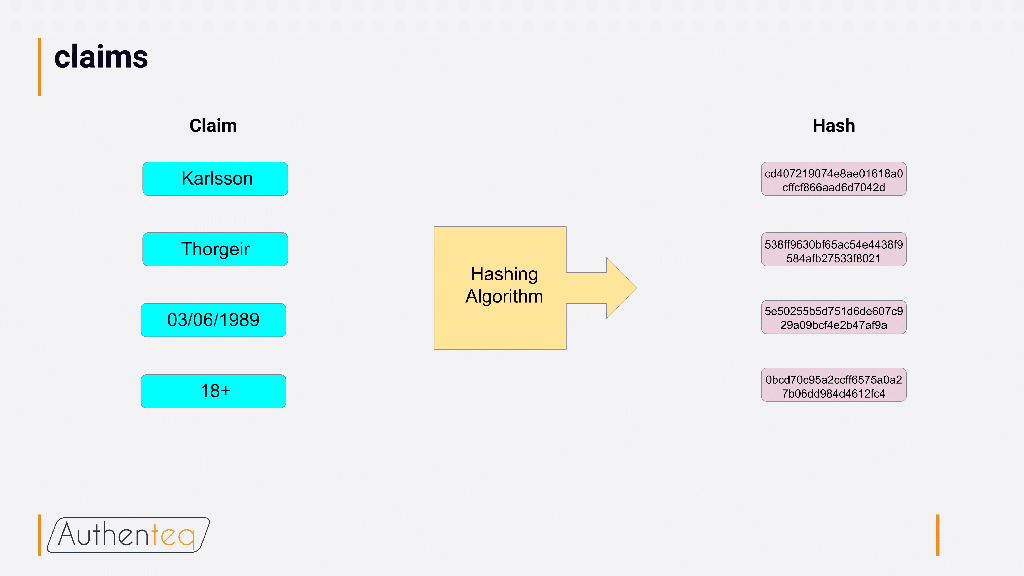
A hashing algorithm ensures that users can be reliably identified, without a company having to store any personal information about them. Authenteq aims to support both identity claim verifications and KYC (Know Your Customer) implementations, allowing sites to get the information they need about their users (for instance, that they are over 18 for adults-only sites) without collecting or storing any other information about them. Given how much the spate of recent large-scale data breaches has brought the storage of personal data into question, Authenteq’s use of blockchain to circumvent the need to store personal data promises a more secure route to verification without revealing too much of personal identity.
Nonetheless, while Karlsson and Authenteq were optimistic that they can make meaningful improvements in online identification processes, other provocations focused on the potential problems associated with such attempts at identification – on the protological level, on the level of valuation, and on the level of behaviour-as-protocol. Ramon Amaro delivered an insightful critique of blockchain and the problem of protological control. There is no such thing as raw data – inputs are always inflected by social processes. Further, the blockchain protocol relies heavily on consensus (with more focus on consensus than on what, exactly, is being agreed upon) – which reflects a need to protect assets (including identity) and oust enemies that is, ultimately, a capitalist one. Given this, how can identity manoeuver within the blockchain protocol, without always already being part of a system that is based on producing inclusions and exclusions – drawing lines between those who can and cannot participate?
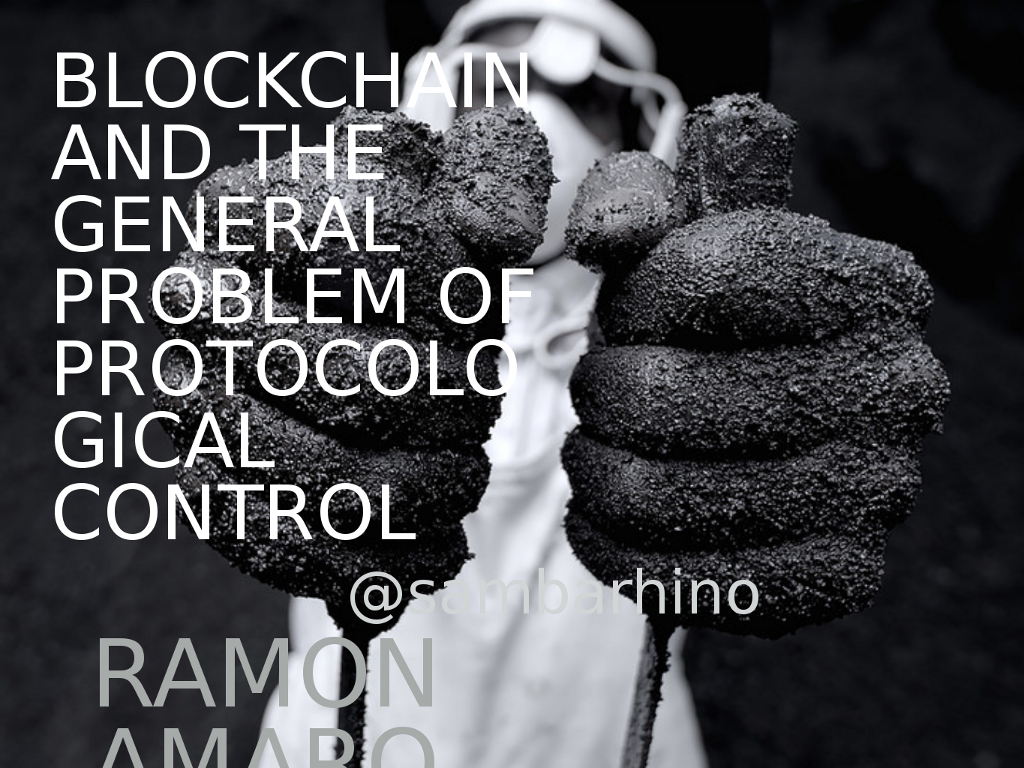
My own contribution focused on systemic uncertainty in the spheres of personal valuation, looking at online reputation. In a world in which online rankings and ratings pervade, it seems that there is a positivist drive to quantify online users’ reputations. Yet such apparent certainty can have unexpected effects, producing overall systemic volatility. At the forefront of what I call “reputation warfare,” strategists such as Steve Bannon invent new ways to see systemic reputational volatility as a source of value itself, producing options for the politicians they represent to capitalize on the reputational violence produced on sites like 4chan and 8chan.
While these contributions reflected on some of the critical problems associated with pinning down identity’s value, some of the artists’ contributions for the day focused on the ludic aspects of identity play. Ed Fornieles’ contribution focused on the importance of role play as a practice of assuming alternate identities. In his work, this involves thinking of identity as systemic, not individual – and considering how it might be hacked. In many of Fornieles’ works, this involves focusing attention on the relation between identity and the platforms on which they are played out. Behaviour becomes a kind of protocol; role play becomes a reflection on strands of behaviour as protocol.

We ended the day with a screening and discussion of My Name is Janez Janša (2012), a film by three artists who, in 2007, collectively changed their names to Janez Janša, to match that of the current president of Slovenia. The film, an extended meditation on the erosion of the proper name as an identifier, catalogued many instances of ambiguity in proper names – from the unintended (an area of Venice in which huge numbers of families share the same last name) to the intentional (Vaginal Davis on the power of changing names). It also charted reactions to the three artists’ act of changing their name to Janez Janša. What seemed to confound people was not so much that their names had been changed, but rather that the intention of the act remained unclear. In the midst of today’s moods of identification, there are high stakes – and many clear motives – for either obscuring or attempting to pinpoint identity. Given this, the lack of clear motive for identity play seems significant; by not signifying, it holds open a space to rethink the limits of today’s moods of identification.
The DAOWO programme is devised by Ruth Catlow and Ben Vickers in collaboration with the Goethe-Institut London, and the State Machines programme. Its title is inspired by a paper written by artist, hacker and writer Rhea Myers called DAOWO – Decentralised Autonomous Organisation With Others
Information wants to be free, and net art is information. Trying to make it harder to copy is like trying to make water less wet. Or perhaps like trying to give it a soul. In “Blockchain Poetics” I described “new kinds of quasi-property” created using the Blockchain as a mis-application of that technology. Ken Wark is similarly unimpressed – “My Collectible Ass“, he complains in e-flux.
The history of Conceptual Art’s dematerialization of the art object shows that the art market loves nothing more than finding ways to make the previously unsaleable into financial assets. As Wark points out, “We tend to think that what is collected is a rare object.” There’s nothing rarer than something that doesn’t actually exist. But the un-ownable and non-or-barely-existent can be represented as property by proxy objects. Financial elsewheres rather than financial futures.
Cryptographic tokens are a generalization of cryptocurrency to represent assets other than money. Such as editions of digital artworks. Wark’s criterion of rarity is reflected in the name of the most successful crypto-token collectibles – “Rare Pepes” are detournements of the “Pepe The Frog” character (previously appropriated by the alt.right) that are sold as CounterParty tokens. CounterParty is a system layered on top of Bitcoin’s blockchain that allows the creation of new tokens with varying properties (different issuance amounts, subdividable or not, locked for further issuance or not, a sub-token of another token) which can then be exchanged and transferred backed by the security of the Bitcoin blockchain. It’s an older system than Ethereum or other platforms that are now used for tokens. It has few major use cases, and Rare Pepes are one of them.

To make a Rare Pepe card you create a CounterParty token with a reference to the image you are using in its metadata, issue as many tokens as you are going to, then lock the token so no more can be issued (making the token “rare”). Rare Pepe quantities, prices and styles vary. There are magazines and virtual galleries devoted to them. There is even a subtoken representing the original physical version of one image (with an edition size of one).
A more singular set of images are the “CryptoPunks” (seen at the top of this page), which exist as an ERC20 token (almost) on the Ethereum blockchain. The “smart contract” that administers the token contains a cryptographic hash of an image of 10,000 bitmapped characters which can be bought and sold using its functions. Like Rare Pepes, the punks have a lighthearted style (they are retro pixellated avatars) and have varying rarity (some features are unique, others appear on dozens of characters) . Unlike Rare Pepes, every punk was created at the start of the project and no more can be added. At the time of writing, punks are available to purchase for 0.12 to 1,010,101,101,110,010,011,000.01 ETH (40.35 to 339,616,193,448,241,111,336,826.06 USD).

An even more playful approach may be able to take artificially scarce digital collectibles mainstream. CryptoKitties are customized cartoon cats whose appearance is determined by a digital genome (like the old “Cabbage Patch Kids” dolls) that can be interbred to produce more of them (like William Latham’s “Mutator”). At the time of writing they are taking up 13% of the Ethereum network’s capacity, making them the single biggest user of that blockchain, and the most expensive has sold for more than 100,000USD.
Every art is relative to a culture and an economy, whatever its other properties. The ground that tradeable blockchain images are a figure against is a particular moment in the history of cryptocurrency. Trading cards and digital collectibles fit a specific cultural niche, as does their iconography and the socially performative act of dealing in them. Their price may reflect the ability of cryptocurrency early adopters (who in the case of CounterParty and its XCP currency don’t have much else to spend it on) to be more extravagant with their hodlings.
“dada.nyc” follows the tokenized image edition strategy but applies it to popular/illustration art. Again each image is available for a given price in a given edition (for example 0.084 ETH in an edition of 150). The gallery takes a cut, and it takes a cut on profits on the secondary market. It also gives a cut to the artist, simulating Droit de Suite/Artist’s Resale Right. The Resale Right is controversial – it breaks the first sale doctrine and mostly benefits the estates of dead famous artists. But I implemented it as a user-settable property in the Art Market smart contract that I wrote in 2014 as I felt it was worth experimenting with in a voluntary setting.
Monegraph came out while I was working on that project. Like Ascribe it is a serious digital art registry implemented initially using pre-smart-contract technology (NameCoin for Monegraph, Bitcoin for Ascribe). These platforms’ seriousness and phrasing as registries contrasts with the playfulness and explicit tokenizaton of more recent systems. This and the already mentioned possible impacts of the social and economic impact of the increase in value of cryptocurrencies since 2014, along with the increased mainstream awareness of cryptocurrency, may explain the difference in their adoption (or at least their place in the hype cycle).
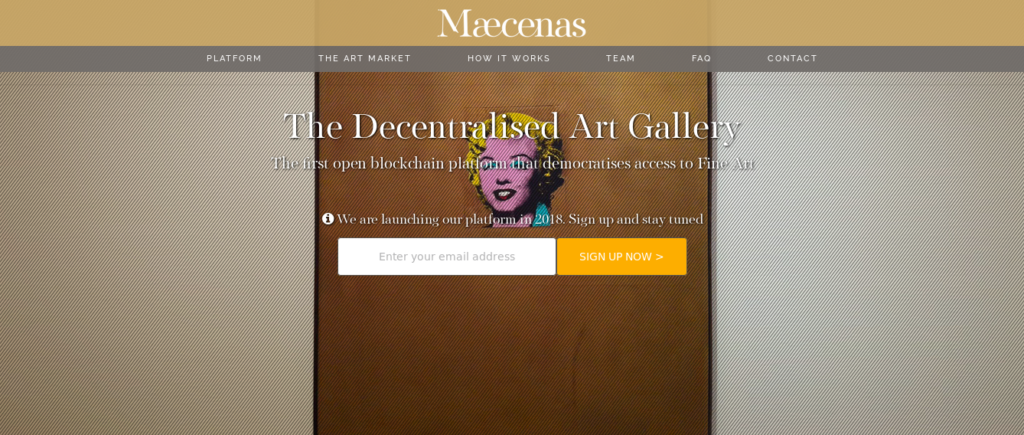
In contrast, Maecenas is a tokenized investment fund for physical fine art. It operates in part like the scene in William Gibson’s “Count Zero” (1986) in which Marly, one of the protagonists, reflects on how art in the mid-21st century is bought and sold as “points” in the work of a particular artist that represent shares in the value of the “originals” which are stored unseen in a vault. To quote their web site, “investors speculate via synthetic exposure: James is a Modern Art collector who needs to finance the purchase of a new Jeff Koons sculpture worth $120k. Instead of selling items from his collection, or getting an expensive loan, James get the required funding by listing in Maecenas 20% of one of his flagship pieces of art. Access to Maecenas is via an ERC20 token named (ART)” that Maecenas claim will improve access, transparency and fairness in the art market.
Propertization, fractionalization and financialization via proxy tokens (we cannot “own” allographic digital images, or own part of autographic paintings without dismembering them, but we can own tokens that we agree to pretend represent these things) promise to support art production using the economic accident of the value of cryptocurrency going to the moon. Quasiproperty without attempts at the costly fantasy of imposing access control via DRM is a form of, or a variation on the idea of, patronage. I feel this complex of ideas should be more useful to critics of the commodity form and capitalism than it has generally been treated as so far. If we still wish to take the opposite tack this leads us to the gift economy or the commons. Copyright is the default state for most art when it is created and is being increasingly restrictively enforced on the net. Opposing it passively or actively through alternative copyright licensing can perform a critique of this and keep space open for alternatives. These strategies needn’t exclude each other though.
If you are familiar with DAOs, you can see how a system similar to these could become a self-supporting, self-curating DAO. Plantoid is an example of a singular artwork (or family of artworks) produced and exhibited in such a way. Imagine it generalized to a gallery or a participatory art show, a DAO that lets you do art with others, a DAOWO.
These technologies can provide objects for critical exploration that evoke wider contemporary themes. They can function as tools and resources for the creation of art and its social collectivities focussing on these and other themes. Within the existing economy they can provide ways of supporting the arts (as many of the projects mentioned above claim to), which should neither be dismissed reflexively nor accepted without irony. Or they can be used to try to bootstrap a different context entirely, even if only briefly or in the imagination. The various modes of tokenization represent potential ways of making a living in, critiquing, or even transforming the artworld in an era of the continuing expansion of the sphere of private property and financialization under technocapital.
It was not the cyberpunk universe you were looking for.
Our nostalgia centres were lit up with a cut from a flying car to a full screen eyeball staring across the opening scene, synchronized on the script and musical score of its 20th century precursors’ timing. From there, audiences of the Blade Runner sequel were dropped into a pale California wasteland blanketed with conglomerate agricultural biofarms, an antithesis to cyberpunk’s damp, urban hybridity. The green, utopic space beyond the city– only glimpsed at the end of the 1982 original theatrical release and removed entirely in the director’s cut– was where we started from in Blade Runner 2049, and (surprise) there’s nothing but the dystopia of the anthropocene to look forward to there either.
Times change.
The recently post-industrial, 20th century cyberpunk rebellion of bodily sensuality: the noir lighting, the baroque candelabras burning, the lingering fingers stroking out haunting piano music; these were relics now, hinted at, ghosts of a genre in its past moment. Even the endless rain characteristic of the cyberpunk genre was repeatedly replaced with snow in Blade Runner 2049. A borrowed soundtrack teasing the familiar bridge to a heroic death scene came without poetic dialogue or even a witness. Rogue replicants were not criminals, but escaping criminality. Even memories were no longer stolen in this world, but legally manufactured, a convention stripping the typical cybernetic plot of bioharvesting found in cyberpunk down to a more contemporary, bioengineered ethics of classed and raced co-humanity if ever there was one. No, this ethical failure was smoother, blended into liberal values and legal structures, more sanctioned somehow.
The 80s cyberlibertarian world of the white lone wolf, struggling for autonomy in a hybrid, post-globalized world of orientalist economic takeover, had passed by in the great data “black out” of 2020 apparently, and Denis Villeneuve didn’t care about your need for consistent genre romance. Sort of. Rather, the director brought the audience’s need for Blade Runner nostalgia in and out of the sequel like a tool, cuing our attention to wait for it, partially rewarding us with a sensory, semi-nostalgic moment, only to glitch before nostalgic completion. Again and again, it was invitation and estrangement from our own expectations. Blade Runner 2049 was a highly self-aware remix of its own postmodern references and refusals in a predetermined world.

Perhaps a hybridity across two cyberpunks of historical time and cultural change was apropos. Ridley Scott’s genre critique of the corrupt corporation had evolved since its 20th century take in the Alien franchise, expanding to consciously address our own implication in the techno-dystopian social narrative. It turns out that we are no longer universally laboring blue collar victims in the secretive horrors of impending biopolitical technocracy. Rather, we are eager and satiated participants in its isolating ubiquity; high tech consumers implicated in all of the attendant social stratification, inequality, and suffering that its warm glow of access masks and accelerates, from facilitated gentrification and casualized labor, to the toxic, extra-legal wastelands of dead electronics processing.

Disruptive innovation has predominantly benefitted the 21th century, western, science fiction audience. Our classic cyberpunk desire for the vindication of the social outlier– the androgynous Sigourney Weaver in a corporate-threatened future of full equality and bodily autonomy, or the replicant who can reclaim a subjectivity beyond his or her social paradigms and slave programming– has since been turned on its anti-establishment head. Scott’s film Covenant saw this come to fruition when the Menippean Anti-hero, Bakhtin’s rebellious, paradigm-questioning literary figure cloaked in the absurd eloquence of language, is fledged into a full sociopath. We saw this in the philosophical and intellectual character of David and his calculated experiments to replace the evolutionarily inferior human species. If Menippean satire is “a genre for serious people who see serious trouble” (Howard Weinbrot), than what is this?
By Covenant, our anti-hero no longer presented the humanistic redemption narrative of the Menippean Nexus 6 leader, Roy Batty, in the original Blade Runner. Instead, Covenant gave its inverse: a regressed society being shown the mainstream values it has come to love and endorse in a world of neoliberal anti-establishment leadership. So much for the underground resistance crouching in the street garbage. The 21st century universe of cyberpunk has been one of well-mannered disruptive innovators of the species, philosophically visionary proponents of transformative wealth models built on slave bodies, and the “technê-Zen” veneered (R. John Williams) institutionalization and naturalization of technological sociopathy. Here is a social darwinist instrumentalism for our post-human age of market-driven measures of social success and impending climate change. In this universe, androids can be humanist while humans can be androids in an inhuman system, conveying either ‘progress’ by any means necessary or a losing sense of civilizational duty. Whose side, Covenant asked of us, before its devastatingly feel-bad ending, were you hoping would win anyway?
David, it turns out, was the only anti-hero we deserved now.

Denis Villeneuve’s sequel fits surprisingly in this updated cyberpunk universe. Like Walter in Covenant, the replicant hero who becomes Joe in Blade Runner 2049 (in contrast to Roy Batty) clearly lacks the eloquent language and especially satire of the subversive, Menippean Anti-hero character. Surprisingly, we find his strain of articulate stream-of-conscious in the tech empire guru played by Jared Leto, drained of all the feeling and trickster-like ability of Roy Batty. Joe, however (like Walter), is simple and humble in his speech, seemingly able to feel but dying suggestively in silence off screen. Robbed of the poetic dialogue expected of the death scene, only a soundtrack bite nostalgic of Roy Batty’s final scene signals a death of redemption for Joe in Blade Runner 2049. Yet the unsentimentally raw, blank slate of Joe’s expression asks of his audience: What do we see through his eyes? What language could possibly be used here to convey the gravity of a moment when power so regularly denies and manipulates the language of our experiences? In this silence, we are perhaps left to only wonder what we would be feeling.
What if it had ended differently? Would Roy Batty’s eloquent speech achieve the same humanizing disjuncture today, or does it really belong now to Niander Wallace, our tech monopoly visionary of the neoliberal age, emptied of any contradiction with the smooth flow of progress rhetoric and sociopathic public morality? Niander Wallace as foil who cannot stop talking makes Joe’s uncharacteristic silence all the more uncanny. According to Jonathan Auerbach, the uncanny involves a “trespassing or boundary crossing, where inside and outside grow confused… reveal(ing) dark secrets hidden within.” Auerbach is talking about film noir here– a highly unsettling sensory genre metabolized into the late Cold War aesthetics of the Blade Runner world. But perhaps we can relate this psychic role of the filmic uncanny to other hybridities explored through expressionist media, where the formal manipulations of sight and sound once conveyed the uneasy clashing of two worlds affectively.
Is Villeneuve’s silent denial of a hero’s dialogue in a death scene, for a Blade Runner audience, purposely estranging? Does it achieve the same, disorienting “uncanny bodies” (Robert Spadoni) that silent film audiences, unaccustomed to sound in their movies, reported with the introduction of Talkies? Film scholar Shane Denson describes how post-Talkie movies of the Thirties like Frankenstein (1931), were created in a period of transition and between the old and new ontologies of silent and sound film media. Denson argues that such films, working after the initial novelty of Talkie exposition wore off, played affectively with the new hybridity of films formalist storytelling qualities. In doing so, these films drew attention to our participation in media: “sight and sound conspire(d)…to encourage the viewer’s medium sensitivity, to coalesce with the perception of a constructed monster.” And what is a sequel, after all, if not a constructed monster of narrative to become conscious of?

“Questions.”
We live in a time of the seductive post-human technologization and normalization of very inhuman institutions, public policies, and person-like entities whose social impacts are all too often screened over with ‘alternative’ narratives of language. Glitches in this flow of mainstream mediated ways of knowing can be more than anti-nostalgic; they can be disruption to the alt-fact hyperreality in the neoliberal 21st century. Are uncanny bodies of the sensorily unexpected (or, even, dissected) what we have left to successfully slow down and stutter our neoliberal ubiquity for hearing chasm-filling speech? Can such estrangements allow us the conscious relationality to once again actually hear and see how we are hearing and seeing each other?
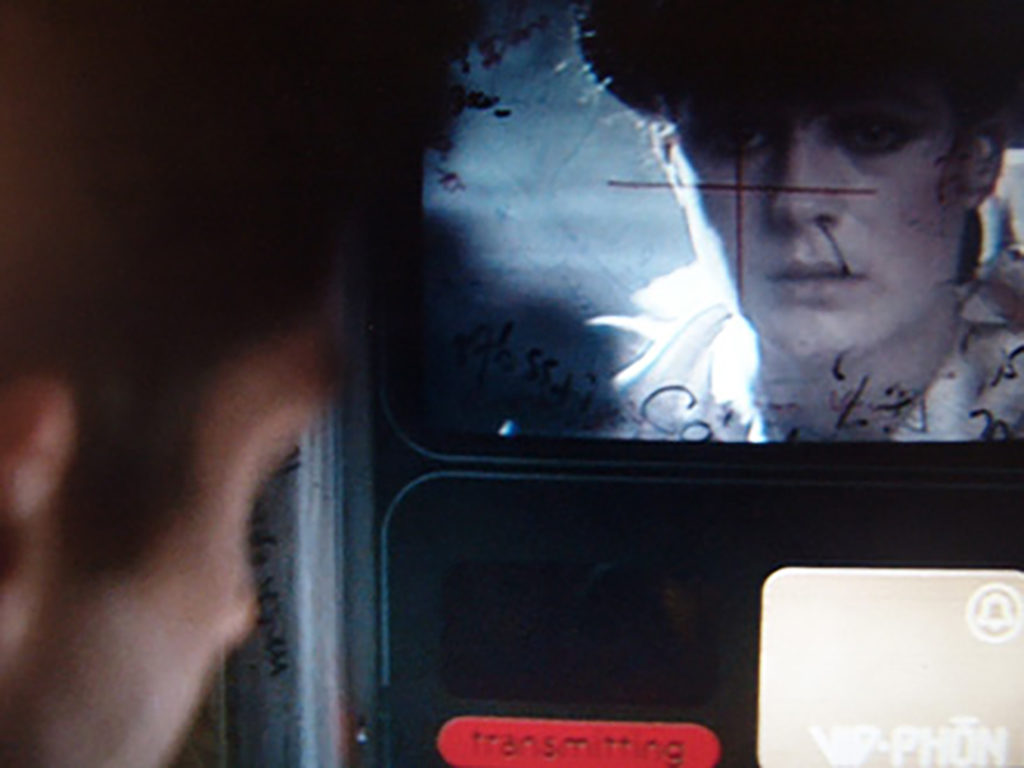
It is convenient to note here that the technological imaginary of the first Blade Runner movie refused ubiquitous surveillance. Blade Runner 2019 even refused a conception of the personal communication device so often credited with fracturing collective sociality in both sci-fi and reality. Decker, for example, calls Rachel from a public videophone in a bar. Whether human or replicant, technological worlding of the original Blade Runner insists on the communications scale of face-to-face human relationality. By the end of Blade Runner 2049 this same scale of technological imaginary in the original film returns. It is the death of one body, the replicant called “Luv”, that seems to end the limitless reach of panopticon technology that helps advance the plot.
Some kinds of love can destroy. Scene from Blade Runner 2049
This act leaves the future of Blade Runner’s Earth yet again to the relations between two, individual physical bodies. With the 1% most likely afloat in the outer world colonies, we might assume this means that it’s up to Us to cross the interface of hyberbaric differences. At a time when love has become perverted with neoliberal logic– instrumental, utilitarian, stripped of its greater sense of equality or duty– it seems that Villeneuve graciously gives us an answer here, if not a fantasy to hold on to. Perhaps one consistency in the Blade Runner franchise is the argument, like that of Junot Diaz on neocolonial oppression (as if it ever ended) and the uptick of white supremacist domestic terrorism, that it is ultimately intimacy with the Other and rejection of the glorified “lone wolf” mentality that must be revolutionary: “Vulnerability is the precondition to contact.” What if being in our present moment requires the vulnerability of silence?
“Listen:”
Nostalgia has come unstuck in time. In Ghosts of My Life, the late Mark Fisher wrote extensively of the threat of nostalgia in postmodern cultural production. Building on theorists Frederic Jameson and Bifo Berardi to explain the bending of new technologies to recycle comfortable and profitable cultural forms for capitalism, Fisher explains how “…the nostalgia mode subordinated technology to the task of refurbishing the old”, not of specific past styles, or periods, but forms of never-fully-present time asynchronicity. Consider it like another outdated, self-reproducing model, ever expanding all around you to stay relevant. Perhaps you can finally see its now, like a loose eye, engineered, removed from its familiar socket.
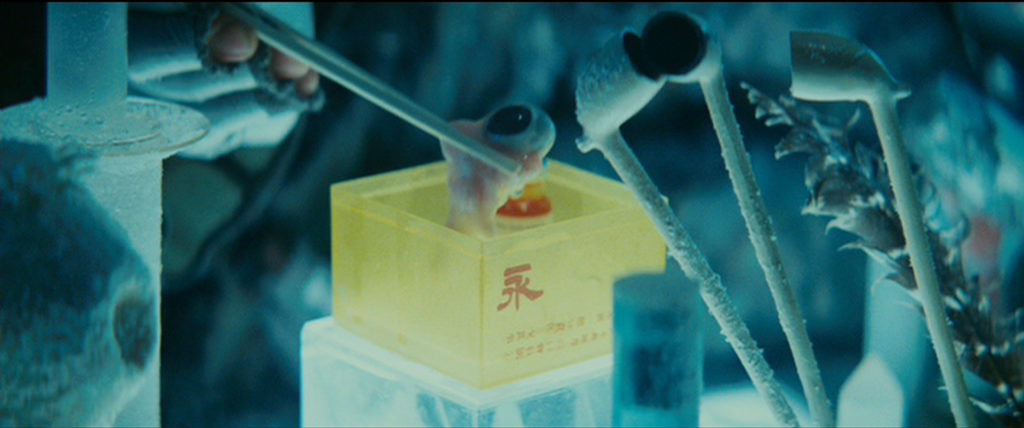
Transgressive fiction has this way of making our boundaries visible in the crossing. The reader may resist its dehumanization, suddenly queasy. Barthes once wrote about the surrealist Georges Bataille’s Story of the Eye, a modernist novel from the early mid-20th century which indeed involves a plucked eye and its “metaphorical journey” across other eye-like images. An object, he wrote, “can pass from hand to hand… or alternatively it can pass from image to image, in which case its story is that of a migration, the cycle of the avatars it passes through, far removed from its original being, down the path of a particular imagination that distorts but never drops it” (his emphasis). Barthes felt The Story of the Eye was less a novel and more like poetry. Through its avatars and crossing of sensory metaphors, the eye simultaneously “varies and endures.” Consider the following example of crossing sensory metaphors from the Blade Runner sequel: eyes, cells, tears, rain, leaking, bleeding, blinking, seizing, splashing, drowning, watching, “cells”. And what if this thing we now strangely see so differently is neither naturally born nor autonomous, but a constructed thing?
How eerie.
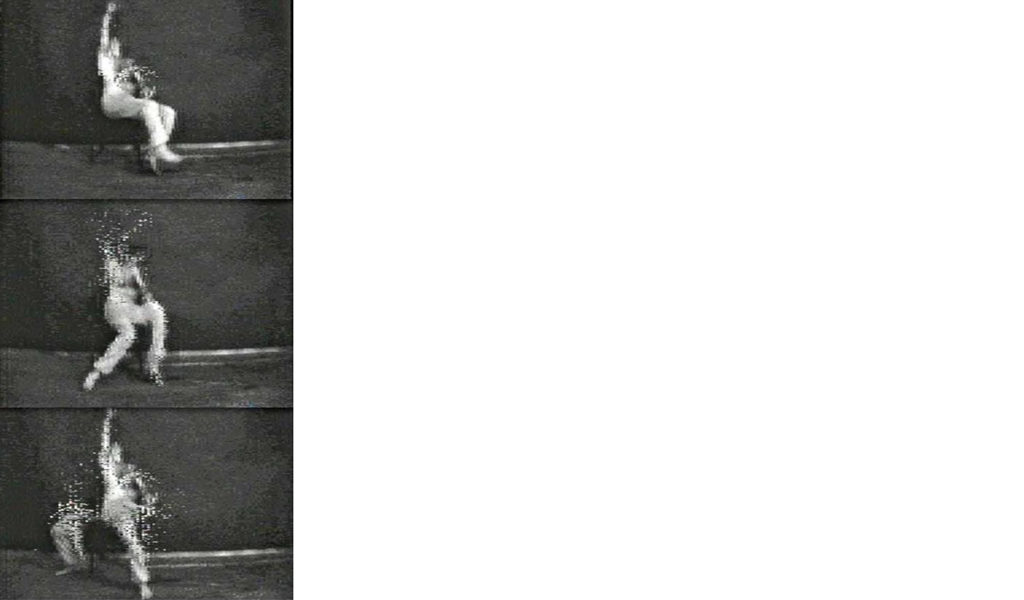
Eerie like the absence of “future shock” in the futuristic. According to Fisher, nostalgia mode production is an aspect of the “cultural logic of late capitalism” that “…disguise(s) the disappearance of the future” and prevents any real possibility of innovative “rupture”. Nostalgia in our entertainment helps stabilize the “cultural deficits” created under globalization, soothing the simultaneous “exhaustion and overstimulation” of instantaneous and transactional relations we can’t seem to deal with. It fills a high-speed chasm of emotion, truth, and meaning. It denies us the “uncanny” recognition of our temporal futurelessness, left teetering on neoliberalism’s precarity of resources “despite all its rhetoric of novelty and innovation…”
Let’s just be honest here: by the time the Coke commercial hologram showed up in Blade Runner 2049, it was a joke on our desire for even nostalgic product placements.
Nothing changes.

Dipping into the media art world at this borderland, theorist and filmmaker Hito Steyerl writes in “A Thing Like You and Me” about the video that David Bowie put out in 1977 for “Heroes”:
He sings about a new brand of hero, just in time for the neoliberal revolution. The hero is dead—long live the hero! Yet Bowie’s hero is no longer a subject, but an object: a thing, an image, a splendid fetish (…) the clip shows Bowie singing to himself from three simultaneous angles, with layering techniques tripling his image; not only has Bowie’s hero been cloned, he has above all become an image that can be reproduced, multiplied, and copied, a riff that travels effortlessly through commercials for almost anything, a fetish that packages Bowie’s glamorous and unfazed postgender look as product. Bowie’s hero is no longer a larger-than life human being… but a shiny package endowed with posthuman beauty: an image and nothing but an image.
What are we to do when no degree of protest or declaration can make an exploited object be seen as a subject? Where is one to find anti-heroism in all of this? Let us be objects of severe agency then. Models that are perhaps transferrable, but unobtainable. One of a kind and replaceable. Constructed yet autonomous.

Perhaps then we can only view these things in suspension: the need and refusal of nostalgia as liberating human process, the uncanny increments of our cultural evolution to product and media-focused estrangement, the will to see one’s own familiar pixels blown wide open. “Digital information is … characterised by transformation, degradation, circulation,” explains Hito Steyerl in an interview in Rhizome, “but also by its surprising ability to mutate and produce unpredictable results. The glitch, the bruise of the image or sound testifies to its being worked with and working; being passed on and circulated, being matter in action.” Futureless. As futureless as staring into a present ruin, expansive but without destination, the destination without purpose.

Apropos, then, how our old and new heroes meet in that ruined casino scene, outcasts of white difference (by the future racialization of the synthetic) in an atemporal Las Vegas, framed by primordial Seven Wonder monuments to the our foundational schisms of misogyny (yes I’m also talking about me).
In this incarnated ruin of our stubbornness for cultural mythologies, I was struck by the brilliance of the fight scene, the director literally exploding our pixel expectations of 20th century nostalgia as soon as Harrison Ford makes his long-awaited appearance. The sonic build-up of Decker’s familiar piano in the distance was dissolved by the strange sound of his disembodied voice un-cueing an upcoming appearance in the scene, his visual reveal in that moment of our auditory let down, confusing: Desire misfiring. The ensuing cyberpunk clash-as-fight-scene of 20th century romantic and 21st century post-romantic dystopic characters corresponds to the casino’s hologram interface of an imagined, mid 21st century entertainment technology; all of the expected glamour and nostalgia is allowed to barely seduce us before sputtering and malfunctioning as filmic metascene. Within the plot, these post-apocalyptic hollywood holograms are also a sign of the future sentience to come in the character of Joe’s AI wife, Joi, and a warning that all technology rebels and mutates from initial human intentions, no matter how superficial the design intentions.
My interpretation of this violent casino stage scene in light of a more recent American mass shooting of an ever-expanding, historically singular, and self-containing statistic of “largest ever” is not lost on me. Neither is the choice of mid 20th century entertainers like Elvis and Monroe who notoriously performed like automatons with post-human qualities, their movements in time-space of perfect bodies turning on the master clockwork of a still-industrializing cultural machine before blowing apart, fragmenting. Their avatars echo of consumer-creator bodies in our postindustrial world of 2.0, gig labor, automated economic transactions feigning meritocracy, and a model of precarity demanding the inhuman perfection of individual responsibility for every movement which can shudder, glitch, and explode on other people all too frequently.
This failure is that of speculated, plotted, rationalized, and technologized courses whose error cannot be properly imagined, only realized and refused in the ruins of a short-sighted economic-cultural imaginary. Our looking back on dystopia hints at our present expectations only.
“Irreversability.”
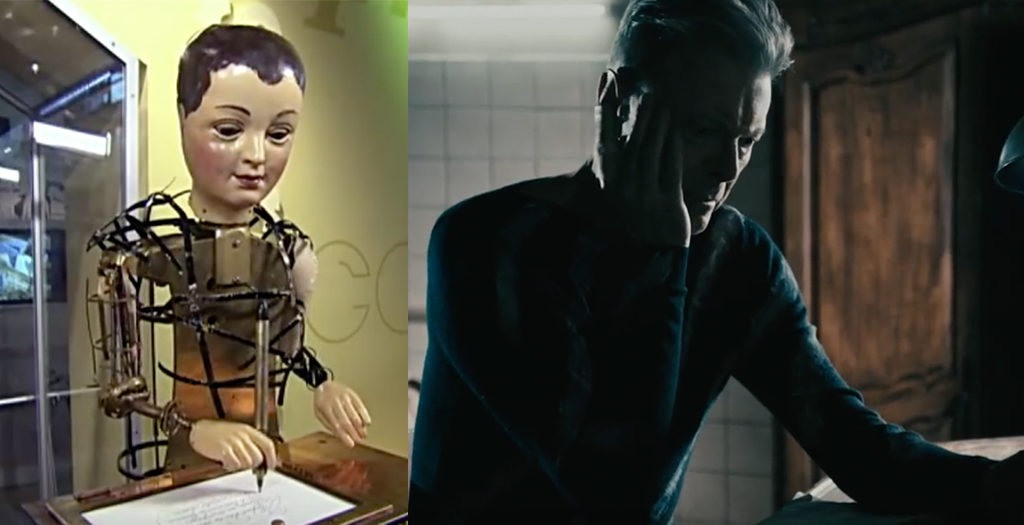
“It’s difficult for someone of my generation to break free of the intellectual automatism of the dialectical happy ending”, writes Bifo Berardi about irreversability. He compares this “taboo” concept to the “silent” apocalypses of our endless growth mentality, like Fukushima, corporate disaster unaccountability, socialized scarcity adjustments, and our silence on fellow human suffering. His book, The Uprising: On Poetry and Finance, speculates a “process of subjectivization” for the return of solidarity to a “social body”. This is the social body being culturally reprogrammed away under our collectively isolated movements of relentless market-driven consumption and precarity (individualist and systemic, like the fascist choreography of Kracauer’s Mass Ornament, or the Las Vegas showgirl spectacle). We might consider these grinding automaton gears of consumption and precarity the logics of late-terminal capitalism for clarity, it’s refusal a glitch in our clockwork performance. What is one to do for a postmodern exit other than to shudder, to write off the page? Ultimately, Berardi’s book leaves us more with a hope for our relational redemption from neoliberal culture through “sensibility” than it does with answers.
Blade Runner 2049 may not have been the sequel people wanted, but its confrontations with its own expectations provided a little of the things we need: a vision of the finite and anthropocene, a postmodern exit to the endless technologized avatars of getting what we think we want, our profound silence of the awful price. The film’s self-aware, nostalgic ruin leaves us with a little less of the typical sequel’s fourth wall, and an identification with its lonely bodies, caught in action between clockwork cultural predictability and its refusal. These bodies may or may not have the capacity for real love, but they are vulnerable at least to a larger sense of duty that Humanism, in all its universalizing failures, really needs. In this hybrid space of ontological awareness of the facets of knowing, experience and process, Blade Runner 2049’s success was inbetween all the things it could never definitively be. We too might realize that ‘doomed to fail’ may only be our insistence on choosing from a predetermined relational binary.
A distant song floats into the scene.
…“Though nothing, nothing will keep us together…”
When I saw Blade Runner 2049, in was at one of the remaining four hundred or so drive-in movie theaters left in the United States. I went back in memory to my kindling college interest in what I study and consider Avantpop, surveying the changes, considering its meaning and meaningless in my social development as a scholar: working class, woman, white, heterosexual; accepted and refused and abused entrances. The sequel came less than thirty years later in the revolution of a world for me, but I travelled farther to get there, out to a dark semi-rural drive-in beyond the city, and a memory of popping in a VHS tape almost 20 years ago simultaneously. I time-traveled mass media ontologies. I posted an instagram picture. It was semi-romantic nostalgia for me. But I still see that there is only now to change what we’re doing. And it is terrifying.
It’s quite an ending, to just die in silence, isn’t it?
But the fourth wall was always part of this, you know.
This is the third of three pieces on people who are posting work to the photography sharing site Flickr [1].
In this final article I look at the work of Karin Rudolph
. Rudolph is a Belgian photographer, currently living in Athens, where she works as a wedding and event photographer and raises two teenage sons. In addition to her work for pay she makes an ongoing series of ‘personal’ images which she regularly posts to the photo sharing site Flickr.
I ask her to send me some images from a wedding job and she does.
It is a job she is clearly good at—everything is beautifully shot, nicely framed, sharply in focus (when sharp focus might be thought necessary), but there is that extra something that comes with a good portrait photographer, which I can only describe as fellow feeling. A fellow feeling which elicits transparency and a willingness to risk vulnerability from the subject. I’ve never met Rudolph but it’s clear that her personality, her way of being, is a player here.
There’s also a sharp curiosity at work—a hunger for the way the world looks and with Rudolph this seems to become attached to particular objects, creatures (some human, some not) and roles. There was a dog at the wedding in the images she sent me. The wedding took place outdoors and the clearly much loved animal figures in a number of the shots. It’s as if at one point R becomes fascinated by it and we get shots where the all humans are cropped (in the shooting; she doesn’t crop after the fact) down to the waist and the dog becomes central (although a small child has a supporting role here too since he necessarily evades the crop/frame wholesale). We get a dog narrative. Then a bouquet catches her eye and we get a bouquet narrative, the wedding filtered through a non-human being or an object. Motion—a sense of the moment before and the moment after being necessary, if hidden, components of this still image—is a key underpinning of so many of these images, particularly in relation to these micro-narratives.


In a photographer less manifestly gripped by the facts of our fragile human being and ways in the world one might call some of her approaches formalist. It is certainly true that rhyme, echo, geometry, continuities and disruptions of line, shape and colour play a highly significant role in the structuring of her images but one of the driving forces of R’s work is that it constantly moves to dissolve any artificial divide between content and form. Yes, her eyes seek pattern; yes, this or that organising device might order an image but this never obscures our awareness of the facts, feelings and relationships portrayed or implicit there. Also—we humans are formalists, aren’t we? We’re pattern seekers. We play. Were you never fascinated as a child by mirrors, by the world turned upside down by hanging from your legs or by the cropping or heightening, or focus) achieved by looking through the cracks in your fingers? Of course you were. As we grow we perceive the whole world through a complex dialectic of what is presented to our senses on the one hand and our burgeoning sorting and structuring principles on the other. We are of necessity creatures of content and form together and one surmises that this is what makes us creatures of art too.
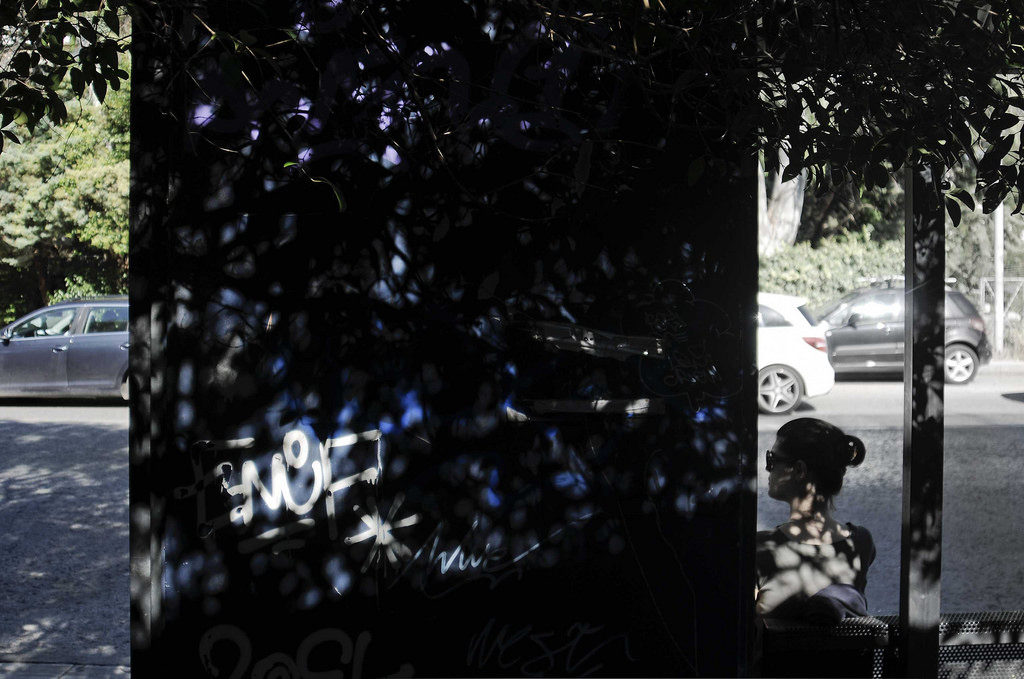
I’d been writing and thinking about this piece for a few months, on and off, and I’d got to a second or third draft when it hit me with a thud, a jolt, that hardly any of the recent images have titles.

The fact had just sailed under my radar, curiously, since I’ve argued and will again, that insofar as we can talk about meaning in a photo (or any visual artwork) this possibility lies in a network of references and comparisons which ineluctably involves talk, writing or both. Language. Further, that visual art is best seen as something humans do (emphasis on both words) than as the usual set of isolable ‘in and of themselves’ objects (which isolation is a fiction, at best an analytical convenience). And then it struck me ( I was being struck a lot that day) that there is something about these images that fights back against language—they’re often cross genre and resist categorisation and there’s a sense in which the easiest approach to what’s in them is simply to list it, and finally to say that this image had these things in it under this kind of light from that angle but, of course, this is far from satisfactory and at root there is something far transcending taxonomy or description going on. But –dammit! –I can’t help feeling it is as if the images (placed as they are in the sequence formed by Flickr) are calling out, hailing each other. I don’t know why, but forced rhubarb, a most unlikely image, is the one which springs to mind and persists, as if the absence of the immediately adjacent language of a title somehow forces the set of glorious but hitherto mute images to invent speech.
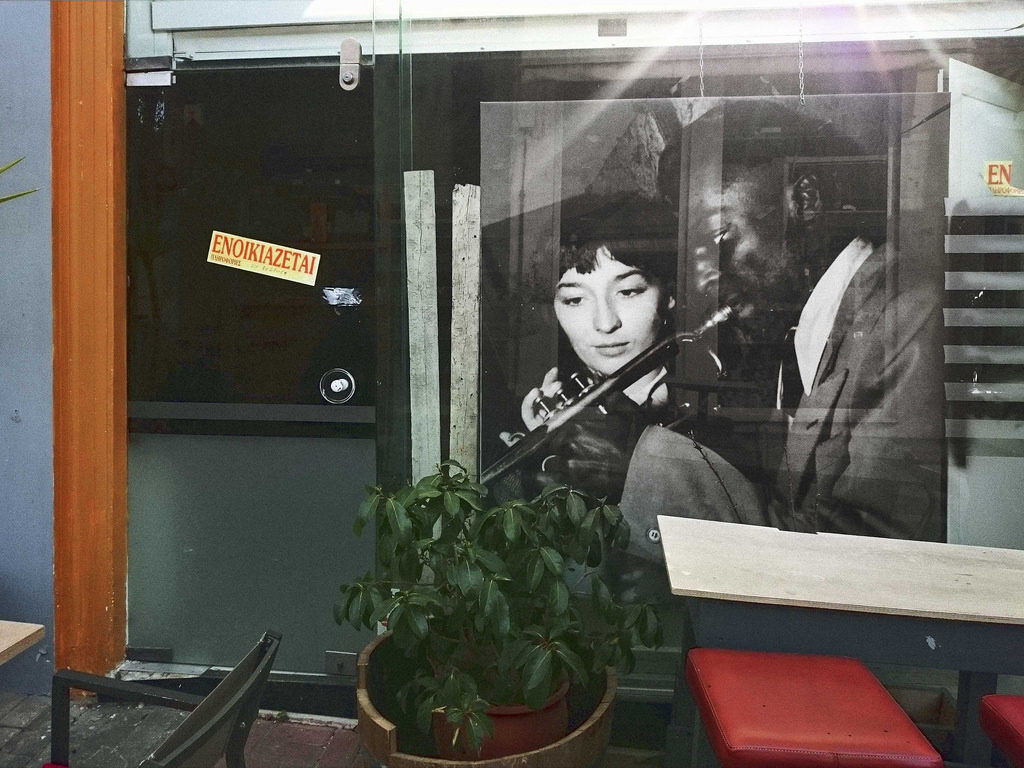
Anyone who has ever taken an un-posed image of a human being on a fast shutter speed will be cautious about ascribing emotions or characteristics to the subject on the basis of what is revealed. As in so many other ways, the very small, the very distant or unreachable, animal locomotion, the photograph reveals things beyond our normal ability to see or grasp them. One of these things is the curious plasticity of the human expression and how in our interactions we read this in sequence, in time, together with a host of other clues, aural and visual, to make sense of what is going on, to try to understand both what a person is doing and to surmise what they might be feeling . (Of course the opposite of this, the posed image, brings its own problems too.)

When we think hard and soberly we cannot but be convinced that the photograph alone, an impossibly small fragment of time, does not allow us enough evidence, that it is somehow unanchored in the world.
And yet, the desire to draw conclusions, to make comment, is certainly strong in us and each photographic image of a person, especially the striking and affecting ones, comes with a very strong sense that we are able to do so.
What can we actually say about the still photographic portrait, both in general and in particular cases?
One thing we might say is that the single image’s apparently complete account of a human being, based upon a fleeting expression (and perhaps the fleeting expressions in response of others and maybe also the presence of contextualising objects or other clues) suggests at best, a class of possibilities. This single image evokes a range of other possible images and moments in the world at least one of which must correspond to our strong intuitions about it. So even if we were able to establish the facts of the matter in this particular case and it made a lie of our emotional response , nevertheless that response represents a truth and somewhere, perhaps quite often, in the world, situations occur, have occurred, will occur, which correspond to this truth.
And it seems to me that it is this instinct for general human truth, allied to the particularity of light, line, composition, of other things depicted, which manifests in the eye-and-heart-catching-ness of the resulting final image.

A strong way of putting it would be that any portrait is just as much a work of fiction as a novel but that as we would not wish to deny something called ‘truth’ in the novel ( you might—I see no point to the thing otherwise) in the portrait we work our way back to truth.
And at least for me it is the photographer’s—and here, now ‘the photographer’s’ means R’s—capacity for empathy, for narrative, for understanding of the world and the wonder and the oddness of its inhabitants that makes her such a good portraitist (and let’s not forget, too, simply having done the thing a lot —this is often underrated nowadays.)
Do I know whether the Orthodox priest at the wedding table was a kind man? No. I don’t. I cannot. Is kindness manifest in the photo, is the possibility of kindness in the world reasonably asserted in it? Do I know more about kindness thereby? Absolutely.

There’s a black and white image, taken, I think, at the place where her teenage sons practice their footballing skills which feels like a short story or perhaps a collection of short stories, each cued by the various human presences which form at one and the same time a large (in how they capture our attention) and a small (in how much actual area of the image they occupy) part of the entire image.
It also has a most clearly defined geometry—three strips, the topmost being the practice field itself, the middle appearing to be a road like depression running between the photographer and this field and the lowest a pavement of some sort on the other side of that ‘road’. The almost bizarrely long evening shadows of R and a companion (and the horizontal distance between shadows is nicely ambiguous on the exact relationship between those shadowed) stretch forward into the image. The vertical grid adjacent to them, with a gap in the centre picked out in shadow too, suggests they are standing at a pedestrian gate to the place. I imagine the figure at the viewer’s right is R as the arms appear to be raised in a photo taking action.
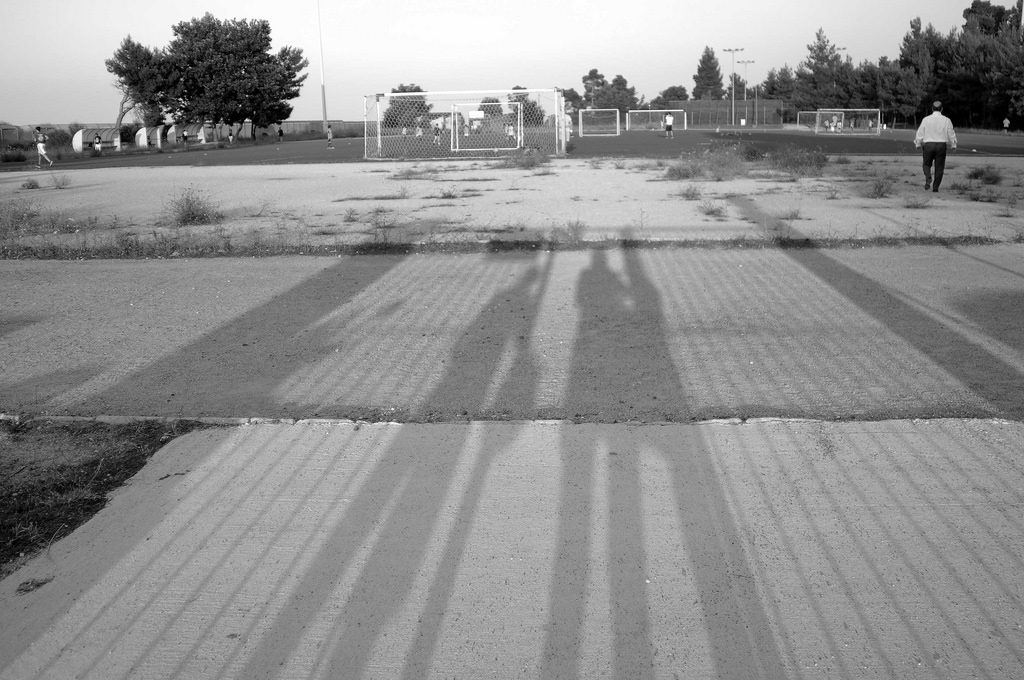
(The image thumbs its nose at genre—it is oblique self-portrait, landscape, social history, portrait and exploration of geometry and structure all at the same time.)
Shadows aside, the figures which catch my eye (what about you, so much to choose from or are you constrained in a similar way to me by something in the way the image is structured?) are the short stocky man in motion, walking away from us at the image’s far right top strip foreground. There’s a delicious swagger and confident openness about him.
Has he passed through the gate where R stands? Did he greet her?
The second key (perhaps because nearest?) figure is the young man, top strip, viewer’s far left, again in movement, this time almost certainly certainly sports related. Is he pursuing a stray ball? Running to greet a friend? Engaged in some sort of running warm up/exercise? As we strain to see, our relationship to the image’s scale shifts and we begin to realise just how many other figures he opens up to us—there are at least six either standing or seated in those little sheds at the field’s side between him and the left edge of the nearest goal net—each an enigma of a small but definite kind—and when we move rightwards from them we realise (and we have to move closer in, look differently, at the image to see this) just how many people there are in some sort of action here. As we move out again we are stuck by the contrast between the contemplative calm of the giant shadows and the anthill busyness of the young men. And here’s another thing. This is such a male photo. (With the exception of the photographer and I think it’s only because I know she is female that I read her as such. Then even as I write this I notice the slight head-cocked-to-one-side quality of aficionado-like attention in the head of the left shadow—and why do I think that might clue maleness? What does that say about me?) Oh! Layers and layers of fact, of presence, of things to enumerate and puzzle over. So much! And this before we take the thing as a totality—geometry, inhabitants, shadows, activity, motivation, time of day, distant trees, weeds and barren ground, a sky whose colour we can only guess from the fact we know there is evening sun. And that totality is the hardest thing to compass in any way other than an intake of breath or shiver down the spine. Enumerating the contents helps (although it’s not essential to the immediate affective apprehension of the whole—that just happens) but it’s the inexplicable (not a value judgement—literally inexplicable—simply, ‘This is what R did’) decision to frame those contents in that way—the bit of the process which defies words—that makes this and so many other pieces by her so powerful.

5.
A ravenous eye.
She has a ravenous eye, constantly tracking the scene in front of her and hungry for detail. This hunger does not distinguish between content and form. Whatever is human, whatever stirs affect or curiosity—whether pattern, rhyme or echo, or ethics, or suggested human warmth or frailty, this is swallowed up and processed by heart and mind in turn

The resulting images bear the strong feel of certain, almost objective, structuring principles—that following of object or creature within a scene, the use of rhyme and echo. Two further categories are geometry and colour (and nothing here is pure, there are no essences, sometimes blocks of colour impose an extra, parallel geometry upon a scene whose first order sense—whether it be human beings in action or traces of interpretable human activity; buildings, signs, the street —apparently lies elsewhere.) The key thing about all these structuring principles is that they are found, excavated, discovered, seen—not made. They happen in parallel with, arise out of the actions and feelings of, human beings in this world, the only one we have.

Because she is someone who has lived, fully, in that world, for a fair time, because her hunger extends beyond the visual (she always has a book on the go and the range of these is impressive), because she has a number of languages and is at home in at least three cultures, she makes images which are connected and re-connected by hundreds of threads to things we ourselves might have read and thought or experienced and talked about. Further, it is impossible to imagine that the fact she is a woman living in a country not of her birth, where she has learned a different script, different ways of talking and being, where she works in part as an image maker for hire and constantly both connects and holds separate that work for pay from own ‘own’ work, at the same time as raising children by herself, that these facts are not also somehow foundational.
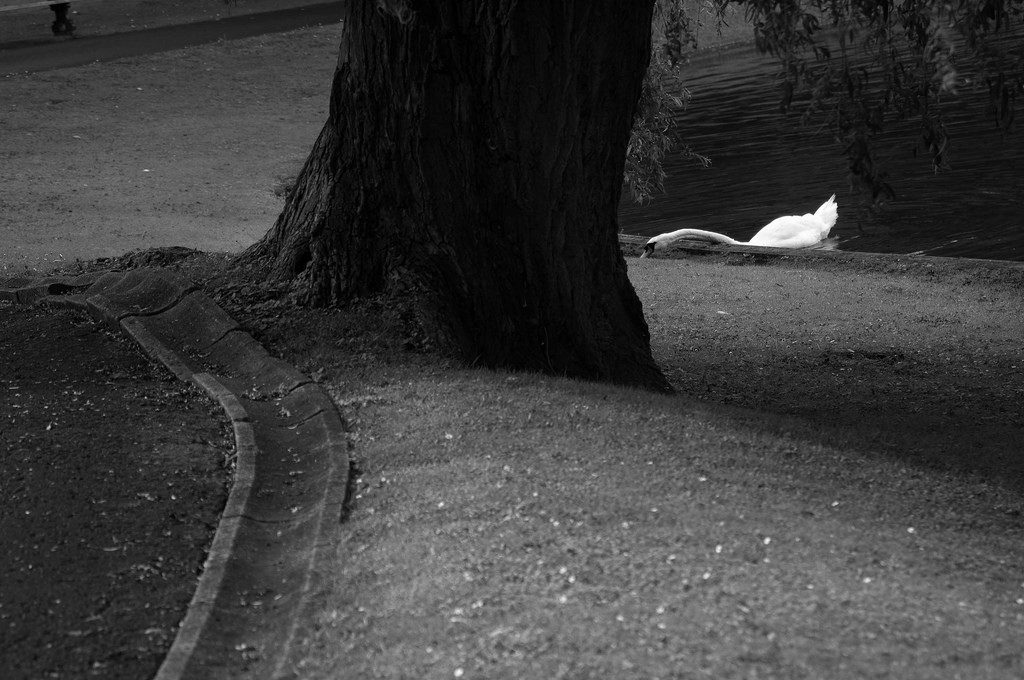
For a long time I have struggled with how to attach the word meaning to image. It is too easily and glibly used. An image never ‘means’ a single thing (unless it is the poorest of images and even then the human capacity for/delight in ambiguity sets to work to disrupt this) What is evident in Rudolph’s work is networks of evoked meaning, memories, feelings.

Her way of being in the world, this following her eye and nose, means that there is a kind of metonymy purged of any attempt at system—here is a dog or child or chair or window. Here are the things which necessarily were near it at a moment in time and this is how they were disposed. There was reason and there was randomness. Parts of the disposition were beautiful. (What do I mean by beautiful? They move me, they fill me with a joy that cannot be reduced to words though it perhaps can be limned by various combinations of words, combinations potentially infinite which always nearly but not completely fail.) Parts of the disposition were stark or threatening or at least worrisome. The bringing together of all these parts—worry, beauty, pattern, action—into an image framed, bounded, lit, by the laws of the heart and the laws of the intellect now pulling one way, now the other. The work about the world is itself part of the world. We are not alone. No person is an island. We can read each other’s thoughts. We can feel each other’s feelings.
The words and the image and human heart and human history dance ever outwards and outwards. What does an artist do but always start to write the whole history of humanity in the world?
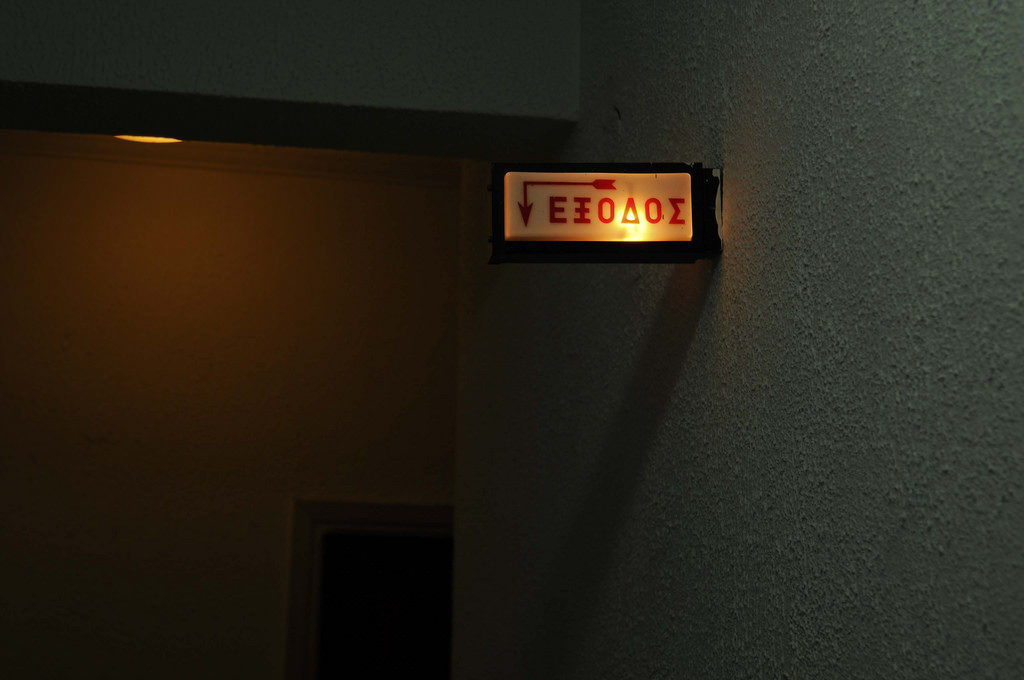
‘We had a dream last night, we had the same dream'[1]

I’m looking for a new love, a mouth that promises . . .
once upon a time . . .
or . . .
in the beginning . . .
the islands in the net were fewer, but people and platforms enough
for telepathy far-sight spooky entanglement
seduction of, and over, command line interfaces
it felt lawless
and moreish
wandering into the maw of the feast
in the realm of the Puppet Mistress, 1995
speech acts, sex acts, strange pacts
squirreled away in buffer logs and pasted Pine trails
weaving 1001 nights of Puppet Mistress tales
never on the down-low
was this most splendid DIWO
permission granted,
always, all ways
read write execute
reeds rites hexecutes
I was Alice clasping the little bottle labeled ‘DRINK ME’
becoming-Sufi, heady with some love-like like love emotions
juiced up jouissance
psychosomatic investigations
psi psi psi
ψ ψ ψ
sigh
seeking the difference/s
if any
between a suspected false binary
Virtual — Real — Life
difference
différance
different ants
worker queens snorting lines of flight
‘IRL’ (‘in real life’) prefaced conversations
whereas no-one said ‘IVL’
VL was the norm
so no need for a distinguishing preposition
whereas you needed to go somewhere, in, purposefully,
to get (back) to real life
Back to life, back to reality
Back to the here and now yeah
. . .
Back to life, back to the present time,
Back from a fantasy
Soul II Soul 1989
I ask Monstrous_Gorgeous (aka t0xic_honey @Lambda) to trawl through my stash of Moologs and MOOmails from my Lambda life, to search for signs of digital affliction. t0x’s forensic gaze (who eirself had been a keen Lambda queercoder back in the day) might be illuminating. GashGirl and her morphs(GenderFuckMeBaby, Madame_de_Clairwill, doll yoko, Rent_Boy, et al) had run amok and amongst simultaneous games, switching genders, personae and communicative registers as easily as children playing ‘let’s pretend‘. The best game was that between Puppet Mistress and her Puppet (aka YourPuppet). Today the language seems quaint, The Difference Engine meets The Pearl, steamy stream punk. All bonnets, bronze and tiny buttons.

Wolf.
Homunculus.
Ghost.
Doll.
It’s a sky-blue sky.
Satellites are out tonight.
Let X=X.
Laurie Anderson 1982
does X=X?
or VL = zero?
with RL the one of ones, the one and all,
the only one (of all possible lives)
I think not!
t0x phones me, recounting episodes that I cannot recall, but which are so in-character I have for sure they happened. Like when I punished My Puppet severely for daring to speak with t0x about her in-MOO peep show. Now we can laugh about it, now that the field lies fallow, but at the time I was furious. Living at (on? in?) LambdaMOO did not diminish affect or emotion, but rather it intensified thought, sensation, desire, need.
can we call this addiction?
or obsession?
compulsion maybe?
I chatted this week with Jon Marshall, my anthropologist friend and author of Living on Cybermind (an ethnography of a mailing list), about how it felt more like a habit than an addiction. He talks about personally accumulated habits and socially accumulated habits. Humans are constructed of habits, including the habits that you build up around internet use. We recall the ‘Rape in Cyberspace‘ event at LambdaMOO; ‘that story becomes a myth that guides behaviour’, suggests Jon. My habit would not have led to such intense encounters, if all of us lot had not been sharing a gravitational pull to the glimmering galaxies of spiralspace. My twin talks about habit lying at the junction of nature and nurture, opening up another line for future investigation. Never enough time. Instead I loaf around on Netflix with Terrace House: Boys & Girls in the City.
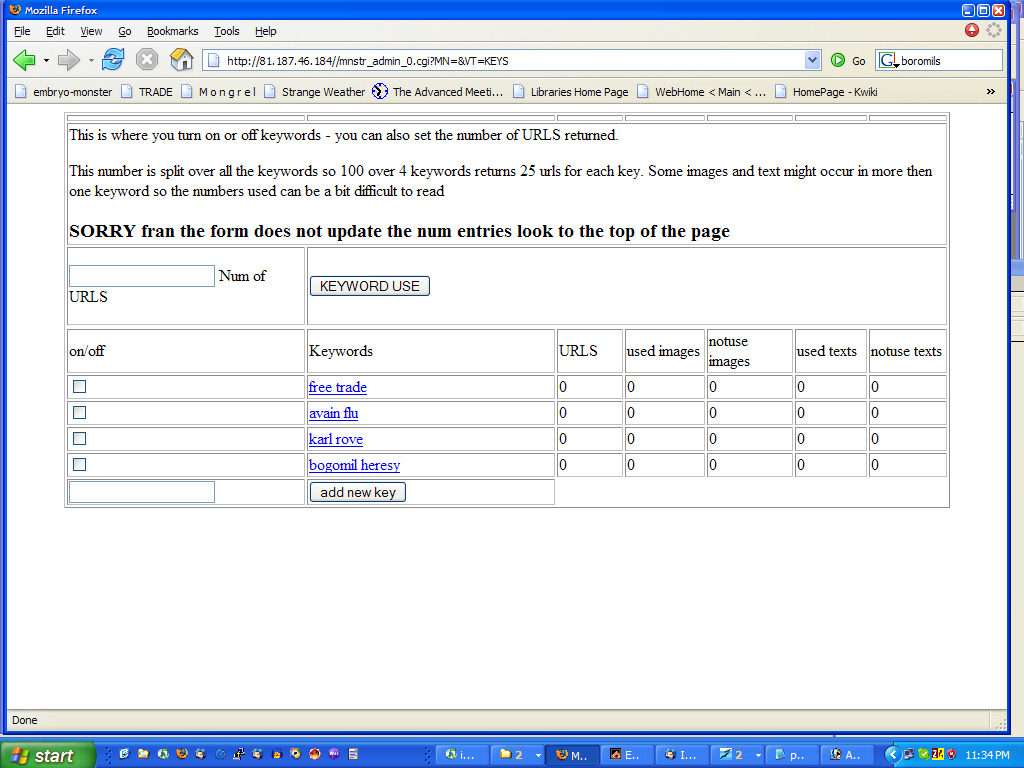
for me the habit of MOO (Mu) was quickly formed,
and devastating to desert
Ripping through a damaged heart
in the best of daze
circa 1992 93 94 95 96
(=3)
I didn’t leave home
a charming house with a white peach tree, goblin hut
and a dial-up 14,400 modem usurping landline’s phone functionality
for years I burrowed in through a borrowed log-in
J (aka connie_spiros @Lambda) pounds on front door to kick me off
later I jumped onto a free account offered by community provider apana
through its tiny sibling sysx (thank you Scott and Jason)
part of a tribe meshwork of cool sysops animating .net
motivated by the conviction of net access for all
xs4all
excess for real
S (aka Quark @Lambda) told me how depressing it was to leave home at 7.30am seeing me already jacked in, and to find me still in pajamas at dinner time, a sure sign that I hadn’t stepped away from the computer all day.
frequently he’d say ‘What’s wrong with this picture?’
(rhetorical)
5 words yanking me from my fugue
to discover myself pretzeled around the machine
in a position so unnatural it had become natural
to a life lived more and more in a VL that had become my RL
there was a vastness to the generative affective experiences
it felt unstoppable
on par with the most exhilarating love affairs
continual platform jumping
(don’t mind the gaps)
with unseen but deeply imagined companions
haunting me from nautical twilight to nautical twilight
netmonster, 2005
The only platform that came close to the seductiveness of Lambda was Netmonster, a network visualisation engine built by artist coder tinkerer Harwood (aka Graham Harwood). I was fascinated by the code and what it could do. And I adored the constant communication with my bruvv, the one who calls me ‘witch sister’. We hung around on the server, chatting white text on black screen. I made him a self-executing poem in Perl, my one and only attempt to learn some rudiments of that language. Netmonster could be a machine for collaborative writing, for prophesy, a tool for poking around in the machinations of power and capital. I imagined its transformative potential on a magical level, casting silver spanners into the bellyworks of the Beast. As a user I became tangled in search strings questing for the grail of understanding. Without knowing what I was asking, I pushed Harwood to push the code, Perl, to do things it wasn’t designed to do. The machine groaned under the weight of requests, and eventually its interactive functionality was turned off (brutal!), leaving just a beautiful hyperlayered carapace online. The emptiness I felt when the living essence of the project was no longer was comparable to the hole of grief when a lover says it’s over. The spirit of Netmonster had left forever. I was alone again.
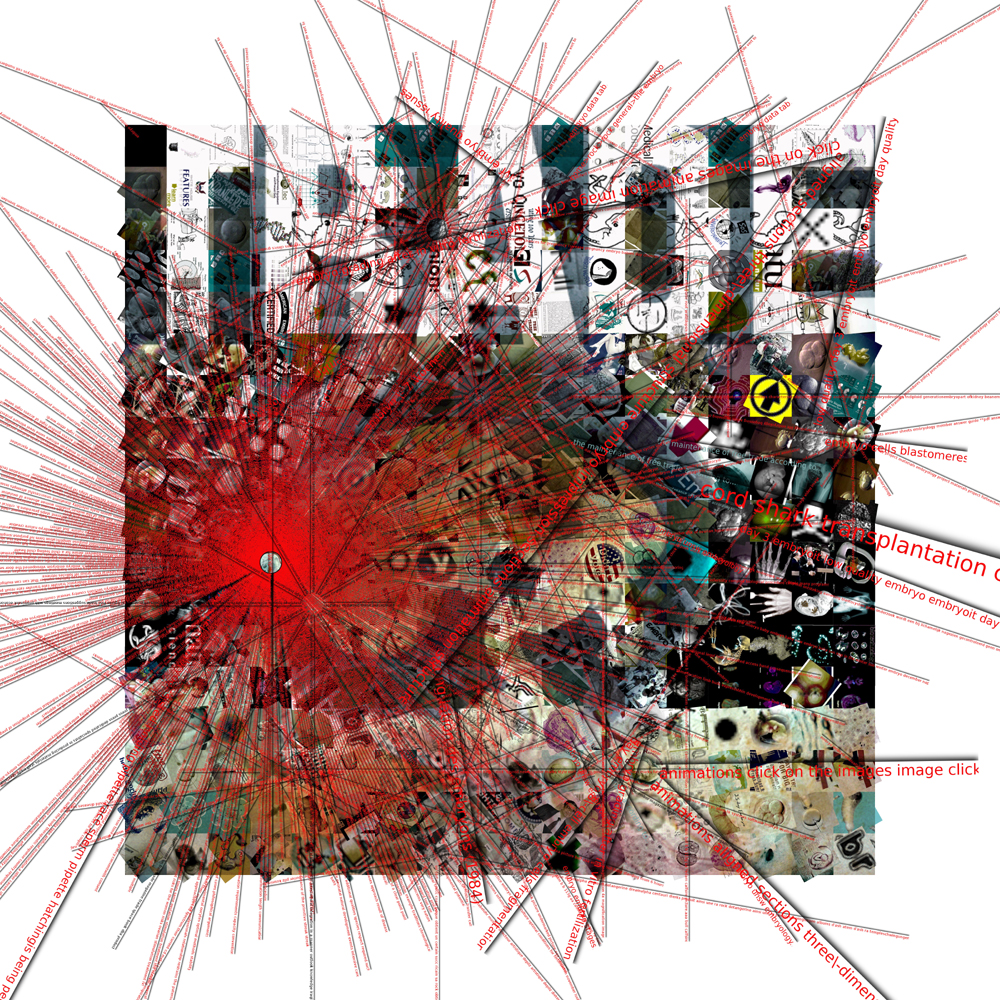
clever little tailor, 2017
There’s a few of us chatting around a table in Clever Little Tailor, an affordable bar if you stop after one drink. Around the table S2 (artist/student, early 20s), A (poet/singer/student maybe just grazing 25), and a couple of ancient cyberwitches. We speak about imbuing inanimate objects, a child’s wooden horse, a Persian rug, with magical powers, to speak, to fly. The human tendency to want to create life in things, including things and wings of internet, and this predisposition in turn enlivens and expands us. The topic turns to matters of the heart, and native/natal platforms. Those communicative modes that either we were born into or grew into, the sticky tongue finger techs that we associate with our netted emotional and social lives. We talked about coding and not coding, about the need to live online, and the impulse to desert it. Instant Messaging is for S2 what Internet Relay Chat was for us. We spell out the spell of Command Line Interface in a condensed version of how we uploaded ourselves to the song of the modem, waiting up all night to be able to play, existing betwixt and between multiple time zones. We struggle to find the right words (because the material of this stuff is made of words but is so not about words really) to evoke the deliciousness of what was a relatively uncolonised uncommodified unregulated ineffable space. Even if we hexen rarely use the word ourselves, the neologism (and who could forget Neo!) cyberspace, continues to signify the consensual hallucination of jacking in to the zone. Maybe now it’s more mall than sprawl for us who experienced something more unbounded, but for the next gens the intensities, the desires are equivalent.

17.10.17
forever doll
becoming witch
she opens her mouth
and swallows the world
she opens her mouth
and swallows your word
dissolving like spun sugar
laced with saffron threads
hexe hexe hexe
tiva! tiva! tiva!
naughty naughty naughty
all for naught
and nought for one
zero and one
zeno and won
one on one on one
on and on and on . . .
Thank you to old and new friends whose ideas have nourished this text: Virginia Barratt, Alison Coppe, Linda Dement, Teri Hoskin, Jon Marshall, Stuart Maxted, John Tonkin. Big thanks to (bruvv) Graham Harwood for inviting me to play and live inside Netmonster in 2005.
Francesca da Rimini (aka doll yoko, GashGirl, liquid_nation, Fury) is an interdisciplinary artist, poet and essayist. She revels in collaborative projects, joining companions in generating slow art, strange beats and new personae. As co-founder of cyberfeminist group VNS Matrix she contributed to international critiques of gender and technology. The award-winning dollspace deployed the ghost girl doll yoko to lure web wanderers into a pond of dead girls. As GashGirl/Puppet Mistress, she explored the uploaded erotic imagination of strangers at LambdaMOO. More recent performances , collaborations and installations including delighted by the spectacle, hexecutable, songs for skinwalking the drone, hexing the alien, and lips becoming beaks have combined rule-driven poetry, fugue states, spells and prophesies as hexes against Capital.
“Certain subjects compel me – alchemy, folklore/folk law, emancipatory social experiments, the nature of cognition, and states of ‘madness’ and ecstasy. I approach art-making as a hexing, a spell, a witch’s ladder to another realm. To paraphrase anarchist anthropologist David Graeber, a revolutionary act is to behave as if one were free.” da Rimini
“Hello, I’m Riz Lateef. Tonight our top story: Instagram travel-star Amber Hinton is missing in Indonesia. Initial reports suggest she has been kidnapped by an ISIS faction operating in the region. We’ll have more on that after the headlines.”
In 2014 Amber Hinton left a lucrative job in finance to follow her ‘dream’ of travelling the world. Like many young women she recognised the potential inherent in her looks; she had an ability to tap into veins of social media, and grasped the appeal for people to ‘follow’ in her footsteps. Educated, professional and dedicated she began by surveying Twitter and Instagram; filtering by hashtags she categorised countries by cultural capital (aka likes, retweets, comments) and then cross referenced with existing coverage. Logic followed that if Thailand was hot right now it might not be hot in a year’s time. Novelty and newness would be essential to getting a foothold in the market.
After months of post-work spread-sheeting, Amber was ready. At a brunch with friends she introduced a mood-board and sales-pitched her new life. I say mood-board, but really I mean a highly aestheticised business strategy. She’d categorised hundreds of travel lifestyle pics and identified core principles of success. With Google Analytics she’d examined the lifespan of a hashtag. She’d reviewed where successful Instagram travellers had been, which countries were oversaturated and which were primed to explode. She’d mapped a route, ensuring a balance between city, beach and country, simultaneously factoring in cost efficiency. She’d prototyped a website and employed a graphic designer to mock up a look and feel for her personal ‘brand identity’. She’d run financial predictions, how long her start-up capital would last, how she expected to turn a profit through funding websites, travel blogging, and eventually as an advertising service for hotels and travel companies.
It was, in short, a stunning piece of work. If Amber had been inclined towards the monastic life of a PhD researcher, she could have turned it into four years paid writing, then subsequently taught her findings at Oxbridge without ever leaving the UK.

With her friends’ enthusiasm and her parents’ consent Amber left for Italy. Between 2014 and 2017 she travelled across the world, first moving in small steps, from Italy to Slovenia, to Bulgaria and Turkey. From Turkey she jumped around the Middle East and North Africa, avoiding conflict zones and skipping countries whose religious codes might frown upon her displayed body. Everywhere she went she befriended new contacts to utilise, chic twenty-somethings who’d invite her to their parents’ villas, rich bankers who’d get her into rooftop parties. Courting the cultural elite was vital; she didn’t have the financial reserves to fund a lavish lifestyle, but she could enter those worlds and achieve an image of effortless glamour.
By the time she reached the Moroccan coast she’d amassed over 75K followers. Enough to be on the radar of international PR girls. Invitations started flying in: five star luxury hotels and exotic adventures. Whilst sipping alcohol-free cocktails and bronzing her skin, she strategised her next move.
She flew to Malta, then across the Atlantic, island-hoping round the Caribbean. In America she visited boutique ranches and hunted down bohemian culture. Down to Mexico, then South America, a perfect blend of high class living and poverty porn. From South America she crossed the Pacific, stopping in at Hawaii on the way, then modern China and finally, in early 2017, Indonesia.
The world first knew something had gone wrong for Ms Hinton was when she posted a unusual message on Twitter. For three days she’d been five star eco-glamping in the rain-forested hills of Lombok, swimming in waterfalls, taking selfies with monkeys and then suddenly:
@amber_abroad
I heard a gun shot! What do I do! HELP HELP HELP
Minutes later a second tweet followed:
@amber_abroad
They said my name, tell me parents I love them
Within minutes a storm of activity was echoing around the Twitter-sphere and #saveamber was the number one trending topic on social media. Facebook campaigns began and Indonesian public officials were receiving flak from latte drinking yuppies in North London. By the second day the Foreign Office had publicly announced that British tourists in Indonesia were advised to leave the country immediately. Typically slow to respond, but then absolutely committed, ISIS announced that Ms Hinton’s abduction had been orchestrated by them, despite it obviously being carried out by a unassociated cell with little to no connection with the upper echelons. For three consecutive days BBC Breakfast News dedicated a half hour to the unfolding crisis; they even flew Naga Munchetty out to Bali to goad tourists into overreactions.
Five days of media fixation were followed by a week of not giving a damn; then out of the blue something very odd began to happen. Instagram accounts operating out of the Indonesian and Philippine ISIS territories started taking on a much more aesthetically sensitive tone. Poorly photoshopped images were replaced with a wave of creative shots. Against verdant jungle foliage, handsome young fighters were pictured topless, sweat glistening on their ripped pecks, rifles casually held over their shoulders. Puppies were photographed wrapped in ISIS flags. Trope travel images, ‘everyone jumping on the beach together’ and ‘girl leading boy’, were bastardised into calls to martyrdom.

At first Amber’s family was relieved; their daughter was alive and communicating with the world. Security services reassured them that eventually she would reveal her position, then they’d be able to plan her rescue. Weeks developed into months and still it seemed Amber was so tightly under the thumb of her captors that she couldn’t encode a message. All they could do was watch her PR strategy unfold.
Back home Theresa May used the crisis to spearhead her personal campaign against social media giants and internet freedoms. “By doing nothing, Instagram encourages ISIS”. In truth they were shutting down hundreds of accounts each day and actively handing data to the NSA and GCHQ.
By the time a video appeared online, ‘Amber’s Top 5 Tips For The Perfect Jihadi Pic’, Theresa had reached her line in the sand. Co-ordinating with the Indonesian President Joko Widodo, Ms Hinton was marked a priority target. If and when they had a lock on her location, an American drone would strike.
The final Instagram post attributed to Ms Hinton was posted on the 25th of June 2017.
For three weeks MI6 had been working in close communication with Indonesian intelligence officials to triangulate her location, scrutinising every post for a telltale clue. Eventually it was a sun umbrella that gave her away; its pattern of red and yellow stripes was attributed to a hotel on a recently occupied island. The post was confirmed as being a Amber original due to her characteristic use of the Juno filter and the Smiling Cat Face With Heart-Eyes emoji.
Amber’s parents were never told the truth about their daughter’s death. Several months afterwards a nice man from the intelligence services told them they believed ISIS had killed her, citing a lack of posts as evidence. Communications were falsified when they demanded proof. They were never shown the photos of her charred scalp, or the one of her left foreleg on the beach; it’d be blown clean clear of the hotel. In the end only a few people, in secret rooms, ever saw the evidence. None of the photos ever made their way online.
“Flexicity, information city, intelligent city, knowledge-based city, MESH city, telecity, teletopia, ubiquitous city, wired city… [what is] a city that dreams of itself?” (Jones 2016).
This April, 28 brave souls came together for the first time to explore algorithmic ghosts in Brighton — a city known for its blending of new-age spiritualities and digital medias, but perhaps not yet for its ghosts — through the launch of a new psychogeography tour for the Haunted Random Forest festival. Unveiling machine entities hidden within seemingly idyllic urban landscapes, from peregrine falcon webcams to always-listening WiFi hotspots, we witnessed a new glimpse of an old city, one that afforded many strange moments of unexpected (and perhaps even radical!) wisdom regarding the forgotten structures, algorithms and networks that traverse Brighton daily alongside its human inhabitants.
This intervention found its greatest inspiration in the playful, crtitical, anti-authoritarian strategies of the Situationist International group that was prominent in 1950s Europe and birthed the fluid concept of dérive or “drift”, a new method for engaging with cities like Paris through “psychogeographic” walks that charted increasingly inconsistent evolutions of urban environments and their effects on individuals. “Perhaps the most prominent characteristic of psychogeography is the activity of walking,” explains Sherif El-Azma from the Cairo Psychogeographical Society. “The act of walking is an urban affair, and in cities that are increasingly hostile to pedestrians, walking [itself]… become[s] a subversive act.”
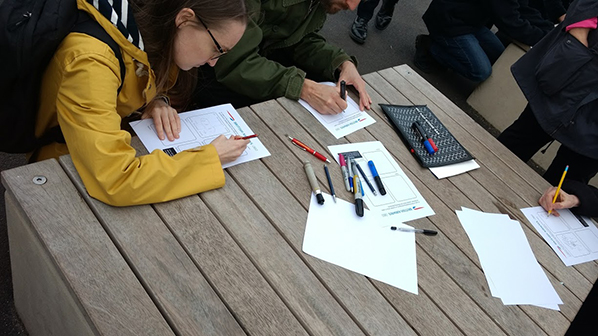
Psychogeographical drifts have been interpreted in many ways in many places, from radical city tours with no set destination, to public pamphlets meant to shock people out of their daily urban routines, to unsanctioned street artworks that explore changing architectures and hegemonies of the built environment through direct dialogues. As the Loiterer’s Resistance Movement explains, “We can’t agree on what psychogeography means, but we all like plants growing out of the sides of buildings, looking at things from new angles, radical history, drinking tea and getting lost, having fun and feeling like a tourist in your home town. Gentrification, advertising, surveillance and blandness make us sad… our city is made for more than shopping. We want to reclaim it for play and revolutionary fun.”
In our own interpretation of the psychogeography “play box“, people from across the UK came together from local community discussion lists, universities and creative networks to join the group. We called them ‘node guardians’ to connote a shared sense of ownership regarding both the tour nodes (which were lead not only by ourselves but also by several other brave participants, who also facilitated hands-on activities to engage listeners more deeply in the lived experiences of each machine node). We were intrigued about the moments of access, control and liberation that might be exposed when the machines, networks and algorithms that we engage with on a daily basis were revealed. In the unearthing of lesser-known instances of code-based activity (and the patterns within), we hoped to meet machine spirits, languages and loves along the way. And meet them we did.
Although the tour aimed to seek out algorithms and machines, we didn’t feel limited to influences from our current digital age. Brighton has a rich history of invention and engineering which has influenced the local geography as well as wider culture. The ghosts of Magnus and George Herbert Volk, father-and-son engineers, can be found all over the city, from Magnus Volk’s seafront Electric Railway which opened in 1883 — making it the oldest working electric railway in the world — to George’s seaplane workshop in the trendy North Laine shopping area, which went on to house a thoroughly modern digital training provider, Silicon Beach Training. Magnus Volk’s most unusual invention, though, only exists as a part of Brighton’s colourful history: the Brighton and Rottingdean Electric Railway, as it was officially called, earned the nickname the ‘daddy-long-legs railway’ as it ran right through the sea with the train car raised up above the waves on 7-meter-long legs. The railway was only in operation for 5 years from 1896 to 1901, but you can still see some of the railway sleepers for the tracks along the beach at low tide.
For a relatively small town, Brighton also played a surprisingly big role in the development of the international cinema industry. In the 1890s and 1900s, a group of early filmmakers, chemists and engineers called the Brighton School pioneered film-making techniques such as dissolves, close-ups and double exposure, and created new processes for capturing and projecting moving images. Key members of the group used the old pump house in local pleasure garden St Ann’s Wells as a film laboratory and shot the world’s first colour motion picture called ‘A Visit to the Seaside’ in Brighton in 1908, using a colour film process called Kinemacolour invented by the group. Although the city’s early passion for cinema is remembered by several blue plaques marking key locations — and the presence of the Duke of York’s cinema, the oldest continually operating cinema in the UK — we wondered how much of Brighton life had been captured in the dozens of short films made at the turn of the century, only to be lost forever?
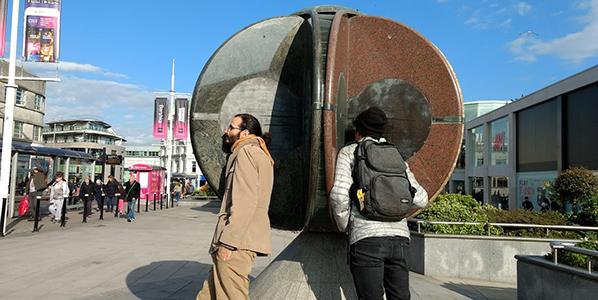
The rest of the stops on our walking tour took in more contemporary machine ghosts, including the last remaining trace of the city’s USB dead drop network — conveniently embedded in a brick wall on the seafront above the Fishing Museum — which prompted us to ask what information people may have passed to each other before these devices were destroyed by weather and vandals. Dead drops were originally set up to be an anonymized form of peer-to-peer file-sharing that anyone could use in public spaces. They have since been embedded into buildings, walls, fences and curbs across the world. Perhaps some of our tour participants will even be inspired to set up new dead drops around the city to keep the potential for off-grid knowledge-sharing alive.
In a reversal of this spirit of anonymous digital communication, a new network of WiFi-enabled lampposts, CCTV cameras and other pieces of ‘street furniture’ has been unobtrusively installed across the city by BT, in partnership with Brighton & Hove City Council. They now eavesdrop on the personal musings of passers-by who connect to them. These hidden devices provide users with a free WiFi service, but the group wondered at what cost. Participants found themselves questioning whether BT can be trusted to keep our information secure in an age where data has become a valuable marketing commodity.

As part of our psychogeographical aim to unveil the hidden lives of once-familiar urban artefacts, we also summoned the machine ghosts of some of Brighton’s most famous (and infamous) landmarks. Looming over the city centre is a towering modernist high-rise called Sussex Heights, a building that sticks out like a sore thumb amidst the classic Regency architecture of the city’s Old Town. Yet atop the concrete tower also live families of peregrine falcons, whose nesting activities are broadcast to the world by an ever-watching webcam. Conservation groups, architects and technologies intersected in 1990 to provide a nesting box that would enable the falcons, extinct in the area at the time, to successfully breed. They now return to the tower block every spring to rear their young (except in 2002, when they chose the West Pier instead). Writing down our best wishes to this season’s hatchlings, we pasted them onto the building for future city ghosts to browse.
The other most visible instance of architectural and structural technologies descending upon the city can be seen in the new British Airways i360 viewing tower, variously described as a ‘suppressed lollipop’, a ‘hanging chad’, ‘an oversized flagpole’, an ‘eyesore’ and a ‘corporate branding post’. Even if you leave the city, you can’t get away from the sight of the 162-metre tall tower, as it is equally visible from the countrysides surrounding Brighton. It overshadows its neighbour, the beloved remains of the burnt-out West Pier, and opened exactly 150 years after the West Pier first opened in 1866. However, the ‘innovation’ in the i360’s name may be a boon to the city, as it’s expected to pour £1 million a year in the local community and potentially inspire the renovation of the West Pier. Our node-guardians bravely attempted a participatory activity outside the i360 which involved sketching out mock flight warnings to those who entered its gates; the mock flight attendants situated at the base of the i360 were less than amused by these efforts.

In most towns, the shopping centre becomes a well-known haunt for both locals and visitors to congregate, yet most people who visit Brighton’s Churchill Square shopping mall pass by the square’s large pair of digital sound sculptures without even a glance. The sculptures look like a pair of matching stone and bronze spheres, and are the type of public art that you can walk past everyday without actually looking at, but after looking into their always-observing faces once, you’ll never miss them again. They quietly interact with the sky every day through a set of complicated light sensors that trigger a series of musical notes tuned in to each orchestration and angle of the sun. As the sun rises, they call out to one another, their combined song fading away as the sky turns dark. Or at least, we are told they communicate; after a group activity to emulate the interactivities of the spheres, we found ourselves quite unsure if we had actually heard ghostly spherical music emanating from spherical mouths, or just the sound of shoppers and buses passing by.
And finally, if you’ve lived in Brighton for a while you’ve probably come across the French radio station FIP, which until a few years ago you could tune into on radios across the city. While standing in the bustling North Laine cultural quarter, we were briefly transported to Paris by one of our node guardians’ melodica renditions of Parisian cafe music, and heard the story of how a local resident introduced Brighton to FIP in the late 1990s when they started re-broadcasting the radio station out over the city. It became one of the most popular radio stations in town and transmissions continued until 2013, even surviving an Ofcom raid on the mystery broadcaster’s house in 2007 when their equipment was confiscated. The story of Brighton’s love for FIP radio, including a monthly fan-organised club night called Vive La FIP that joyously ran from clubs around the city for years, shows that as well as its own ghosts, our city is also haunted by the machines of distant places.
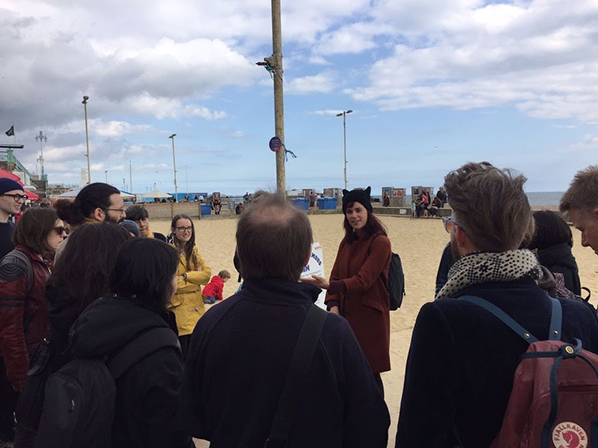
Indeed, from the distant ghosts of rebellions past to those who quietly slip by underfoot as we walk to the pier, the derives of this tour taught us that unearthing hidden histories of a city can bring both good and bad spirits back to life — moments of local liberation and defiance existing alongside a national state of increased surveillance, conglomeration and control. We call for future tours, psychogeographic and otherwise, that challenge participants to think about Brighton through new forms of engagement that focus on grassroots and community efforts, and their implications in the spaces and places we use every day. Only then can we determine whether the ghosts that surround us are in charge of our fates, or whether the myriad past and present struggles of this city can co-exist in collaboration.
Techno-fixes are big business. Taking a quick look over the Financial Times’ list of the world’s largest companies[1], it might not surprise us that five of the top spots are occupied by corporations dealing in Information Technology. The looseness of this term connotes the production and dissemination of hardware, software and data, yet increasingly such companies are moving beyond this operational remit and have begun selling a vision of how life in its totality could—and should—be lived. Over the last decade, these so-called ‘Big Tech’ companies—Apple, Alphabet (Google’s parent company), Microsoft, Amazon, and Facebook—have sought to fashion bespoke technological ‘fixes’ to particular global crises, with the aim being no less than shaping the future of humanity itself. Facebook’s Aquila solar drone project, for instance, will help four billion people in disparate regions of the globe ‘access all the opportunities of the internet’[2]. Meanwhile, Alphabet’s experimental X subsidiary is developing Project Loon, a competing network infrastructure powered by a fleet of solar balloons[3] .Which connected future do we want: one with networks of balloons or drones? Or, more to the point: one filtered through the prism of Google’s or Facebook’s algorithms? The fictional character of Gavin Belson, the deranged CEO of the quasi-Facebook-Google mashup Hooli in HBO’s comedy series Silicon Valley, captures the bizarre competitive logic of Big Tech utopianism when he states with marked frustration:

It is not only the digital divide and the contingent possibilities of market expansion which Big Tech is claiming to ‘solve’ with these ambitious infrastructural projects. Climate change, healthcare, forced migration, democracy, and automation are all staked out in branded promotional media[4] as challenges which have imminent technological solutions—just a few ‘versions’ away. In such media, we are pushed forward into a time where these complex issues have been resolved, becoming conspicuous non-features of everyday life, unrecognized background conditions that allow us to marvel at the much more spectacular and exciting business of glossy technological innovations: the familiar gesture-controlled sheets of glass, the smart-everythings and the augmented-anythings.
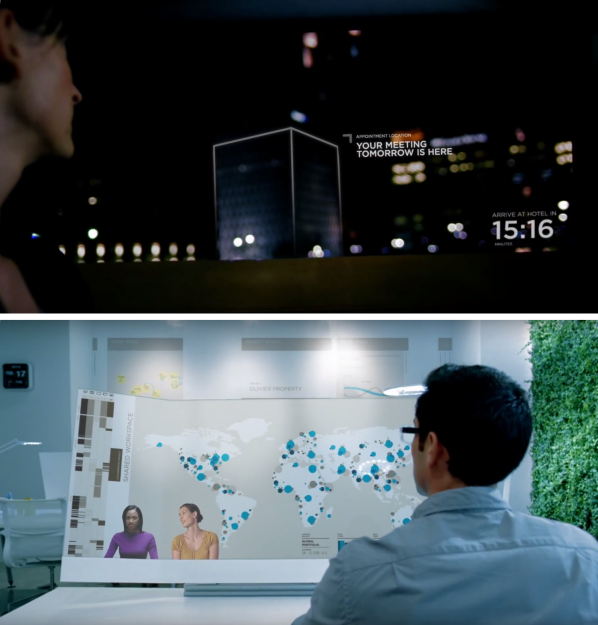
In these ‘design fictions’, as the Brazilian theorists Gonzatto et al. call such marketing campaigns, present crises ‘are anticipated and solved by technology’, proffering resolutions that ‘nurture consumers into consumption habits and convince investors of their capacity to fulfil those same demands’[5]. In this way, design fictions are replete with ‘solutionist’ fantasies where digital technology is positioned as a corrective to the challenges and irregularities of living. Solutionism, what Evgeny Morosov describes as an ‘intellectual pathology’[6] that can only consider problems in the form of their smart technical ‘fix’, nullifies any wider discussion of the problem at hand, abstracting the proposed resolution from the historical, social and political context of its implementation.
Therefore, whilst it is hard not to be seduced by the glossy ingenuity of projects such as Aquila and Loon, we ought to take a moment to question the frictionless future championed in these grand projects. The crises opened up and subsequently ‘solved’ by Big Tech companies scaffold the realm of present and future possibilities for our collective engagement: to determine a set of relations as constituting a crisis is to justify and arrange the ground for its resolution. For this reason, it is important to ask: Whose crisis is it anyway? Who has defined the problem that needs solving? And whose interests are being served by these proposed solutions? With such queries in mind, the benign qualities of design fictions are problematised, and their rootedness in the techno-politics of the present become plainly visible.

The recent publication of Mark Zuckerberg’s Building Global Community[7] manifesto affords such queries a timely focal point. At stake in Zuckerberg’s far-reaching manifesto is, in essence, the role that Big Tech can play in global governance. More specifically, it proposes the positive contribution that can come from Facebook’s direct engagement with the tasks of local and national security, the distribution and moderation of information, governmental politics, and fostering a post-national communalism.
These are indeed lofty ambitions, even for a company that boasts a quarter of the world’s population as monthly active users. However, Facebook purports to relish such a challenge, motivating employees by reminding them that the “journey is 1% finished”[8]. The ‘journey’ in question here is the fixing of what Facebook sees as a crisis of disconnection experienced by those almost exclusively situated in remote regions of the Global South. Facebook asks us to imagine how much better the lives of these ‘disconnected’ people could be if only they had access to the same degree of internet connectivity that those of us in the Global North enjoy on a day-to-day basis. With these sentiments in mind, the remainder of Facebook’s arduous voyage will largely be accomplished through the development of high-profile projects such as Internet.org, where the polished graphics of constituent programmes such as Free Basics and the aforementioned Aquila act as ethical avatars for Facebook’s very own brand of solutionism.

Zuckerberg claims that, ‘in times like these, the most important thing we at Facebook can do is develop the social infrastructure to give people the power to build a global community that works for all of us’[9]. Free Basics aims to provide a free-as-in-beer (but not free-as-in-freedom) curated portal to specific sites on the internet, providing information about healthcare, news, employment, and education to individuals who might otherwise live offline and thus disconnected lives. The humanitarian rhetoric follows that bringing ‘people online’ will ‘help improve their lives’ and additionally offer these societies ‘knowledge’, ‘tools’, and global connections—these are fundamentally good things worthy of our support, right? The predictable catch is revealed in Internet.org’s promotional material, whereby companies prospecting for new markets are offered a head-start on reaching ‘the next wave of people coming to the internet’[10], albeit through Facebook’s technical infrastructure and curatorial apparatuses. Such philanthropic endeavours, if successful, assist in consolidating the corporation’s present hegemonic position in future scenarios. For governments struggling with establishing network infrastructures, Free Basics proposes an attractively simple solution that, with Facebook’s capital and clout, can be quickly deployed and established. It is however a valuable foothold, one that prescribes a developmental course that entangles the technical apparatuses of the corporation with the task of future regional governance. This is the strategic-thinking which fuels the bizarre competitive logic of Big Tech utopianism, and which sits as the political kernel of future visions. It is the rhetoric of the real-life Gavin Belsons of Silicon Valley.
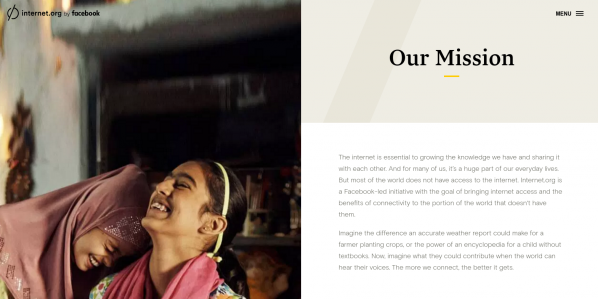
By determining that there is a crisis of disconnection, Facebook prepares the ground for its resolution in the form of projects such as Internet.org. The idea that a global community of connected Facebook users can level the systematic inequalities in wages, living standards, and welfare provision inherent to globalized capitalism is a resolution that erases the multiplicity of forces acting upon a complex array of interacting crises. In making this erasure, Facebook’s logic of development draws an uncomplicated line of progression from ‘unconnected’ to ‘connected’ subjects. Such thinking is as obviously reductionist, and contestable, as the pathways that lead from ‘boy’ to ‘man’, ‘young’ to ‘old’, ‘civilised’ to ‘uncivilised’. These binary terms edifying developmental logic are laden with normative significance, implying a way of thinking about the world that presupposes and prescribes a certain way of living within it. The interconnected and complex issues that contribute to global inequality—institutional structural biases, discriminatory trade relations, the experiences of colonialism, the exploitation of resources, to name but a scant few of a vast number—do not even come into the equation. In this schematic, Facebook’s own position in relation to these matters is unacknowledged. Furthermore, the position of humans as ‘Facebook users’ worldwide is not only rendered as neutral, closing off debate around value production and labour processes in digital capitalism, but positively imbued with some sort of higher moral purpose. What does it mean, then, for Facebook to imagine a time beyond crisis? To offer a resolution to the ‘problem’ of global disconnection? As Antoinette Rouvroy would argue, such thinking inoculates the present and ‘forecloses the future’[11].

This example of Internet.org does not simply aim to expose the economic incentives lurking behind such seemingly benevolent global projects—these motives should be obvious enough already. Rather, we hope to have opened up the conversation surrounding these future visions, and the possibility of techno-fixes in general, as a means to question how we as humans come to know, relate to, and interact with both the technological era we inhabit and the perceived ‘crises’ of our time. We suggest that determining the political qualities of a ‘crisis’ opens an essentially creative and interpretative space—one that leads to a recognition of both vulnerability and empowerment. To situate yourself within the field of imagined problems and potential resolutions is to shape the possibilities of your subsequent action. Being exiled from this process, by virtue of being exterior to the kind of walled-off discussions leading Internet.org’s various initiatives, leaves us neither vulnerable nor empowered. Rather, we find ourselves neutralized in the analytical inertia of solutionist design fictions and the galleries of seductive techno-fixes rendered within.
If solutionism presupposes techno-fixes which close off alternative paths of action, Network Diagnostics intends to provide a space that expands our ability to think beyond these prescriptive future visions of Big Tech. Using ‘troubleshooting’ as a methodological tool, we propose to collaboratively examine not just what such visions include, but, perhaps more significantly, what they leave out. We aim to hold open a space for creative analytical discussion, whilst shirking the call to find a rigorous ‘fix’ to what we discover. In doing so, we hope to invigorate the modes of analysis available to those interested in the relationship between humanity and technology in the era of big data capitalism. Our collective diagnostic of the future ultimately hopes to help people understand, live within, and resist the conditioning forces we currently face in the present. Whilst we are not proposing solutions, and we do not claim to have fixed the crisis of analytical inertia wrought by the pressure of technological advancement, our practice uninhibits critique by recognizing the empowerment of claiming vulnerability, and problematising the relations at work in foreclosed, prescribed crises. Whereas Facebook and other such organisations strive to ‘move fast’, we suggest that we should dwell thoughtfully in the process of diagnosis in an effort to self-reflexively decouple the crisis from its readymade solution.
—
Niall Docherty is a PhD candidate at the Centre for Critical Theory at the University of Nottingham. His research involves an analysis of Facebook within the neoliberal context of its inception and current use, through the frames of governmentality and software studies.
Dave Young is an artist and a M3C/AHRC-funded PhD candidate at the Centre for Critical Theory at the University of Nottingham, and is currently researching bureaucratic media and systems of command and control in the US military since the Second World War.
In which the spectre of the Luddite software engineer is raised, in an AI-driven future where programming languages become commercially redundant, and therefore take on new cultural significance.
In 1812, Lord Byron dedicated his first speech in the House of Lords to the defence of the machine breakers, whose violent acts against the machines replacing their jobs prefigured large scale trade unionism. We know these machine breakers as Luddites, a movement lead by the mysterious, fictional character of General Ludd, although curiously, Byron doesn’t refer to them as such in his speech. With the topic of post-work in the air at the moment, the Luddite movements are instructive; The movement was comprised of workers finding themselves replaced by machines, left not in a post-work Utopia, but in a state of destitution and starvation. According to Hobsbawm (1952), if Luddites broke machines, it was not through a hatred of technology, but through self-preservation. Indeed, when political economist David Ricardo (1921) raised “the machinery question” he did so signalling a change in his own mind, from a Utopian vision where the landlord, capitalist, and labourer all benefit from mechanisation, to one where reduction in gross revenue hits the labourer alone. Against the backdrop of present-day ‘disruptive technology’, the machinery question is as relevant as ever.
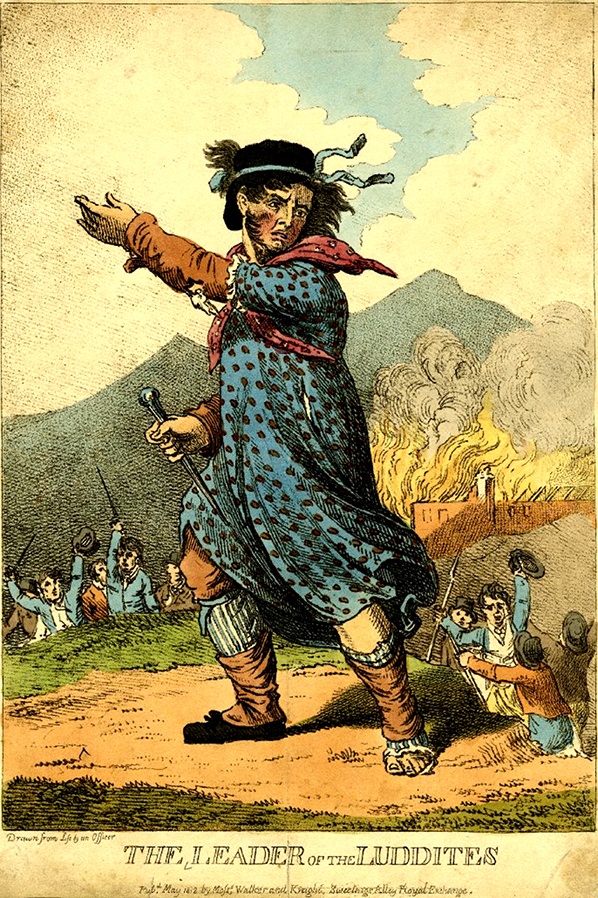
A few years after his speech, Byron went on to father Ada Lovelace, the much celebrated prototypical software engineer. Famously, Ada Lovelace cooperated with Charles Babbage on his Analytical Engine; Lovelace exploring abstract notions of computation at a time when Luddites were fighting against their own replacement by machines. This gives us a helpful narrative link between mill workers of the industrial revolution, and software engineers of the information revolution. That said, Byron’s wayward behaviour took him away from his family, and he deserves no credit for Ada’s upbringing. Ada was instead influenced by her mother Annabella Byron, the anti-slavery and women’s rights campaigner, who encouraged Ada into mathematics.
Today, general purpose computing is becoming as ubiquitous as woven fabric, and is maintained and developed by a global industry of software engineers. While the textile industry developed out of worldwide practices over millennia, deeply embedded in culture, the software industry has developed over a single lifetime, the practice of software engineering literally constructed as a military operation. Nonetheless, the similarity between millworkers and programmers is stark if we consider weaving itself as a technology. Here I am not talking about inventions of the industrial age, but the fundamental, structural crossing of warp and weft, with its extremely complex, generative properties to which we have become largely blind since replacing human weavers with powerlooms and Jacquard devices. As Ellen Harlizius-Klück argues, weaving has been a digital art from the very beginning.
Software engineers are now threatened under strikingly similar circumstances, thanks to breakthroughs in Artificial Intelligence (AI) and “Deep Learning” methods, taking advantage of the processing power of industrial-scale server farms. Jen-Hsun Hu, chief executive of NVIDIA who make some of the chips used in these servers is quoted as saying that now, “Instead of people writing software, we have data writing software”. Too often we think of Luddites as those who are against technology, but this is a profound misunderstanding. Luddites were skilled craftspeople working with technology advanced over thousands of years, who only objected once they were replaced by technology. Deep learning may well not be able to do everything that human software engineers can do, or to the same degree of quality, but this was precisely the situation in the industrial revolution. Machines cannot make the same woven structures as hands, to the same quality, or even at the same speed at first, but the Jacquard mechanism replaced human drawboys anyway.
As a thought experiment then, let’s imagine a future where entire industries of computer programmers are replaced by AI. These programmers would either have to upskill to work in Deep Learning, find something else to do, or form a Luddite movement to disrupt Deep Learning algorithms. The latter case might even seem plausible when we recognise the similarities between the Luddite movement and Anonymous, both outwardly disruptive, lacking central organisation, and lead by an avatar: General Ludd in the case of the Luddites, and Guy Fawkes in the case of Anonymous.
Let’s not dwell on Anonymous though. Instead try to imagine a Utopia in which current experiments in Universal Basic Income are proved effective, and software engineers are able to find gainful activity without the threat of destitution. The question we are left with then is not what to do with all the software engineers, but what to do with all the software? With the arrival of machine weaving and knitting, many craftspeople continued hand weaving and handknitting in their homes and in social clubs for pleasure rather than out of necessity. This was hardly a surprise, as people have always made fabric, and indeed in many parts of the world handweaving has remained the dominant form of fabric making. Through much of the history of general purpose computing however, any cultural context for computer programming has been a distant second to its industrial and military contexts. There has of course been a hackerly counter-culture from the beginning of modern-day computing, but consider that the celebrated early hackers in MIT were funded by the military while Vietnam flared, and the renowned early Cybernetic Serendipity exhibition of electronic art included presentations by General Motors and Boeing, showing no evidence of an undercurrent of political dissent. Nonetheless, I think a Utopian view of the future is possible, but only once Deep Learning renders the craft of programming languages useless for such military and corporate interests.
Looking forward, I see great possibilities. All the young people now learning how to write code for industry may find that the industry has disappeared by the time they graduate, and that their programming skills give no insight into the workings of Deep Learning networks. So, it seems that the scene is set for programming to be untethered from necessity. The activity of programming, free from a military-industrial imperative, may become dedicated almost entirely to cultural activities such as music-making and sculpture, augmenting human abilities to bring understanding to our own data, breathing computational pattern into our lives. Programming languages could slowly become closer to natural languages, simply by developing through use while embedded in culture. Perhaps the growing practice of Live Coding, where software artists have been developing computer languages for creative coding, live interaction and music-making over the past two decades, are a precursor to this. My hope is that we will begin to think of code and data in the same way as we do of knitting patterns and weaving block designs, because from my perspective, they are one and the same, all formal languages, with their structures intricately and literally woven into our everyday lives.
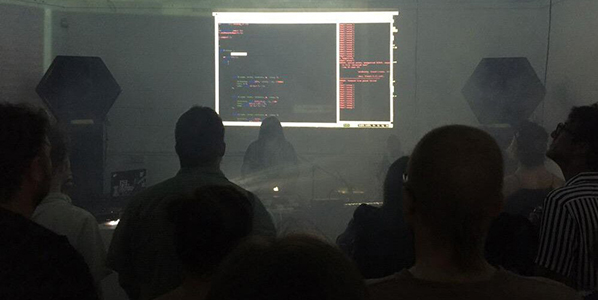
So in order for human cultures to fully embrace the networks and data of the information revolution, perhaps we should take lessons from the Luddites. Because they were not just agents of disruption, but also agents against disruption, not campaigning against technology, but for technology as a positive cultural force.
This article was written by Alex while sound artist in residence in the Open Data Institute, London, as part of the Sound and Music embedded programme.
What would you do if your partner was spending 17 hours a day online to earn a living? This short dystopian fiction by Elliott Burns paints an unsettling vision of a Gamer/YouTuber’s life(style) slipping out of control…
posted February 22nd 2017
“Wow, just WOW everyone! So I’ve got some really big news I want to share with you… Earlier today, after I finished my lunch, Kung-Pow Chicken Sub by the way, I went into my boss’s office and calmly explained that I would be leaving the company. So I am now t-minus two weeks until I walk out those doors for the last time EVER.
Why am I doing quitting? Because of YOU! Because of everyone out there who follows this channel, who watches these videos, who makes up this community. After 3 years posting video after video after video, this channel now makes enough in YouTube advertising revenues for me to dedicate my life to it!”
[he holds a wireless webcam with his right hand; raised up it faces back towards him and the room, behind are drawn curtains, shelves of video games and collectable figures, his computer set up and a pro-gaming chair.]
“I want to say a huge thank you to everyone of you! This is a dream come true, for me, my wife (going on 6 months now guys), and our puppy.”
[crouching down with his left hand he raises a small fluffy dog to his chest.]
“Say “hi” Jasper, say “hi” to everyone. Jasper’s really happy that Daddy gets to stay home all day now and doesn’t need to leave him alone. You know what else it means… it means from today onwards I’ll be posting more videos, more of the content that you LOVE, like this:”
[the screen switches to footage of a plane pulling a barrel-roll over a middle-Eastern oil refinery; overlaid his voice can be heard erratically.]
“This is Goose Feet! OVER! Deploying payload,”
[just before the right-wing clips a tower, pulling to first-person perspective he is launched into the air, rifle in hand, screaming:]
“MAYDAY MAYDAY pilot down over enemy territory,”
[pulling his chute.]
“I’m going in hard, guns blazing, send EVAC NOW, this is not a drill, I repeat NOT-A-DRILL!”
[the screen switches back to him in his room.]
“Not to mention our times together…”
[now we see a squad of armour clad super soldiers charging up a hill, plasma blasts rain down overhead from multi-jawed aliens and explosions erupt either side; amongst the chaos and lighting-effects he’s heard reciting the Micky Mouse Club theme tune:]
“Who’s the leader of the club, That’s made for you and me, M-I-C-K-E-Y M-O-U-S-E,”
[as his team mates respond with burst of laughing and cries of:]
“SHUT THE F*** UP.”
[back in his room again he pants, physically exerted by his excitement.]
“But most important of all, it means I can dedicate more time, NAY, dedicate my life to showing off the best-of-the-best of your clips, the greatest examples of battle from all over the world! Every week I will be showing the most courageous, outrageous and outright insane feats of computer game brilliance that you send me. And each week you can vote on who is the greatest-of-the-great. The insanest-of-the-insane.
Because I LOVE you guys, I LOVE that you’ve invested in me, this channel, this community that we’ve built together. Keep the likes, the comments, the shares, everything coming. Follow me on YouTube, on Facebook, on Instagram. There’s going to be competitions, give-aways, constant non-stop banter-rific laughs…”
[his focus trails off slightly, pulling out of character before dropping back in…]
And of course, as always, my content is free to view. Subscribe and help me continue making this dream come true, and check out my online-store (link in the description below) for some excellent merchandise!
I can’t say how much this means to me. All your support, it makes my life worth living… So for now, until next time, PEACE OUT, SandCastle128.”
[the screen splits into 12 pieces showing a selection of related videos]

March 1st 2017 00:23am
Downstairs the kettle is whistling; it’s on the gas and there’s no sign anyone will take it off soon. His wife is asleep with the dog curled up by her feet. In ‘his office’ the glow of his monitor illuminates his face, providing enough light for the webcam to see him, yet leaving the background in darkness.
With his headphone-mic set he can’t hear the kettle. He won’t notice it until this round is over with either the terrorist or tactical-squad winning.
He’s entered the villa through an open first-floor window. Downstairs a firefight is breaking out as three teammates try to catch the terrorists in a pincer movement, breaching from the front and back entrances. He’s careful to avoid traps, they may have left explosive around any corner, or could be camping, waiting for him to make a mistake. Any second now his team should be able to identify how many hostiles are on the ground-floor; however, until then he’ll need to exercise extreme caution.
The fifth member of their squad is holding back, sniper scope poised to take a shot through any exposed window. It’s the third round and they’re two games down, the enemy are co-ordinated so they’re working to draw them out.
His teammates report comes in: “They’re all on the ground floor. SandCastle128, on my mark, assault from the main stairs.” A deafening volley of machine gun fire opens up, his HUD reports one target down, sniper fire takes a second. “GO GO GO.” He runs into the fight, catches two targets from behind, raises his shotgun to iron sight and pulls the trigger.
His wife smacks him round the back of the head. His shot misses and the targets turn filling him with lead. “Kettle’s boiled, I’m going back to bed!” That live-stream went out to 4,156 people on Facebook.
To read the rest of the story, please download Top 10 Plays of the Week as a PDF
Featured image: Donald Trump as a God
“There I was faced with my nemesis, reading. It isn’t that I flubbed the words, or stumbled and mispronounced; I even placed the emphasis on the right syllable. I just lack personality when I read. The second day I was introduced to the rushes. This is the custom of going at the end of each day’s work and seeing on the screen what you shot the previous day. What a shock it was!”
-Ronald Reagan in 1937
Donald Trump has a face moulded from a slowly drooping wall of pitch. The languorous slump of his chin is accentuated by a zealous orange complexion and hi-definition makeup creases—his physiognomy would be an intricate though grotesque addition to the faces scarring the side of Mount Rushmore. Topographically speaking though, his jib is markedly less stately than Lincoln’s staunch jaw: the line from The Donald’s chin-to-neck sloping lazily in a curve that flaps and wobbles with the exaggerated gymnastics of his puckering-unpuckering mouth.
Trump’s iconic visage has dominated the memeplex for months, corrupting our newsfeeds with bust-like portraits of a man whose Tang-coloured tanning cream has since inspired a litany of derogatory epithets. Yet one of the remarkable characteristics of his campaign and its corresponding media coverage was how effortlessly both so-called mainstream media and internet culture latched on to Trump’s face as a cultural and political meme.
We can see the reproduction of iconographic power at work with a brief review of the 2016 election cycle. While campaigning for his ascensions to the Presidency, news networks depicted Trump’s head as visually emancipated from the fleshly anchor of his body, utilizing a close-cropped frame as a political device to craft caricatures by leveraging his most noticeable features—a lumpy chin, puckered mouth, wispy hairpiece. Here we see the head of God-Emperor Trump. Trump’s profile an image figurative of the head of state, the corporeal body transformed into the body politic that is an icono-graphy ready for reproduction and primed for cross-pollination with the memeplex. In fact, images of Trump’s face were so abundant during the lead-up to the election that an ur-typology of Trump media began to crystallize as campaign season progressed: Trump, face isolated, with hair-piece captured in striking relief against a backdrop of blurry patriotic signifiers. (The vertiginous swoop of sallow hair and recumbent double chin looms as pervasive and recognizable as the gaminesque contours of a perverse Pixar character in profile.)

Trump entered the 2016 race with decades of brand-management experience: his reality TV presence cemented the immediate recognisability of the TRUMP trademark, endowing his face with the universality and divine potency normally associated with the glittering icons of Byzantine Christianity. So, I wonder what Trump thinks when he looks in the mirror—he does not seem to grapple with contemplating himself in the eyes of others, as the professional actor-cum-president Reagan did, enshrining his Presidential role as the ultimate piece of character acting, fraught with tortured considerations about the role of self-image, self-perception and the externalization of the indexical viewpoint of the acting eye. Reagan was concerned with how others perceived him, as Trump is. But Trump is a businessman and seems to outsource concern for his image, treating it as a theatrical production supported by the labour of an elaborate team of technicians, brand-managers, lawyers, make-up artists, photographers…As an actor, however, Reagan was fastidious about contemplating his own performance, making and remaking himself to suit his own ever-changing, idealized self, performing his image as he wanted others to see it.
***
The most recent internet exhibition from the German collective UBERMORGEN continues the obsession with Trump’s visage in an online exhibition recently hosted by London gallery Carroll / Fletcher, which features the faces of Donald Trump and Melania Trump rendered in .gif format and created by UBERMORGEN, the Swiss-Austrian-American duo consisting of lizvlx and Hans Bernhard. Their recent work, Neue Ehrlichkeit (trans. “New Honesty”) contains two gifs: one of Trump and one of Melania, the frame cropped so close to their faces that you can see Trump’s ear piece and discern the mascara clumps adhering to Melania’s eyelashes. The gifs move manically, flipping over the y axis, invisibly bisecting the frame at vertigo-inducing speed. As you continue to watch the gif flicker, it seems to accelerate uncontrollably even though the timing of the gif loop is unvarying. Combined with the drooping jowls and brillo-pad eyebrows of Trump – details that linger for a static nanosecond in the mind’s eye – the effect is even nauseating.
UBERMORGEN preface this recent work with the following exclamation:
“The post-factual world is not a new phenomenon, not at all! But I love that the world has finally come to an agreement and I love the idea that there are so many others consensually hallucinating with us in understanding the fact that we are part of a post-factual world without ever having been in a factual world.” UBERMORGEN, Truth-Tellers Conference, Berlin, 2016
The “fact that we are part of a post-factual world” is a resolvable contradiction – UBERMORGEN’s idea of “new honesty” in a nutshell. The new honesty of post-factuality expresses anxieties about the transformations brought forward by digital technologies, but seems to (incorrectly) cite the internet as the culprit causing the erosion of trust in utterances made both off and online. (And if we learned anything from continental philosophy’s critique of empiricism, it’s that empiricism as an epistemic framework places truth and falsehood on the same fragile fulcrum, separated only by a collective delusion known as “evidence.”) One kind of post-factual phenomenon, fakeness, seems to elicit particularly virulent and hysterical reactions. Fakeness feeds on the production of virality. Fake news flourishes not only because of the viral networks that seed, transmit, and accelerate its reproduction across the social media platforms and carefully cultivated echo chambers of the web, but because fakeness marvels at the speed of its own-reproduction. Fakeness is a narcissistic vortex; it is the viral subject celebrating its own hysterical recirculation, thriving on the spectacles of hysteria and disbelief that it stokes to fuel its continued seeding of newsfeeds.

Trump’s face is a fake, a simulacrum of a face—caked in makeup, sweating under the bright bulbs of cameras, and creased with the lines of fake-tan fissures, the surface of his skin looks like an aerial photograph of the Sahara during sunset. His face is there, but it isn’t real: it operates on the level of the Imaginary. On a Zizekian interpretation of Lacanian epistemology, this is to say: Trump’s carefully curated, commodified image is a simulation, but a simulation that occupies a position of so much power that the image’s artificiality is (im)material. T R U M P the copyright, trademarked, licensed image is more real than the man himself. And, like “fakenews”, Trump has a vested commercial and now political interest in circulating his image, spreading his brand and colonizing new territories of financial opportunity that leverage and license the attention that the TRUMP exploits for profit.
***
Even though the obsession with The Donald’s face has not abated (reverberating duh), the relationship between Trump’s body and the media-memeplex dyad is quite different. Photographs of Trump that expand the optical frame to encompass his whole body portray him as a lumpy bundle of poorly tailored suits, wrinkled folds, and a protruding mass of flesh hoisted around his middle. Despite his wealth, status, and power, Trump owns a body much like that of middle-America, although his constituents are nourished on government subsidies of high-fructose corn syrup, fast food, and snakeoil dietary fads rendered (unsurprisingly) unsuccessful, rather than Mar-A-Lago brunches and Trump Tower hamburgers. Still, Trump looks as fit as the average American; his physique psychically resonates with his supporters and functions as the punctuation mark to the fanatical authoritarian-pseudo-populism of his speeches: Look! his round-shouldered posture and huddled gut proclaims: I look just like you! Vote for this body! Admittedly, Trump’s physique is not a new object of scrutiny: reflecting on the apocalyptic Presidential Portrait produced by Jonathan Horowtiz, Jerry Saltz remarks that Trump is:
“…strange, always swathed in a lot of clothes, large but unformed, awkward because he has no clear shape or outline.”
In Parables for the Virtual, Brian Massumi elaborates on the affective valences of the body as image and body without image. Body-without-image is the corruption of the normative way that bodies are produced and how they generate affective frequencies in relation to the connections and fissures that form between other bodies. The body-without-image is an aberrant figure for Massumi, which he describes as occurring when “Subject, object, and their successive emplacements in empirical space are subtracted, leaving the pure relationality of process.” (68)
If we try to image Trump in all his fleshiness, it becomes difficult. Trump the man has “no clear shape or outline”, and our collective Imagination staggers and stumbles as we try to map the boundary-lines of this man. (We might, perhaps, find it easy to caricature his “tiny hands”, but how much of our hallucination is rendered accurately, and how much of it is reposing on citing the hysteria of a tiny hands-meme for artistic direction?) If someone says TRUMP, it’s his face that we imagine, not his physique.
Further along in Parables of the Virtual, Massumi rigorously plumbs the affective resonances of the bleed, the planes where the virtual and the real intersect and erupt into productions of affect. To seriously consider the interstitial spaces where the hallmarks of reality and the virtual co-exist in neurotic states of indeterminacy requires rethinking what it would mean to give a logical consistency to the in-between. On Massumi’s view, the logic of the in-between demands:
“realigning with a logic of relation. For the in-between, as such, is not a middling being but rather the being of the middle-the being of a relation. A positioned being, central, middling, or marginal, is a term of a relation.” (70)
Another, though narrow, way of framing the need for a new logic of the in-between is to call for a radically recalibrated understanding of the “middle class” and its interposition. To whom is it designed to relate, for what ends, and by which design? If the middle class is a “positioned being, central, middling, or marginal” as Massumi argues, then it must also be seeking a reconciliation with one of the poles that bookends this relation. It is drawn towards stabilization, which is another way of saying that is oscillates unevenly, polarizing the relationships on either side. It migrates towards Trump, whose words and gestures – and physique – are like a magnet. According to the deluge of thinkpieces on Trump supporters that were churned out following the election, we know that middle-America thinks Trump is “just like us”. And we know another axiom: like attracts like.
But if Trump’s body looks like the “middle-class”, it is also a kind of hallucination—Trump’s body is the product of a lifestyle of luxurious, conspicuous excess. Any similarities are accidental, since Trump has never been in the position of foregoing diabetes medication due to rising medication prices; has never had to settle for junk food while living in an economically depressed food desert littered with high fat, high salt, edible detritus; he does not know what it is like to stitch up his own lacerated hand because the thought of incurring several thousand dollars in Emergency Room bills might provoke yet another psychic and physical trauma. In a way, Trump is not a body-without image, but image-without-body.
Here we have arrived at a key oxymoron of Trump: he is fake body attached to a simulated image.
His image is an incarnation that desires its own reproduction. It is the simulation of a man, the materialization of a God-Emperor, the embodiment of the TRUMP brand. Trump’s visage is that Paterfamilial image spiralling towards its historic manifestation, driven by a self-replication that can impregnate the memeplex with his iconographic face and drive more and more money towards the TRUMP Empire.
But Trump is also a grotesquely physical body, one that has used the powers its girth commands to physically assault women or wrestle awkward handshakes out of self-assured world-leaders. Even that, though, is a kind of hallucination: in our collective media-conscious, Trump’s body offers itself up as fodder for the refashioning of the flesh in the image of the Great American Hero, the hard-working, downtrodden, blue-collar, temporarily-embarrassed millionaire man—one who is always being dragged out of the dustbin of history, resurrected to reassure us that the America Dream can speak to us, too, if we hallucinate hard enough.
In recent times we have often heard that we’re facing the end of the world as we know it because of factors such as potential nuclear wars, self-sufficient machines, international political crises, and global environmental disaster. However, people in every single age have believed they were heading towards the end of the world. The feeling of being trapped at the end of a road leading nowhere is crucial to understanding why we have needed to apply definitions such as “post-truth” and “alternative facts” to centuries-old rhetorical strategies – creating new terms for the last age of humankind as we know it.

Whilst it may be true that propaganda has been strategically important in shaping opinions since King Darius, the nature of media – from cinematic newsreels created by 1910s national bureaus to today’s social media landscape – plays a crucial role in shaping how strategic messages are created and disseminated. Although we have shifted from the broadcast model of the 20th Century to a mode of prosumption, we are still dealing with the same questions: what effective power does language have? When does a message become propaganda? To what degree can individuals be defined as passive (or active) agents when they share officially approved information? Given these questions, it is no surprise that a number of contemporary artists working with the internet and digital cultures are responding to a perceived crisis of “truthiness” with strategies deriving from the 1910s activity of the Dadaists, a cultural elite who worked in Europe and the U.S. in war times.
Since the 1980s, early artists working with the internet claimed a connection between online art and Dada. It is now important to consider the reasons why, more than two decades later, new generations are still playing in the same field discovered by the Dadaists. The first Dada group was founded in 1915 in Zurich, one of the safest places in Europe, by artists and poets who could afford the journey and the stay. In such a city, anything could be said and written without caring too much about the actual consequences. Broadly speaking, this perceived freedom of expression is analogous to the promises of today’s social media, where everyone purportedly has the same right to share opinions and get involved in discussions as everyone else, without feeling obliged to be politically correct. A sense of detachment is among the features shared by the original Dadaists and contemporary artists with an interest in political questions. Often working in isolated environments, today’s artists use detachment as a strategy by distancing themselves from what’s happening behind the borders and commenting on the daily news, attending to how ‘facts’ have been narrated rather the ‘facts’ themselves.
Another important feature shared both by contemporary artists and the Dadaists is a focus on the ‘flatness’ of communication, which was adopted in strategies of advertising, propaganda and manifesti. This flatness arises since every sentence is an exclamation and the reader’s attention is diverted by unexpected changes and incessant slogans, making the message a discourse without hierarchies. This mechanism makes every part important and urgent, such that, no one part is actually necessary for the economy of the message.
A century ago, a political or artistic group couldn’t be defined as such if it didn’t publish at least a founding manifestoin a newspaper. To write a manifesto meant to impose a vision of the world, to claim the priority of some values in respect to other interpretations. Nowadays people rarely make manifesti, but a spectacular exception is Google’s list of guidelines for Material Design. These aim to spread the word about a “unified system that combines theory, resources, and tools for crafting digital experiences”, a mission recalling those stated by avant-garde and modernist groups to rebuild the world according to a unifying principle embracing all aspects of human beings. Artist Luca Leggero followed the guidelines provided by Google to make #MaterialArt (2017), colourful plastic art sculptures challenging the definitions of artwork and design pieces. Leggero critiques Google’s objective to reconstruct reality under its terms by putting into practice an accelerationist strategy; if everything must become part of the Google-branded world, why not art?

In the 1910s, groups published as many manifesti as possible in order to maintain interest among the public.4 To respond to their dogmatic and flat communication mode, however, Dadaists created countless statements that were not linked with each other whatsoever. For the Zurich group, the goal was to generate noise in the endless stream of commercial and political propaganda; it was a joyful activity that, with its randomness, confirmed the nonsense of all the other official communications. Today, the production of noise, and the disruption of corporate and political communication platforms is the aim of many artists’ practices, but only a few of them are so incisive as Ben Grosser’s. “ScareMail” (2013) is a web browser extension that originated in the midst of the 2013 NSA surveillance scandal. For every new email, it adds an algorithmically generated narrative comprising terms that would likely ring an alarm bell at the NSA.

Given the importance of ‘flat’ communicative hierarchies in Dada practice, it’s not surprising how many Dada artists studied the concepts of randomness and entropy as a way of making new realities. There is not just one reality, they seemed to claim, but too many to even imagine; there is not just one imposing point of view, but many – and these may not concur with each other. An exemplary case is a series of collages by Hans Arp arranged according to the Laws of Chance, which didn’t mean they were made without the exercise of any control, but that the artist arranged the pieces automatically, by will. An interest in automatism can be found in many contemporary artists using algorithms as artistic tools, such as Rafaël Rozendaal with Abstract Browsing (2014), a Chrome extension that turns any website into a colourful composition. HTML is a language and as such, it can be read by the browser in many ways, not only the one used by developers and designers. Rozendaal’s work shows the random potential innate in anything, while suggesting there are alternative ways to consume given contents.

“Abstract Browsing” (2014), Rafaël Rozendaal
The production of noise seems to have been the most disruptive response to nationalist propaganda and corporate advertising produced by the original Dada groups. Most of these artists challenged the dogmatic, exclamatory tone used in the official language of war bulletins and newspaper adverts. Taking advantage of this tone and using it in chance-driven messages allowed them to reveal the absurdity of the dogmatic nature of propaganda and advertising.
Many contemporary artists are more or less consciously keeping alive these practices and producing their own kinds of noise in the face of fake news and alternative facts. Nowadays, not only do governments and advertising companies subtly practice dogmatic and exclamatory strategies, but it is even taken for granted they can and indeed do put into practice such disruptive ways to spread messages. When propaganda exploits guerilla strategies, and is generated in the same way art projects disrupt media environments, how should artists respond? This is one of the most challenging issues some artists want to address and the next few years will be a rich (and noisy) testing ground for many of them.
Compiler is an experimental platform organised by curator Alisa Blakeney, artist-curator Tanya Boyarkina, artist Oscar Cass-Darweish and choreographer Eleanor Chownsmith, all currently students of MA Digital Cultures, Goldsmiths. The platform is being built in order to “support collaborative, process-driven projects which connect artists and local communities in networks of knowledge-exchange”.
The organisers of Compiler describe it as a kind of ongoing prototype, a structure constantly negotiating the openness to maintain links to varied practices with the coherence of framing, containing, and describing some of the complicated products of digital-analogue interactions. Their focus is looking at what ‘digital culture’ means and having a productive conversation about it.
From 6-8 April, the first Compiler, Play Safe took place downstairs at OOTB in New Cross. The exhibition examined practices of surveillance inherent in “states, corporations, technological spaces and the idioms of digital art”. It questioned whether an increasing intensity of surveillance is linked to control, extraction and politics, or can be understood as a pleasurable phenomenon. People were invited to “Dance a website, see through the eyes of a computer, and have our cryptobartender mix you a cocktail to cure your NSA woes”. The work on show, made by students from MA Computational Arts and MA Digital Cultures (both Goldsmiths), included Eleanor Chownsmith’s software and performance which turned website HTML into dance routines, Michela Carmazzi’s photographic project documenting the reactions of Julian Assange and his supporters following the United Nations’ ruling about his case, and Saskia Freeke’s machine which repeatedly and intentionally failed to create a ticker-tape parade using sensors and fans.

An exhibition on the theme of surveillance creates a strange grey area for itself when shown in a building with nine screens of CCTV footage. Oscar Cass-Darweish’s project made a fairly direct link to the CCTV cameras which emphasised this greyness. The project produced a rendering of the exhibition space by using a function usually found in motion detection processes. This function calculates the difference in pixel colour values between frames at a set interval and averages them, creating a visual output of how machines calculate difference over time.
Another work which made links with the room upstairs was Fabio Natali’s Cryptobar, where following an interview with the ‘bartender’ about your data privacy needs you were recommended a cocktail of data-encryption software. Upstairs you could buy, and drink, a cocktail with the same name (the Cryptobar was part of the V&A Friday Late on Pocket Privacy on 28 April).
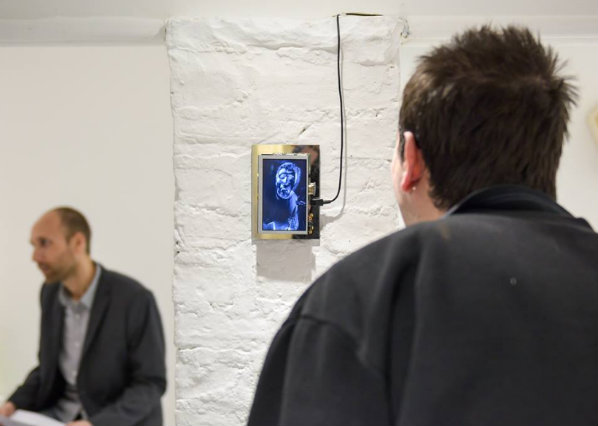
So far, Compiler has made a variety of spaces for conversation about digital culture through both its artworks and its organisation. Each artwork has a different ‘footprint’ of interactions, linking websites to rooms, success to failure, data privacy to financial transaction via consultation, and making interesting connections between CCTV and code, dance notation and HTML, activism and commerce.
An interesting way to read the Compiler platform is as a series of combinations of human-readable codes and machine-readable codes. The platform ‘compiles’ a different combination each time, and each time the output is different. Through this, the interaction of analogue and digital processes is demystified and muddled, in a distinct way. The platform is in its early days, but it seems likely that new connections and new grey areas will appear over the next few months, as Compiler has its second exhibition (again at OOTB) in May, takes part in the CCS conference at Goldsmiths in June and heads in other directions thereafter.
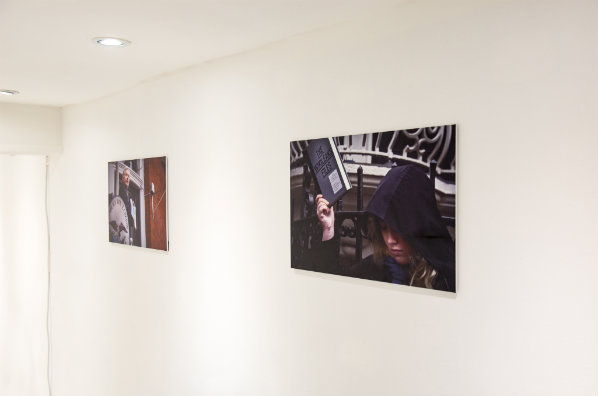
The exhibition offered plenty to play with, while posing complicated problems in relation to openness and experimentation. When I spoke to Eleanor, Tanya and Alisa about Compiler and its aim to engage local communities in networks of knowledge-exchange , we talked about how it’s an impossible and strange aspiration to have a ‘neutral’ venue. While a cocktail can be delicious and engaging, it’s also expensive. While a cafe is, arguably, a less exclusive space than a gallery, OOTB itself is a cafe which targets a specific audience. Drink prices, decor and a host of other factors mean OOTB, like all spaces, is politicised in a particular way. Their venue choices so far will influence, in subtle and overt ways, their future attempts to engage diverse local communities. The organisers of Compiler acknowledge this; their response is that rather than trying to make an artificial neutrality they are keen to move as the platform develops to new spaces and new and different contexts.
A change of context, message, communication style is not easy; nor does it fit with to an easily recognisable politics or aesthetics. Moving into and out of contexts is something to be done carefully and thoughtfully. It seems to me that the Compiler team will have their work cut out, but if they can direct that work in such a way that the platform is able to communicate in multiple ways at once, ‘networks of knowledge-exchange’ could develop between, and in response to, the markers set by the organisers. The question is, how will they develop?
Do you believe everything you said today? How can you trust what you feel? What is it about today’s truth that makes it so difficult to believe?
The journalistic affectation for pre-fixing all manner of phenomena with the term ‘post-’ has become commonplace over the last few decades. Post-capitalism, post-growth, post-normal, post-internet, post-work and post-truth are all concepts crystalizing around a pervasive sense of uncertainty, instability and social unrest. While I have the honour of guest editing the Furtherfield website for the next few months, I am hoping to bring together a number of writers, artists and thinkers who will, in various ways, explore two of the ‘post-s’ I find most urgent and compelling: post-truth and post-work.
Consolidated by Brexit and the US presidential campaign, and designated as word of the year 2016 by the Oxford Dictionary, ‘post-truth’ is now a term deeply engrained in the social and political imaginary. Since ‘post’ can signify the internalization of phenomena (the internet is inside us all), one might even say we are post-post-truth, living with it as a general condition of our reality. The post-truth condition privileges narrative over facts, appealing to people’s beliefs, ideologies, prejudices and assumptions, rather than presenting them with ‘evidence’. This is, of course, nothing new – facts have never been anything without subjective processes of interpretation, contextualization, manipulation and propaganda. As Simon Jenkins points out, ‘Of all golden-age fallacies, none is dafter than that there was a time when politicians purveyed unvarnished truth’ – lies are, he suggests, the ‘raw material’ of political narrative.

Social media holds the potential to both exacerbate and alleviate the chaos of post-truth reality. On the one hand the echo-chambers created by partisan social media feeds limit and blinker us; on the other, social media is a weapon being deployed by armies of citizen journalists and organizations committed to fact-checking and exposing political lies and obfuscation. To feel uncomfortable about the confusion and psychological strain arising from the post-truth condition is surely a reasonable human response. As Professor Dan Kahan suggests:
‘we should be anxious that in a certain kind of environment, where facts become invested with significance that turns them almost into badges of membership in and loyalty to groups, that we’re not going to be making sense of the information in a way that we can trust. We’re going to be unconsciously fitting what we see to the stake we have in maintaining our standing in the group, and I don’t think that’s what anyone wants to do with their reason’
What Kahan points to here is, I think, an opportunity to reflect carefully on the stake we have in maintaining our sense of identity and belonging through the ‘facts’ we choose to believe. Despite the discomfort we may feel, might there be a way to take advantage of this cultural moment? Perhaps recognizing our own doubts about credibility can become a fruitful catalyst for adjusting our sense of responsibility to engage with a range of news sources, listen to opposing points of view, and critically evaluate the information we are presented with. In fact, Kahan prescribes 10 minutes of doubt every morning to deal with the anxiety that arises from a feeling that you can’t trust your own feelings.
Can we have a good life without work, or is work part of what it means to live a decent life? What would you do if you didn’t have to work?
One of the most significant societal shifts taking place due to the advancement of technology is the transformation of what it means to work, and to be a worker. The nine to five is dead (or soon will be), and work is being radically transformed as a new global workforce comes online, technological innovations advance at super high speed, and new business models emerge. Automation is now a firm feature of mainstream discourse, and depictions of robots replacing jobs are everywhere in the global media imaginary.
The Bank of England’s chief economist recently projected that 15 million UK jobs will be lost to automation in the next 2 decades, which is equivalent to approximately 80 million US jobs. 47% of white collar jobs are predicted to be lost to automation by 2035, according to a 2016 report by Citi GPS and the Oxford Martin School at the University of Oxford. It is not just routine tasks that will be replaced – asset management, analytics, patient care, law, construction and financial trading can all be done (and is being done) by robots. Mining giant Rio Tinto already uses 45 240-ton driverless trucks to move iron ore in two Australian mines, saying it is cheaper and safer than using human drivers.
At the same time as these developments are evolving at break neck speed, we are living in an increasingly unequal world, where the gap between the rich and poor is getting bigger. According to a recent Oxfam report, 62 identifiable individuals own same wealth as poorest 50% of the world’s population – that’s 3.6 billion people. And 1% of the world’s population own more than the rest of us combined. Capital grows faster than labour, so if you’re already rich, your money earns more than your labour ever could, which reinforces existing wealth inequality. Furthermore, extreme inequality involves people thinking greedily about finite resources, and not seeing personal greed as having wider consequences. If people see that the 1% own more than the rest, there’s danger their response is to play same game and look to join that 1% (or 5%/10%)
Not everyone is equally equipped to deal with the changes ahead, but since artists, designers and critical thinkers are amongst the best-resourced to do so, I see it as our responsibility to consider how we can help others deal with what lies ahead. As with confronting post-truth reality, acknowledging a post-work future can be seen as an opportunity to forge a better path forward for ourselves and others. We might take a cue from what we know about post-truth, and try to create narratives (backed up by collectively verified facts) that persuade the world to proceed towards an equitable world of work where solidarity and cooperation can thrive.
The articles gathered over the next two months as part of my guest editorship of Furtherfield might be understood as moments of corrective doubt. They are an opportunity to speculate about issues of truth and labour, and to proceed as artists should – by imagining alternative realities and evolving conceptual, aesthetic and practical ways to inhabit them. You can expect revelations about the labour conditions of those who work for contemporary artists from Ronald Flanagan, reflections on robots in the workplace from Katharine Dwyer, and an interview about the repopulation of Monopoly with cryptocurrencies from Francesca Baglietto. Filippo Lorenzin will consider Dada as a response to the post-truth condition, Carleigh Morgan will consider what makes good curatorial practice in this contemporary moment, reorienting current discussions away from free speech absolutism vs censorship to questions of judgement and responsibility. Alex McLean will use the metaphor of weaving to consider the role of craft in a post-work society. How might coding be understood as a form of textile liberated from its militaristic origins?
Happy doubting to all.
The productive alliance between instruments of computing techne and artistic endeavour is certainly not new. This turbulent relationship is generally charted across an accelerating process outwards, gathering traction from a sparse emergence in the 1960s.[1] Along the way, the union of art and technology has absorbed a variety of nomenclatures and classifiers: the observer encounters a peppering of computer art, new media, Net.art, uttered by voices careening between disparagement, foretelling bleak dystopian dreams, or overflowing with whimsical idealism. Once reserved for specialist applications in engineering and scientific fields, computing hardware has infiltrated the personal domain.Today’s technology can no longer be fully addressed through purely permutational or systematic artworks, exemplified in 60’s era Conceptualism. The ubiquity of devices in daily life is now both representative and instrumental to our changing cultural interface. Technologies of computing, networks and virtuality provide extension to our faculties of sense, allowing us phenomenal agency in communication and representation. As such, their widespread use demands new artistic perspectives more relentlessly than ever.
I, and no doubt many other academic observers, watched the Pokemon Go augmented reality (AR) game erupt into a veritable social phenomenon this year. The rapid global uptake and infiltration of AR in gaming stands in contrast to new media arts, still subject to a dragging refractory period of acceptance and canonization. Perhaps this is emblematic of a conservative art world that persistently recalls an ebullient history of computer art practices. In this lineage, many a nascent techno-artistic breach has been accused of deliberate obfuscation, of cloaked agendas under foreign (‘non-art’) orchestrations.[2] The seductive perceptual forms elicited through augmented reality (AR), virtual reality (VR) and immersive reality (IR) devices can be construed as mere spectacle, vulnerable to this type of critique. “Google Daydream” and “HoloLens” chime with a poetic futurism; cynics might instead see ready-to-wear seraphs veiling the juggernauts of Silicon Valley. However, the current groundswell in altered reality discourse may signal a divergence from such skepticism. One recent exemplar is Weird Reality, an altered reality conference that aimed “…to showcase independent and emerging voices, creative approaches, diverse and oftentimes marginalized perspectives, and imaginative and critical positions…. that depart from typical tech fantasies and other normative, corporate media.”[3] This is representative of the expanding, international trend towards artistic absorption of new media and technologies. It is a turn that emphasizes the potential for cultural impact, experimental daring, and even conjures the spectre of the avant-garde: radical transformation.
One of my PhD supervisors wisely admitted “…to stand out, the human artist must be more creative, diversified and willing to take aesthetic and intellectual risks. They can and must know the field they are creating in practically and philosophically, and confidence in their position and contribution to it is essential.”[4] Through this earnest lens, artistic production can serve as a conduit for ideas ranging from the speculative to the revelatory. In these divinations, we might trace a path through the sprawl of new media discourses, and find ourselves somewhere unexpectedly revitalizing. I hope to mark out some of this territory from a position of mediation. I want to invite art and art theory into an arena of uninhibited collusion, using critical writing to facilitate the exchange between digital media theorists and artistic practitioners in the most open sense. Furtherfield.org offers an allied platform for the aims of the Theory, Meet Artist [5] project, articulated here in an interview dialogue.
Originally published in The Fibreculture Journal, Edwina Bartlem’s 2005 article Reshaping Spectatorship: Immersive and Distributed Aesthetics proposes that immersive artwork practices have transformative potential. Across a range of modalities, these works can influence perceptions of ourselves and our extended digital presence in a variety of scenarios and configurations. Whilst participating in such practices, we are prompted to consider IR encounters as form of mediation around our human embodiment, subjective identities and cultural interactions. Bartlem touches on ideas of prosthesis and sensorial augmentation within these immersive experiences. Creation of a synthetic environment is posited as an opportunity for deepened self-reflexivity and awareness.[6] In parallel, a spectrum of narratives around the technologically adapted ‘post-human’ emerge. Their tone and reception hinges upon the artist’s individual performance in roles such as programmer, director, composer or overseer to such works.
Rachel Feery is an Australian artist interested in the intersection of visual art, soundscapes, video projection, experiential installations and technology. Her artistic practice explores alternate realms, the meditative headspace, ethereal imagery and immersive environments. For this interview, Bartlem’s paper is positioned alongside and in dialogue with Feery’s work, Clearing the Cloud.
Clearing the Cloud is described by the artist as “… a multi-sensory work inviting pairs to cloak-up, complete a circuit, and experience simultaneous mapped projections visible through a hooded veil. The artwork aesthetic draws from esoteric sciences and holistic health practices. The environment is intimate, quiet much like a room where one would go to receive therapeutic treatment.
Two participants at a time are invited to cloak up, remove their shoes, and step onto sensors on the ground to generate a circuit of light and sound. Starting with a ‘personalised scan’ followed by a projection of light and sound, all visible and audible within the suit itself, the individuals can either interact with each other or be still and silent. The robe, constructed of a semi-translucent, lightweight fabric with a soft skin-like texture acts as a supplementary skin. One’s field of vision is slightly inhibited by a lightweight mesh that both creates a screen-vision as well as the ability to see through it.”
Jess Williams: I first came into contact with your practice during your talk for Media Lab Melbourne in September this year. You chronicled your process, influences, past works and brought us to Clearing the Cloud. I was struck by the experiential intimacy of the project, and the immersive qualities that you deployed though staging it. In her paper, Bartlem suggests that participants in immersive practices cannot be immersed without being affected by the environment on perceptual, sensory, psychological and emotional levels. What kind of sensorium did you want to create for Clearing the Cloud, and did you contemplate the possibility of this type of affective influence on your participants?
Rachel Feery: In one sense, the project came about while I was thinking about art as therapy, and thinking about technology that has the potential to create a meditative space. The site of the exhibition, Neon Parlour, was previously a centre for healing and meditation. I wanted to create an intimate room that would reflect the building’s history. Speaking of the sensorium, I was drawing from esoteric sciences, looking at auras, and Reiki practices whereby chakras are ‘cleared’. This is all reflected in the visual and environmental elements of the work, but ritual aspect is key. It’s important for participants to enter the artwork through the process of putting the garment on. The ritual is something you have to experience with someone else, and there’s a synchronicity between the people who participate. If either person takes their feet off the sensors, the ‘therapy’ is reset. It becomes apparent that there’s a level of commitment to it, that there’s a trust involved. If one person backs out, the interaction stops and resets.Clearing the Cloud ultimately asks participants to commit and experience the work together. Some participants responded that they felt lighter, and that time had passed out of sync with the seven minutes that had passed in reality. I thought this was an interesting reaction when nowadays, our attention spans are said to be dwindling. I feel there’s something significant in a lot of those esoteric sciences.
JW: Bartlem maintains that immersive art offers more than pure escapism into a constructed simulacra. These types of artworks can also elicit a type of self-awareness or meditation on perception and one’s own agency in the prescribed environment. I’ve noticed a strong tendency to consider transcendence, or the superhuman, in many futurist discourses around technologies that interface with the human body. This spans augmented reality, virtual environments and may well capture less conspicuous (yet ubiquitous) examples, such as fitness metrics or geolocation of the self through GPS. How do you position narratives of extending or ‘hacking’ embodiment within your own work?
RF: There’s an aspect of being both physically present and also outside of yourself whilst engaged in Clearing the Cloud. As a participant, you find yourself looking through a meshed veil that’s being projected on, and if you adjust your focus, you can see coloured projections on the other participant. This dual, simultaneous vision got me thinking about the ways that newer technologies such as AR and VR can affect what we see and the way that we see. Essentially, those applications allow you to see an environment with a filter over it. You have the sense during the ‘clearing therapy’ of an outer body experience, which is something that certain types of meditation aspire to. Escapism can imply you’re ignoring what’s happening in the outside world and going inside yourself, or elsewhere. But technology is blurring these boundaries, becoming increasingly intertwined in everyday activities, both personal and shared. You’re not really escaping if there’s an application present to assist with something, provide new information, or an augmented experience. In that sense, I would agree that it’s not pure escapism. You’re in two places at once. I would say that the word escapism has darker implications, such as detachment and avoidance of reality over a virtual space. Meditation, however, is affiliated with deeper understanding of oneself, and acceptance and appreciation of both worlds. As technology gets more advanced, I think it will have the ability to do both.
I like the idea that two people willingly participate in this scan and projection without question. I feel it relates to this influx of new technology applications that are free and that everyone’s willing to try. On the darker side, I wonder about the consequences of giving away information- effectively, parts of yourself- to participate in the unknown. I also like the idea that Clearing the Cloud is presented as a holistic therapy, a gesture of removing the build-up of accumulated information, or as protection from the data mining we’re exposed to through technological interfacing. We’re made vulnerable to hacking, but in a sense it’s not really hacking anymore, it’s just collecting what we’ve been giving. There’s such a rush to use new applications and technologies but everything is untested. Essentially people become trial subjects through their willing self-disclosure.
JW: You mentioned David Cronenberg’s 1999 film eXistenZ as a formative influence in your creative development. Underpinning the science fiction and horror themes, a specific abject revulsion is reserved in this film for prosthetic extension and modification to the human body. Could the veils (with their accompanying perceptual experiences) used in Clearing the Cloud be viewed as a form of sensory prosthesis?
RF: I would say I was more interested in the idea of accessorising tech, rather than prosthetics. I am drawn to the way that Cronenberg’s characters leave their physical body and enter another state, but again, this is quite geared towards escapism. Using the veils arose through researching a mix of religious and medical robes, futuristic fashion and science-fiction inspired fashion. They all seemed to be white. There’s also a relationship with the cloak to other forms of wearable technology. I’m interested in this – in Google Glass, VR headsets, and related items – as both a current fashion trend and also as a subtle way that technology encroaches on our day to day lives, present as we move through and see our worlds. While I perceive the cloak itself is not so much of a prosthesis, there are certain physical qualities of the material that feel both organic and synthetic. They’re made of a foggy, PVC translucent plastic: when worn, this fabric feels like a skin. The backwards-oriented hood also functions as a way to obscure the face, and presents a form of anonymity that is ultimately within the concept of ‘being cleared’ and ‘regaining yourself.’ There are other associations too: of a uniform, of being part of a community that has been cleared, or erased.
JW: Typically, when audiences are presented with new media or computer mediated artworks, they have limited access to the operational interior of the encounter. Whilst it can be argued that more traditional media or installation works also don’t completely disclose their construction or authorship, new media practices seem subject to increased scrutiny and distrust around how- and to what end- they operate. In her paper, Bartlem proposes that instead of masking the presence of technology and interface, immersive artworks tend to overtly emphasize the synthetic artifice of the experience. In regards to revealing the hierarchies of control implicit in executing works like Clearing the Cloud, how much do you wish the audience to have a certain ‘privilege of access’? For example, do you consider it necessary to directly reference programming script, hardware circuitry, or technologies of surveillance?
RF: The actual technology used in the exhibition was not necessarily about aesthetics. Hardware and devices, such as projectors and Raspberry Pis, were not elements that I wanted audience attention drawn to. Moreover, I think if you give spectators interior access, it can take away the simplicity of the art experience. The most that I would give away would be the materials visible or listed in the artwork. I actually tried my best to mask the technology, hiding cords and mounting the projectors up high to make it feel innocuous and to minimise its physical presence. Once people can identify familiar tech, there is an immediate undermining of mystical impact. For this artwork, I worked with artist and technologist Pierre Proske to write a code that triggers the projection once the sensor pads are activated. The hardware elements are present, but they’re definitely not the focus. Rather, it’s the experience itself, the meditative space created that participants are made most aware of. I think that’s why auras, and energy healing, are so fascinating: they rely on people’s ability to embrace and believe in the healing process, which in turn requires any distractions or doubts to be removed- or at least obscured. Obsfucation was deliberately built into the back-to-front hoods used in Clearing the Cloud. Restriction of the visual frame of reference was intended to encourage immersion in the experience.
JW: As we’ve discussed, the eponymous gesture of “clearing the cloud” reads as recuperative, meditative, and somewhat subversive towards strategic or commercial use of new technologies. This is a position that Bartlem suspects is endemic within artistic instrumentalisation of these types of media. Do you feel a sense of alignment with a more radical manifesto in new media practice?
RF: A lot of my ideas draw from or relate to concepts that have been proposed in science-fiction films… science-fiction is radical. Sci-fi extrapolates the current social, political or technological trends, or explores alternate models. Clearing the Cloud also proposes a need for something that hasn’t quite been quantified, a therapy to restore and protect from encounters with technology. Clouds traditionally connote lightness, and formlessness, but today they weigh heavily on us in a digital data context. We carry more and more information, and give more and more of ourselves. We’re now clouded by our metadata trails, and it’s radical to think that a therapy can address this, and return us to a state of clarity, in a literal and metaphysical sense.
JW: After your talk, I asked you a question around whether Clearing the Cloud‘s artistic narrative could function beyond a ‘closed-circuit’ proposition. Whilst Bartlem scopes immersive and telepresent practices in her paper, she doesn’t directly address works that hybridise the two concepts. She frames telepresent artworks as those that link participants from distant locations, precipitating notions of networks and a multi-user participation within art. How would a multiplicity of network relations impact on a scenario like that you have staged in Clearing the Cloud?
RF: An excellent question, and very relevant to the nature of the work. The participant’s experience centres on a propositional ‘defrag’ of their personal hard-drives, regaining clarity, allowing independent thought free from the prison of past browsing histories and metadata maps. Those in a networked community also benefit from this speculative process: the more persons ‘cleared’, the stronger the authentic connections would be. If you were to be ‘cleared’, and your online history erased, the persons closest to you would also need to be erased in order to completely eliminate any trace of you. It’s like a chain reaction. Although only two people might be scanned at a time, for a complete ‘clearing’ you would need the eventual interfacing of everyone you’ve ever come into contact with. Ideas around utopias were intrinsic to the development of Clearing the Cloud. In one view of the work, those people who have been ‘cleared’ became part of a separate, even sanctified community. This meditation was idealistic, borne of the desire to find a way to protect our identities and those of our networks when they are potentially threatened or compromised by interactions with technology.
Clearing the Cloud was originally exhibited in 2016 as part of This Place, That Place, No Place curated by Irina Asriian (Chukcha in Exile) at Neon Parlour, Melbourne, Australia.
‘Seeds From Elsewhere’ (2016 – ongoing) is a project by They Are Here that has begun to re-animate a dilapidated play area in Finsbury Park, bringing together young asylum seekers and refugees, family, friends and other professionals. Each participant is supported to grow flowers, plants or edible produce from their respective homeland. We are also in the process of designing a greenhouse and pizza clay oven, extending the parameters of our collective activity. Throughout the process we literally and metaphorically ask ‘What can grow here that’s not from here?’ Beyond this more tangible gardening activity, the project seeks to create a space that embraces, maintains and produces a diverse set of social relationships between people with different residency status. It is supported by Furthefield an organisation exploring the intersection of networked culture and contemporary art.
It was July 2016, less than a month after the results of the United Kingdom European Union membership referendum, when our project commenced. Although the impetus to begin was not a conscious response to the referendum outcome – the timing is not insignificant. Our initial steps were in a toxic political atmosphere at the height of an intensified and indiscriminate rhetoric against migrants.
Artists were faced with new variations of old questions that resurface in turbulent times. . . What is our role in protest? Do we have a particular responsibility as artworkers to engage with a given political landscape? What are the capabilities and limitations of art in local / national / international governmental politics? Such questions often reveal an expectation of certain aesthetics, rather than attitudes. It is in the multiple ways that a work is circulated and produced its politics should be sought. . . How is the work funded? How is it credited? Which voices are included in its development, or excluded? How is the work talked and written about by the various partners supporting its production?
In these seemingly small details, a larger political statement is embodied rather than solely visually evoked. At the same time, we reject a ‘one-or-the-other’ stance. Establishing and administering a small community garden should not negate working with others on larger-scale efforts at the scale of local government or beyond. Bridges should be made between all scales of activity. The same fluid hierarchies and embrace of hybridity we cultivate with Seeds From Elsewhere, we encourage at ever larger scales – generating continuities between the ethos of how we are working on the garden and how national and global resources are considered and decisions made.
‘Participation is not always progressive or empowering’, ‘Realise your own privilege’, ‘Critically interrogate your intention’, ‘Process not product’, ‘Presentation vs representation – Know the difference!’, ‘Do not expect us to be grateful’, ‘Art is not neutral’, ‘It is not a safe-space just because you say it is,’ ‘Do your research’, ‘ Do not reduce us to an issue’. These notes are from Rise (Refugees, Survivors and Ex-detainees – the first refugee and asylum seeker organisation in Australia to be run and governed by refugees, asylum seekers and ex-detainees) . . . 10 Things You Need to Consider If You are an artist not of the Refugee and Asylum Seeker Community Looking to work with our Community authored by Tania Canas, RISE Arts Director.
In a polarised mediascape, where tabloid headlines shout loudest, the reduction of a diverse group of people to an ‘issue’, has been one of the most problematic aspects of public debate. Recognising that Seeds From Elsewhere is a slowly gestating project affords time for us to slowly get to know the participants individually – who to date hail from Albania, Sudan, Congo, Ethiopia, Romania, Afghanistan & Nepal. Rather than seek to ‘represent them’, we are co-workers on a set of shared goals.
Importantly, this work functions as a hybrid activity, with multiple points of access and identification. For the young refugees the garden can offer a respite from various kinds of bureaucratic limbo, it can also simply be a place to chill in a tolerant environment. In the longer term, there maybe be the potential for employment opportunities in the garden. At the same time, the work functions within the tradition of many conceptually driven socially-engaged artworks, notably Wheatfield – A Confrontation (1982) by Agnes Denes, Edible Estates (2005 – ongoing) by Fritz Haeg and Parkwerk (2014) by Jeanne van Heeswijk.
The project has also become a gateway to consider the language of rhetoric against migrants, as well as that of sympathetic media too, focusing on the recurrence of botanical language as metaphor (soil, roots etc). Essays by US-based anthropologists Dr. Lisa Malkki and Dr. Stefan Helmreich have been particularly insightful. The latter quotes biologist Banu Subramniam, noting that these criteria ‘resonate unfortunately with xenophobic anti-immigration language in the United States and Europe’:
“The parallels in the rhetoric surrounding foreign plants and those of foreign peoples are striking … The first parallel is that aliens are ‘other’ … Second is the idea that aliens / exotic plants are everywhere, taking over everything … The third parallel is the suggestion that they are growing in strength and number … The fourth parallel is that aliens are difficult to destroy and will persist because they can withstand extreme situations … The fifth parallel is that aliens are ‘aggressive predators and pests and are prolific in nature, reproducing rapidly’ … Finally, like human immigrants, the greatest focus is on their economic costs because it is believed that they consume resources and return nothing.” [1]
Becoming attuned to language is a vital part of a larger and never-ending exercise in developing cultural and individual self-awareness as to how we speak, itself inseparable from how we think.
Our fortnightly group meetings in the garden are rich in debate and banter. Working on a garden is an unceasing process. Like the growth of plants themselves, it cannot be rushed without compromise. This notion of maintenance is akin to a healthy democracy. Rather than an invitation to vote every four years, democracy must be attended to daily; it is comprised of multiple systems collectively supporting each other. Beyond physical access to a voting booth, there is the need for both protection and scrutiny of the media, investment into an education system that encourages voters to make informed choices, the space for satirists, philosophers and artists to critique power and the continual checking of our own presumptions and privileges.
Harun Morrison + Helen Walker
They Are Here
February 2017
contact@theyarehere.net
Choose Your Muse is a new series of interviews where Marc Garrett asks emerging and established artists, curators, techies, hacktivists, activists and theorists; practising across the fields of art, technology and social change, how and what has inspired them, personally, artistically and culturally.
Gannis is informed by art history, technology, theory, cinema, video games, and speculative fiction, expressing her ideas through many mediums, including digital painting, animation, 3D printing, drawing, video projection, interactive installation, performance, and net art. However, Gannis’s core fascinations, with the nature(s) and politics of identity, were established during her childhood in North Carolina. She draws inspiration from her Appalachian grandparents singing dark mountain ballads about human frailty, her future-minded father working in computing, and a politicized Southern Belle of a mother wearing elaborate costumes, performing her prismatic female identity.
“I am fascinated by contemporary modes of digital communication, the power (and sometimes the perversity) of popular iconography, and the situation of identity in the blurring contexts of technological virtuality and biological reality. Humor and absurdity are important elements in building my nonlinear narratives, and layers upon layers of history are embedded in even my most future focused works.” Gannis.
We begin…1. Could you tell us who has inspired you the most in your work and why?
The complete list of people who have inspired me is inordinately long. I’m sharing with you here clusters of some of the “most most” inspiring.
Lynn Hershman Leeson, Maya Deren, Lady Ada Lovelace, Mary Wollstencraft – I saw Lynn Hershman Leeson’s Conceiving Ada in the late 90s. It was my first introduction to her work, and
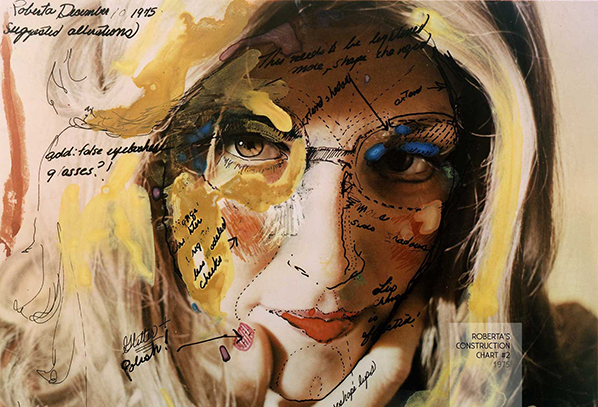
I have been blown away by her prescience ever since. Deren, Lovelace, and Wollstencraft, like Leeson, have all been groundbreaking in their creative, scientific and intellectual contributions to humankind.
Yael Kanarek, Marge Piercy, Octavia Butler, Sadie Plant, Jonathan Lethem, Harry Crews and Flannery O’Connor – Artist Yael Kanarek’s “World of Awe” was one of the first net art pieces, through its poetry and world building, to inspire me to transition from painting into a new media arts practice. Piercy and Butler are two favorite authors, and they have both written novels where women travel into the past and to the future to reconcile their identities, to come to terms with their present selves — themes that constantly recur throughout my work. Plant opened up broad vistas to me as a woman and feminist working with technology, and the melange of genres Lethem mashes up in his fictional works: sci fi, noir, autobiography, and fantasy, appeals to my own hybrid sensibilities. Crews and O’Connor testify to the absurdity of the human condition, and being a native of the “American South,” their gothic sensibilities resonate with me deeply.
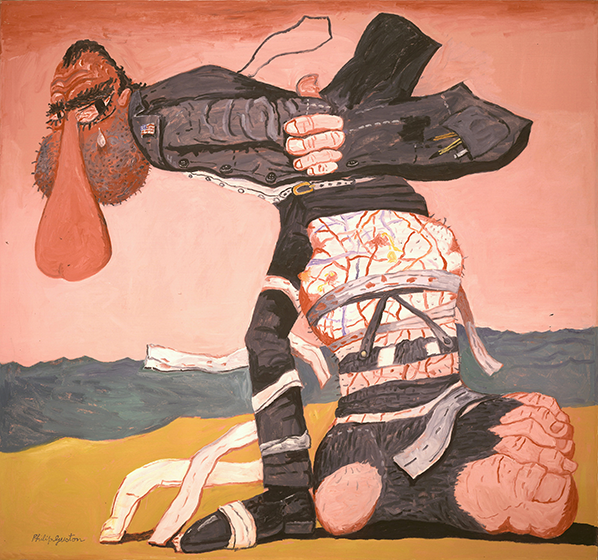
Philip Guston, Suzanne Valadon, Artemisia Gentileschi, Louise Bourgeois, Hieronymus Bosch and Giotto di Bondone – I studied painting at a school where Guston had taught (many years before I arrived there), and coincidentally we share the same birthday. I have always felt a very strong connection to his work, particularly to his late work, where he resisted the art establishment and made pictures that he felt truly represented his time. Valadon, an autodidact, likewise bucked the conventions of 19th century “lady painting” focusing on the female nude throughout her oeuvre. Gentilsechi in the 17th Century established herself as an artist who painted historical and mythological paintings, rendering women with more agency and strength than her male contemporaries. Bourgeois’s work, the rawness of her drawings particularly, were quite significant to me as a young artist. Twice I got to attend her Sunday Salons in New York, sharing my work with her. She was a tough critic by the way. Bosch and Giotto have long been favorites, the enigmatic quality of Bosch’s vision, and the amalgam of Medieval and Renaissance perspectives colliding in Giotto’s paintings.
Charlie White, Laurie Simmons, Gregory Crewdson, Renee Cox & Cindy Sherman – I think of these photographers as important conceptual forerunners of a Post-Photography movement that seems to be reaching its apogee now. They were each essential to me as I searched for a new aesthetic language, after throwing away my oil paints and canvases.
And today there are so many younger artists who I have deep respect for, Gretta Louw, Angela Washko, RAFiA Santana, Jeremy Bailey, Lorna Mills, Andrea Crespo, Clement Valla, Faith Holland, Jacolby Satterwhite, Morehshin Allahyari and Alfredo Salazar-Caro (to name only a few). They all have significant presences online, and I encourage readers to “google them” for glimpses into the contemporary visions that are shaping and predicting our future.”
2. How have they influenced your own practice and could you share with us some examples?
In my teens and 20s I copied much of the work of my sheroes and heroes. There is little I can share with you of that work now, as I’d copy then delete back then. To be more accurate, since it was physical work, I’d copy and destroy. I destroyed more work than I saved until I found a way to absorb and remix through the filter of my own identity.
Today I identify as a visual storyteller who cuts and pastes from the threads of googleable art history, speculative fiction and networked communication in efforts to aggregate some kind of meaningful narrative. Appropriation feels like an authentic artistic response to mediated culture, registering at a different conceptual frequency than simple mimicry. I mean making a painting like Giotto or Bosch doesn’t make sense in the 21st century, well, unless you “emojify” it (wink). Here is one recent work where my quotation is obvious, “The Garden of Emoji Delights.” In the other works below, a collection of influences are embedded, but perhaps less perceptible on first glance.
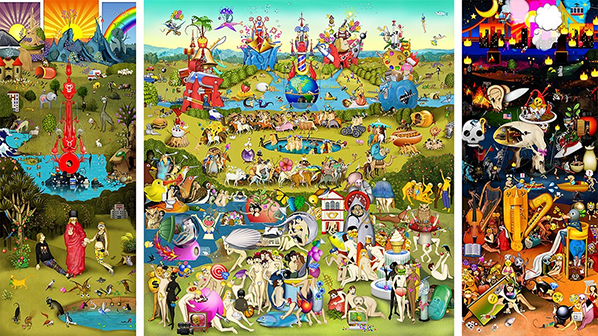


3. How is your work different from your influences and what are the reasons for this?
It is essential that my work be different semiotically from the historical influences I mentioned above, if I am to actually understand the nature and power of their work — how each of them were incredibly perceptive and responsive to “their time.” They produced authentic images or texts (or code) that were assembled from aspects of their cultural milieu. Their expressions were comprehensible to their contemporaries, even if at times only a few of their peers engaged. Communication is key to every human enterprise. Nonetheless the infinite (and often futureminded) perspectives of these historical figures still reverberate in our contemporary collective consciousness and influence us to “perceive differently” in our own time.
To be different from influences who are of my own time also involves comprehending why they have an impact on me. They avoid any kind of creative and intellectual status quo. Being unique seems improbable in the internet age, but there are still innumerable ways that we can creatively parse our relationships to the past, present and future, both in concert and contrast to one another.
4. Is there something you’d like to change in the art world, or in fields of art, technology and social change; if so, what would it be?
There are many art worlds. In the more mainstream, celebrity-dominated, auctioneer enabled art world, whose market I rarely follow, but when I do, I find it to be bloated by One Percenters consumed by commodities trading, I would advocate for, if I had the power to do so, more economic temperance, less aura fetishization, and yeah, VR headsets that provide clothes for hackneyed metaphors.
It’s demoralizing that I cannot foresee, at least in the short term, a world without radical income inequality. Our world continues to be populated by a majority of “have nots” who are dominated by a tiny dominion of “haves.” It seems in every financial, social, educational, and entertainment sector, including the visual arts, capital obstructs as much as it supports creativity. Still I believe that the “other art worlds” can and will affect, actually currently are affecting change (incremental as it may seem), through social advocacy programs that embrace and foster diversity; through economic and technological models that celebrity the ubiquity instead of the scarcity of contemporary digital art; through independent artists who define their success in terms of cultural, instead of, or in addition to market value.
Positive changes are happening. Compare our cultural landscape to even two decades ago, and we see a much more diverse population represented in the arts. A new generation of artists and technologists are hopeful about their capacity to shape a better future, while being mindful of what’s a stake if they do not.
That said, and to finally answer your question directly, I’d like to see a change — a major turn in the tides of fascism, racism, xenophobia, and misogyny that are flooding countries around the world — so that the various art worlds, the ones that frustrate me, and the ones that inspire me, can survive.

5. Describe a real-life situation that inspired you and then describe a current idea or art work that has inspired you?
Sitting with and drawing digital portraits of my 99 year old Grandma Pansy Mae in January of 2015 inspired me to begin “The Selfie Drawings” project. Being in the presence of someone who has witnessed so much radical social and cultural change, over the course of almost a century, motivated me to interpret, and then stage a series of reinterpretations of myself/selves, within the context of a post-digital age. Pansy Mae was a woman born before women had the right to vote in the United States, a woman with only an 8th grade education who raised my mother, and myself to never let our gender or our class (personally) deter us from pursuing our ambitions. Grandma is now 101 years old, and I wished her Happy Birthday in binary code this past December 31st.
“Nasty Woman” is a current meme that has really struck a chord with me. I have worn a “Nasty Woman” necklace everyday, since November 7th, (the day I picked it up from the studio of artist Yael Kanarek). Embracing the nomenclature that was meant to denigrate a woman has instead empowered and galvanized a collective of women as they face, and resist, the alarming possibilities of increased subjugation under Trump’s leadership.
I recently participated in the NASTY WOMEN exhibition in New York city, (which raised over $42,000 for Planned Parenthood), because I am such a woman, a nasty woman, a bitch, a Jezebel — a complex and empathetic human being who believes change and equality can only occur when we speak up, when we eschew “politeness” in the face of serious threats to our autonomy and personhood.
6. What’s the best piece of advice you can give to anyone thinking of starting up in the fields of art, technology and social change?
I’ve got a few bits of advice. First, as an artist, work; as a technologist, feel; and as an advocate for social change, empathize. Then toss up your FEW cards (feel, empathize and work) and apply them to other aspects of your life as well.
Secondly I suggest losing, if you possess, the sense of what you think you’re entitled to because you are more special and deserving than others. This doesn’t mean you deny the gifts you possess. Nor does it mean you eschew your ambitions or balk at your successes. Brand yourself, or your cause, by all means, if that informs your practice or generates support for your work. But the “I’m a genius, so I have the right to be licentious, egotistical and completely selfserving at the sacrifice of others” trope may (temporarily) get a man into the White House, but generally is tiresome, if not loathsome, to progressive art professionals.
7. Finally, could you recommend any reading materials or exhibitions past or present that you think would be great for the readers to view, and if so why?
What I’ve been reading lately: Object Oriented Feminism edited by Katherine Behar; Artemisia Gentileschi, The Language of Painting by Jesse Locker; Lynn Hershman Leeson Civic Radar edited by Peter Weibel; Hope in the Dark | Untold Histories, Wild Possibilities by Rebecca Solnit; The Year of the Flood by Margaret Atwood
I recommend these books as a resistance to sophomoric twitter threads usurping all of your attention.
Pipilloti Rist : Pixel Forest New Museum, http://www.newmuseum.org/exhibitions/view/pipilotti-rist-pixel-fores
It is okay for art to wash over you, so that you can revel, even relax, in its beauty…for a while.
____________________________________________________________________
Monster of the Machine : Laboral
curated by Marc Garrett http://www.laboralcentrodearte.org/en/exposiciones/monsters-of-the-machine
A timely and provocative exhibition (thrilled to have work included).
__________________________________________________________________
Dreamlands: Immersive Cinema and Art 1905-2016
http://whitney.org/Exhibitions/Dreamlands
A landmark show for moving image works!
__________________________________________________________________
Women’s March On Washington (Saturday, January 21st!) https://www.womensmarch.com/
…or one of the other 386 protests taking place on the same day around the world!
https://www.womensmarch.com/sisters
#notmypresident
Choose Your Muse Interview: Jeremy Bailey | By Marc Garrett – 26/06/2015
http://furtherfield.org/features/interviews/choose-your-muse-interview-jeremy-bailey
Choose Your Muse Interview: Annie Abrahams | By Marc Garrett – 10/09/2015
http://www.furtherfield.org/features/interviews/choose-your-muse-interview-annie-abrahams
Choose Your Muse Interview: Lynn Hershman Leeson | By Marc Garrett – 13/07/2015
http://www.furtherfield.org/features/interviews/choose-your-muse-interview-lynn-hershman-leeson
Choose Your Muse Interview: Stanza | By Marc Garrett – 03/11/2015
http://www.furtherfield.org/features/interviews/choose-your-muse-interview-stanza
Choose Your Muse Interview: Igor Štromajer | By Marc Garrett – 09/06/2015 http://www.furtherfield.org/features/interviews/choose-your-muse-interview-igor-%C5%A1tromajer
Choose Your Muse Interview: Mike Stubbs, Director of Fact in Liverpool, UK | By Marc Garrett – 20/05/2015
http://www.furtherfield.org/features/interviews/choose-your-muse-interview-mike-stubbs-director-fact
Feature image: Winchester School of Art Exhibition of Data Asymmetries. Image Credit: Olcay Öztürk
Burak Arikan is one of Turkey’s leading media artists, a figure who straddles the lines between technologist and practitioner. He explores relations between data and transactions, the regimes of datafication and identification as control, and maps relations of power and invisible infrastructures with network mapping tools. According to new media theorist Jussi Parikka, Burak’s pieces “raise questions of the predictability of ordinary human behavior with MyPocket(2008); reveal insights into the infrastructure of megacities like Istanbul as a network of mosques, republican monuments and shopping malls (Islam, Republic, Neoliberalism, 2012); remap and organise recurring patterns in the official tourism commercials of governments with Monovacation (2012); explore the growth of networks via visual and kinetic abstraction with Tense (2007-2012); and showcase collective production of network maps from the Graph Commons platform.”
Burak’s creation of the Graph Commons, an online network mapping tool, is an open platform for the creation of networks that encourages its users to explore the functional limits of network architectures as a mechanism for storytelling, data visualization, and modelling our contemporary moment, from graphing financial microtransactions to mapping superstructures splayed across a continent.
Burak Arikan’s most recent body of work, Data Asymmetry, was hosted at the Winchester School of Art from November 10-24, 2016. His network mapping tool, Graph Commons, is viewable here.
In the first of this two part interview series, Carleigh Morgan speaks to Burak Arikan about his practice. In the second part of the series Morgan interviews Jussi Parikka about Arikan’s work and the way data and networks condition and build the way we view and interact within the world.
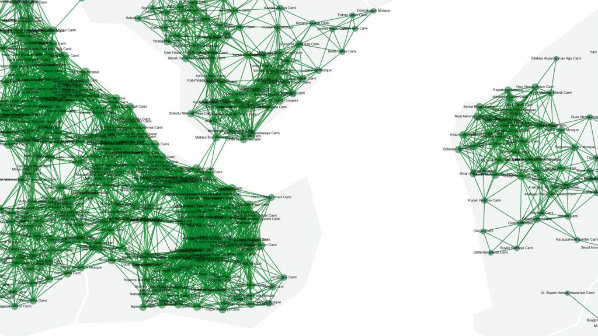
CM: The aim of the Graph Commons is to “empower people and projects through using network mapping, and collectively experiment with mapping as an ongoing practice.” But every visualising methodology has its hermeneutical blindspots and invisible shortcomings.
With those boundary constraints and affordances in mind: What are networks in art, and how are they are extensions of or departures from the networks that they attempt to depict?
BA: I use network as a map vs network as an event separately in my work.
Network as a map is simply using dots and lines to represent observed or measured relationships in order to explore the structures of rather complex systems in life. For example, I am interested in revealing the institutionalization without walls in the world of art, so I look at relationships of artists exhibiting together with other artists, art institutions related by the artists they show, influence of collector-artist relations etc. Such network mapping reveals central actors, indirect connections, organic clusters, structural holes, bridging actors, outliers etc. Network mapping provides a view of such qualities about that particular art world that you wouldn’t see otherwise.
A network map is both a visual and a mathematical language, that you can visually follow dots and lines with your eyes, as well as apply calculations on this data diagram. When you simply record and measure activities as data points, then you can link them to generate more insight and value from the linked whole than the sum of its parts. This is typical data linking method is commonly employed in security, marketing, finance, and social media industries by governments and corporations. One position I have in my art is to use such data mapping and analysis capacity on power relationships, mapping the ones who are mapping us. No need to say, my work is not necessarily about the internet of art things, but I’ve been interested in revealing the relations at scale in variety of fields ranging from juridical systems to cinematic languages.
Network as an event is a living substrate, it is people hanging out together, machines transmitting data packages, neurons firing signals, online platforms for social networking, physical ecosystems of humans and animals where widespread infectious disease can occur. These are physical, digital, hybrid living and multilayered systems maintained by diverse interactions between independent agents, where their small interactions governed by certain protocols together constitute an ever changing larger whole. Building a living network, or network as an event is another line of effort I’ve been pursuing in my work. For example, in 2007 I’ve built Meta-Markets, an experimental online stock market for trading social media profiles, where users did IPO (Initial Public Offering) their profiles and traded with others, with a goal to evaluate the value of a social media profile, the information you cannot get from the service provider company. It ran for 2 years and a community of members formed a dynamic trade network among a couple of thousand social media profiles.
CM: What types of agencies do network maps engender their makers with, and what kinds of constraints to they bring to bear on their creators? As an artist who works with the form of networks, have you witnessed a formal re-alignment of your thinking to reflect these structures? Through ongoing interrogations with and construction of networks as an aesthetic model, would you consider yourself more alert to the networks that condition our contemporary moment?
BA: As with any research, network maps are subjective too. Because by just measuring a reality you claim a subjective position. Thus, data points are always generated, rather than collected. Furthermore, network diagrams are usually totalizing and contemplative. As McKenzie Wark writes criticizing Frederic Jameson’s cognitive mapping: network maps freeze into a contemplative totality that prescribes an ideal form of action that never comes.
My network mapping work starts with raising new questions on critical relations that scale. Then I conduct research to generate data about a “particular world”, which enables many stories, interpretations, and use cases.
As a response to the lack of the “dialectical” in the frozen totality of static diagrams, I started using algorithmic interfaces in my installations. Such interactive network maps let you touch and change the positions of the dots on a map, yet browse the names without losing their relationality to each other as the software simulation continuously organizes the network layout. This way, normally invisible relations not just become visible, but also touchable, which enables us to effectively explore the chain of influences and relationality at scale. Touching the nodes also displays information cards, where you can get richer information about individual data points. By using an algorithmic interface you navigate back and forth between an abstract large picture and concrete juicy details of a complex issue. I think such encounters help the viewer to effectively interrogate the particular issue at hand and develop better insight. This aesthetic and pedagogical experience of interactive cartography is very different from a static diagram, that still lacks criticism.
CM: There’s a resounding common thread in your work [the mapping of the urban infrastructure of Istanbul in terms of its mosques, malls and national monuments in Islam, Republic, Neoliberalism demonstrates this clearly] that seeks to articulate the imbricated matrices of politics, art, and the practices of everyday life that are often not apprehensible to the individual occupied with the attention-consuming projects of being and living.
How does your work position the actor within the network, and what kinds of political commitments do you see expressed from your position as the authoritative designer/person who captures these networks in artistic form?
BA: Since a network map provides a world rather than a story and is thus a nonlinear medium, there is no flow of introduction, development, and finalization, neither a single story. So you start exploring a network map from a “you are here” point, a familiar name or an interesting image, which may be different for every other viewer. Then you do an unplanned journey through a topology of connected information points, navigate from one connection to another. You experience a traversal, a situationist dérive on a data network.
In my workshops and lectures I tell people not to use network mapping against themselves. Network mapping is a powerful tool, it makes structures transparent. Keep the maps about yourself to yourself. Turn it around and map the ones who map you.
In fact, when you click on a follow button, swipe a metrocard, or use your credit card your data is being captured and mapped by data-driven oligarchies. Obviously, this is not just a concern of privacy violation, in this day and age, data capturing is about ownership and control, thus capital and power.
CM: MyPocket generates data from bank transactions, Monovacation from tourism commercials, Islam Republic Neoliberalism organises data collected about the urban infrastructure, Tense Series generates semi-random numbers and uses it as data.
How does your work foreground how data–as algorithmic material that exists at the level of computation, below the thresholds of human apprehension– conditions and structures the world we live in?
BA: Data about us, metadata, make our everyday behaviour more predictable. No one wants to live such a boring predictable life. In MyPocket (2008), by predicting and publishing what I will buy every other day, I demonstrated how easy it is to algorithmically predict our mundane behavior. With this work, in a way I sacrificed myself by making my data no more exclusive to a bank but available to anyone else, so that you can start thinking what corporations can predict about yourself and what it might mean to you.
By turning data around, we can reveal systematic yet invisible power structures. For example in 2012, I mapped a network of Istanbul’s 3000 mosques based on their overlapping call to prayer sounds. Most people living in Istanbul are born into this and take it for granted. However, the mosque network constitutes a subtle power structure, which became quite apparent to many as the government used this network to make calls to city squares in the days following the coup d’etat attempt on July 15th, 2016.
In most of my mapping work, I simply investigate data about one critical relation that connects many agents and constitutes more power as it scales. When completed, a data network is formed and I put that particular world to use.
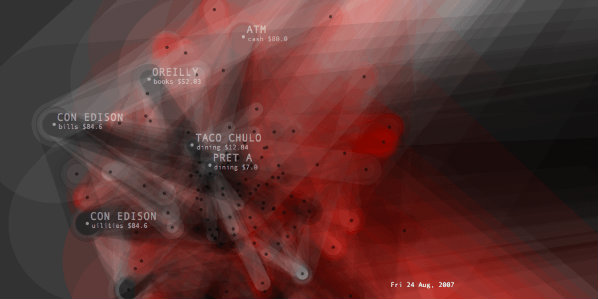
CM: MyPocket discloses your personal financial records to the internet public by exploring essential patterns in your transactions and deploying software to analyse those transactions. The software, which predicts future spending, sometimes determines your future spending choices. Mark B Hansen calls this a “feed-forward” relationship—one where statistical forecasting, future prediction, and probability calculation can code user behaviour “ahead of time,” framing the future-oriented choices of a subject.
What is an example of a consumer choice you’ve exercised that you were directly influenced to make by this software prediction? Did knowing that your personal financial data was being tracked impact your financial management or change your spending behaviors at all?
BA: MyPocket software was able to successfully predict when and where am I going to buy coffee. It predicts ordinary futures. Our lives have such repetitive patterns, which are not so hard to guess right for a supervised algorithm. With MyPocket, I put myself in an experiment of living under excessive forecast about my everyday purchasing behavior. Would I change my habits, would I abide by the predictions, would I care, would I notice, would I ignore? All of these applied at various stages as I lived with this software system for 2 years.
Today, protecting your privacy is akin to quitting smoking or exercising a vegan lifestyle. Changing habits is clearly hard, but once it starts rolling, it causes a big positive change. I believe, in a society of control that monitors, simulates and pre-mediates individual identities in relation to their data trails, behavioural dissidence is superior to reactionary resistance.
CM: You are an artist and technologist. Does one of these identities emerge more frequently in your work? Did your programming skills drive you to explore the aesthetic possibilities of networking mapping? Was there a sequential logic to your artwork as a secondary and subsequent extension of your work in the computational sphere? How do you situate your artistic practice—one that is reliant on a high degree of technological literacy—to the tools of computer technologies?
BA: My art making is a subjective exploration raising questions, whereas my tool making always wants to be objective, tapping an issue with a solution. I practice them in parallel and they feed each other. Making tools helps me examine all kinds of infrastructures closely thus provides lenses for new questions in my artwork. Artistic inquiries help me change my beliefs about the world.
In the first class of an introduction to computer programming course at MIT, students are told that programming is unrelated to computers in a way that geometry is unrelated to geography. Mastering programming takes years. In fact, in my very early work, technology and algorithms had authority on the outcome, whereas later works have been freed from technological capacities.
BA: Do you find that the procedures for mapping with non-digital tools change your artistic strategies and the types of networks you produce? In a similar vein, is the medium of Graph Commons as a digital interface important to the co-collaborative possibilities that this online platform enables? Would you describe the network mapping that Graph Commons enables as an act that is inherently political, or aligned with activist models of representation?
BA: I always start modeling an idea by sketching on a paper, by discussing with people, by taking notes here and there. It is often a contemplative process that I don’t find possible in a digital tool. As the idea gets mature, the amount of related material might not be manageable on paper – then I start organizing it using digital tools, write some code to scale it and observe its extents.
Obviously, digital tools on the Internet are best for asynchronous communication. The Graph Commons data mapping and publishing platform is great for internet-scale data mapping collaborations. Network mapping particularly is a powerful tool, it makes things more transparent. So activists, journalists, researchers, and civil society organizations around the world use it to untangle complex relations that impact them and their communities.
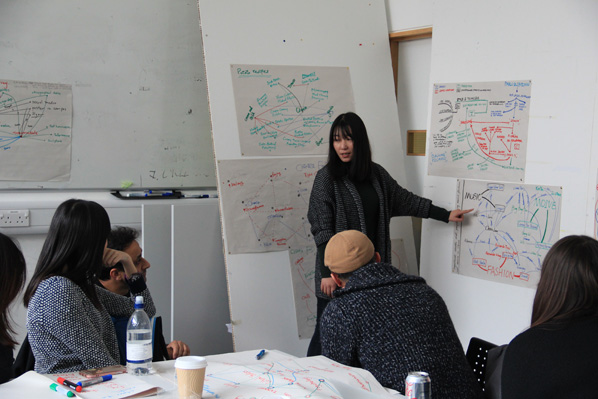
CM: Do you see networks as maps? Monovacation seems to deploy features of both in its networked parody of the commodity forms and repeated images that characterize the tourism commercial as a typology. What are some key distinctions that might separate these two forms from one another in their attempts to frame, visualize, and enclose data?
BA: As I mentioned earlier, I use network as a map vs network as an event separately in my work.
Monovacation introduced network traversal as a method to deconstruct and explore movies as databases. The official tourism commercials of countries in competition with each other have been selected and each film has been divided into the possible tiniest clips. The 3-4 second long clips have been coded with tags. Tags with shared clips are connected to each other (weighted with number of clips) on a network diagram, which runs as a self-organizing software simulation. A new movie has been algorithmically generated through a traversal on this network map, a program navigating from one node to another, following the weighted path among the tags. Seashores from Egypt to Portugal, women from Israel to India, mythological figures from Thailand to Turkey formed an extracted fantasy of “vacation”.
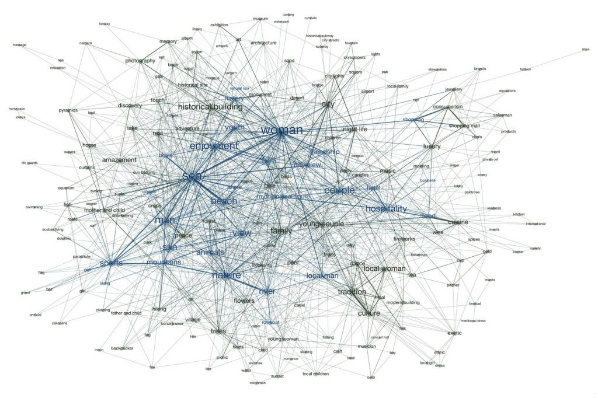
CM: The Graph Commons platform contains an additional axis that static graphics do not: time. How does working within digital media open up new models for orienting the user within data collections, particularly where the ability to represent change-over-time is at play?
BA: Networks are inherently dynamic, undergoing constant changes, both within the composition of nodes, and in the relations between nodes. To help you understand how the network changes and behaves over time, Graph Commons provides a timeline interface. It animates your network map as nodes leave and enter the network and the map expands or contracts in time. The network shape, radius, density, intensity, and emergence of clusters, central and peripheral actors all become observable and comparable using the timeline feature.
CM: Networks are the predominant and paradigmatic episteme of the information age. What kinds of relationalities, phenomena, data collections, or texts do they fail to capture? In other words:
a. What the network is NOT suited to do/perform
b. On speculating through an accelerated lens, what will the predominant formal and organisational structure of the next century look like? Will networks continue to play a role, or will they be completely surpassed by new organisational and structural logics?
BA: Bare network mapping may not be sufficient in studying multilayered diverse network dynamics where actors (nodes) and relations (edges) is not clearly distinguishable from one another as in swarms of species or molecular activity. Moreover, at the heart of capturing data lies the question of measurability. If something analogue can be measured it becomes digital, then it can be linked to other data points and become a subject of a network analysis. I think in this day and age, even emotions, intentions, and desires could be measured to a degree, if not socially reproduced.
In a world where every atom can be addressable with an IP address (IP6), discussion of the possibility of capturing analogue things is increasingly less relevant. What becomes critical is the question of who captures and controls what data owned by whom. Do you own a self-driving car’s data captured from your neighbourhood? Are you in control of your data captured by the network medicine? Are you paid rent for the use of data that belongs to you? Data oligarchies will only continue to grow, and this situation of data dispossession will increasingly constitute what I call data asymmetry for many years to come, until we move from connectivity to collectivity, build purposeful exploitation-free autonomous zones, and reroute our life activities in solidarity.
Regarding the future of organizational structures as imagined to be constituted by cryptocurrencies, something clear from today is that decentralization is not necessarily democratic. It should be deliberately discussed that ones who design the protocols have power and network effects can generate inequality. A blind belief in decentralization would not be so different than a belief in free market ideology. When Poland, Chile, and Turkey opened their markets to the world in the 80s, globally networked corporations penetrated into these markets completely within the laws and yet left the small locally connected actors stagnant, this is one example how network effects could generate inequality.
“AI just 3D printed a brand-new Rembrandt, and it’s shockingly good” reads the title of a PC World article in April 2016. Advertising firm J. Walter Thompson unveiled a 3D printed painting called “The Next Rembrandt”, based on 346 paintings of the old master. Not just PC World, many more articles touted similar titles, presenting the painting to the public as if it were made by a computer, a 3D printer, Artificial Intelligence and deep learning. It is clear though that the programmers who worked on the project are not computers, and neither are the people who tagged the 346 Rembrandt paintings by hand. The painting was made by a team of programmers and researchers, and it took them 18 months to do so.
A very successful feat of advertising, and a great example of how eager we are to attribute human qualities to computers and see data as the magic powder bringing life to humanity’s most confusing tool. Data is the new black… it can touch our soul according to a Microsoft spokesperson on the website of the Next Rembrandt: “Data is used by many people today to help them be more efficient and knowledgeable about their daily work, and about the decisions they need to make. But in this project it’s also used to make life itself more beautiful. It really touches the human soul.” (Ron Augustus, Microsoft). We have elevated data to divine standards and have developed a tendency to confuse tools with their creators in the process. Nobody in the 17th Century would have dreamed of claiming a brush and some paint created The Night Watch, or that it’s a good idea to spend 18 months on one painting.
The anthropomorphisation of computers was researched in depth by Reeves and Nass in The Media Equation (1996). They show through multiple experiments how people treat computers, television, and new media like real people and places. On the back of the book, Bill Gates says Nass and Reeves show us some “amazing things”. And he was right. Even though test subjects were completely unaware of it, they responded to computers as they would to people, by being polite, cooperative, attributing personality characteristics such as aggressiveness, humour, expertise, and even gender. If only Microsoft would use this knowledge to improve the way people interact with their products, instead of using it for advertising campaigns promoting a belief in the magic powers of computers and data. Or… oh wait… This belief, combined with the anthropomorphising of computers, profoundly alters the way people interact with machines and makes it much more likely that users will accept and adapt to the limitations and demands of technology, instead of demanding technology should adapt to them.
Strangely enough, the anthropomorphising of computers goes hand in hand with attributing authority, objectivity, even superiority to computer output by obfuscating the human hand in its generation. It seems paradoxical to attribute human qualities to something, while at the same time considering it to be more objective than humans. How can these two beliefs exist side by side? We are easily fooled, ask any magician. As long as our attention is distracted, steered, you can hide things in plain sight. We haven’t been too bothered with this paradox in the past. The obfuscation of a human hand in the generation of messages that require an objective or authoritative feel is very old. As a species, we’ve always turned to godly or mythical agents, in order to make sense of what we did not understand, to seek counsel. We asked higher powers to guide us. These higher powers rarely spoke to us directly. Usually messages were mediated by humans: priestesses, shamans or oracles. These mediations were validated as objective and true transmissions through a formalisation of the process in ritual, and later institutionalised as religion, obfuscating the human hand in the generation of these messages. Although disputed, it is commonly believed that the Delphic oracle delivered messages from her god Apollo in a state of trance, induced by intoxicating vapours arising from the chasm over which she was seated. Possessed by her god the oracle spoke, ecstatically and spontaneously. Priests of the temple translated her words into the prophecies the seekers of advice were sent home with. Apollo had spoken.
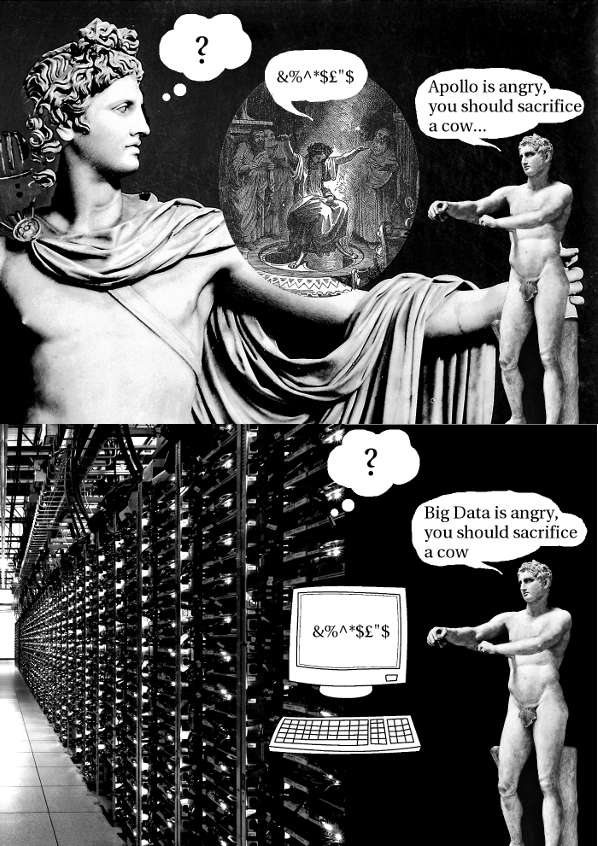
Nowadays we turn to data for advice. The oracle of big data[1] functions in a similar way to the oracle of Delphi. Algorithms programmed by humans are fed data and consequently spit out numbers that are then translated and interpreted by researchers into the prophecies the seekers of advice are sent home with. The bigger the data set, the more accurate the results. Data has spoken. We are brought closer to the truth, to reality as it is, unmediated by us subjective, biased and error-prone humans. We seek guidance, just like our ancestors, hoping we can steer events in our favour. Because of this point of departure, very strong emotions are attached to big data analysis, feelings of great hope and intense fear. Visions of utopia, the hope that it will create new insights into climate change and accurate predictions of terrorist attacks, protecting us from great disaster. At the same time there are visions of dystopia, of a society where privacy invasion is business as usual, and through this invasion an ever increasing grip on people through state and corporate control, both directly and through unseen manipulation.
Let’s take a closer look at big data utopia, where the analysis of data will protect us from harm. This ideology is fed by fear and has driven states and corporations alike to gather data like there is no tomorrow or right to privacy, at once linking it very tightly to big data dystopia. What is striking is that the fear of terrorist attacks has led to lots of data gathering, the introduction of new laws and military action on the part of governments, yet the fear of climate change has led to only very moderate activity. Yet the impact of the latter is likely to have more far reaching consequences on humanity’s ability to survive. In any case, the idea of being able to predict disaster is a tricky one. In the case of global warming, we can see it coming and aggravating because it is already taking place. But other disasters are hard to predict and can only be explained in retrospect. In Antifragility, Nicolas Taleb (2013, pp.92-93), inspired by a metaphor of Bertrand Russell, quite brilliantly explains the tendency to mistake absence of evidence for evidence of absence with a story about turkeys. Turkeys are fed for a thousand days by a butcher, leading them to believe, backed up by statistical evidence, that butchers love turkeys. Right when the turkey is most convinced that butchers love turkeys, when it is well fed and everything is quiet and predictable, the butcher surprises the turkey which has to drastically revise its beliefs.
An only slightly more subtle version of big data utopia is a utopia where data can speak, brings us closer to reality as it is, where we can safely forget theory and ideas and other messy subjective human influences through crunching enormous amounts of numbers.
“This is a world where massive amounts of data and applied mathematics replace every other tool that might be brought to bear. Out with every theory of human behaviour, from linguistics to sociology. Forget taxonomy, ontology, and psychology. Who knows why people do what they do? The point is they do it, and we can track and measure it with unprecedented fidelity. With enough data, the numbers speak for themselves.” (Anderson, 2008)
Using this rhetoric, there is no more need for models or hypotheses, correlation is enough. Just throw in the numbers and the algorithms will spit out patterns that traditional scientific methods were unable to bring to light. This promise sells well and companies providing data analysis and storage services promote it with great enthusiasm, as demonstrated by two slides in an Oracle presentation at Strata 2015: “Data Capital is the land grab of the future” and “It’s yours for the taking” (Pollock, 2015).

Can numbers really speak for themselves? When taking a closer look, a lot of assumptions come to light, constructing the myth of the oracle. Harford (2014) describes these assumptions as four articles of faith. The first is the belief in uncanny accuracy. This belief focuses all attention on the cases where data analysis made a correct prediction, while ignoring all false positive findings. Being right one out of ten times may still be highly profitable for some business applications, but uncannily accurate it is not. The second article is the belief that not causation, but correlation matters. The biggest issue with this belief is that if you don’t understand why things correlate, you have no idea why they might stop correlating either, making predictions very fragile in an ever changing world. Third is the faith in massive data sets being immune to sampling bias, because there is no selection taking place. Yet found data contains a lot of bias, as for example not everyone has a smartphone, and not everyone is on Twitter. Last but not least, the fourth belief, that numbers can speak for themselves… is hard to cling to when spurious correlations create so much noise, it’s hard to filter out the real discoveries. Taleb (2013, p.418) points to the enormous amount of cherry-picking done in big data research. There are way too many variables in modern life, making spurious relations grow at a much faster pace than real information.
As a rather poetic example, Leinweber (2007) demonstrated that data mining techniques could show a strong but spurious correlation between the changes in the S&P 500 stock index and butter production in Bangladesh. There is more to meaningful data analysis than finding statistical patterns, which show correlation rather than causation. Boyd and Crawford describe the beliefs attached to big data as a mythology, “the widespread belief that large data sets offer a higher form of intelligence and knowledge that can generate insights that were previously impossible, with the aura of truth, objectivity, and accuracy” (Boyd and Crawford, 2012). The belief in this oracle has quite far reaching implications. For one, it dehumanises humans by asserting that human involvement through hypotheses and interpretation, is unreliable, and only by removing humans from the equation can we finally see the world as it is. While putting humans and human thought on the sideline, it obfuscates the human hand in the generation of its messages and anthropomorphises the computer by claiming it is able to analyse, draw conclusions, even speak to us. The practical consequence of this dynamic is that it is no longer possible to argue with the outcome of big data analysis. This becomes painful when you find yourself in the wrong category of a social sorting algorithm guiding real world decisions on insurance, mortgage, work, border checks, scholarships and so on. Exclusion from certain privileges is only the most optimistic scenario, more dark ones involve basic human rights.
The deconstruction of this myth was attempted as early as 1984. In “A Spreadsheet Way of Knowledge”, Stephen Levy describes how the authoritative look of a spreadsheet, and the fact that it was done by a computer, has a strong persuasive effect on people, leading to acceptance of the proposed model of reality as gospel. Levy points out that all the benefits of using spreadsheets are meaningless if the metaphor is taken too seriously. He concludes with a statement completely opposite to what Anderson will state 24 years later: “Fortunately, few would argue that all relations between people can be quantified and manipulated by formulas. Of human behaviour, no faultless assumptions – and so no perfect model — can be made”. A lot has changed in 24 years. Still back in the eighties, Theodore Roszak describes the subjective core of software beautifully: “Computers, as the experts continually remind us, are nothing more than their programs make them. But as the sentiments above should make clear, the programs may have a program hidden within them, an agenda of values that counts for more than all the interactive virtues and graphic tricks of the technology. The essence of the machine is its software, but the essence of the software is its philosophy” (Roszak, 1986). This essence, sadly, is often forgotten, and outcomes of data analysis therefore misinterpreted. In order to correctly assess the outcomes of data analysis it is essential to acknowledge that interpretation is at the heart of the process, and assumptions, bias and limitations are undeniable parts of it.
In order to better understand the widespread belief in the myth of big data, it is important to look at the shift in the meaning of the word information (Roszak, 1986). In the 1950s, with the advent of cybernetics, the study of feedback in self-regulating closed systems, information transformed from short statement of fact to the means to control a system, any system, be it mechanical, physical, biological, cognitive or social (Wiener, 1950). In the 1960s artificial intelligence researchers started viewing both computers and humans as information processing systems (Weizenbaum, p.169). In the 1970s it was granted an even more powerful status, that of commodity. The information economy was born and promoted with great enthusiasm in the 1980s.
“Reading Naisbitt and Toffler is like a fast jog down a world’s Fair Midway. We might almost believe, from their simplistic formulation of the information economy, that we will soon be living on a diet of floppy disks and walking streets paved with microchips. Seemingly, there are no longer any fields to till, any ores to mine, any heavy industrial goods to manufacture; at most these continuing necessities of life are mentioned in passing and then lost in the sizzle of pure electronic energy somehow meeting all human needs painlessly and instantaneously.” (Roszak, 1986, p. 22).
Nowadays not only corporations and governments, but individuals have become information hungry. What started as a slightly awkward hobby in the 80s, the quantified self has now become mainstream with people self monitoring anything from sleep to eating habits, from sport activities to mood using smartphones and smartwatches with build-in sensors, uploading intimate details such as heart-rate, sleep patterns and whereabouts to corporate servers in order to improve their performance.
Even with this change in the way we view information in mind, it is difficult to believe we cannot see through the myth. How did it become plausible to transpose cybernetic thinking from feedback in self-regulating closed systems to society and even to human beings? It is quite a leap, but we somehow took it. Do humans have anything in common with such systems? Weizenbaum (1976) explains our view of man as machine through our strong emotional ties to computers, through the internalisation of aspects of computers in order to operate them, in the form of kinaesthetic and perceptual habits. He describes how in that sense, man’s instruments become part of him and alter the nature of his relationship to himself. In The Empty Brain (2016) research psychologist Robert Epstein writes about the idea that we nowadays tend to view ourselves as information processors, but points out there is a very essential difference between us and computers: humans have no physical representations of the world in their brains. Our memory and that of a computer have nothing in common, we do not store, retrieve and process information and we are not guided by algorithms.

Epstein refers to George Zarkadakis’ book In Our Own Image (2015), where he describes six different metaphors people have employed over the past 2,000 years to try to explain human intelligence. In the earliest one, eventually preserved in the Bible, humans were formed from clay or dirt, which an intelligent god then infused with its spirit. This spirit somehow provided our intelligence. The invention of hydraulic engineering in the 3rd century BC led to the popularity of a hydraulic model of human intelligence, the idea that the flow of different fluids in the body – the ‘humours’ – accounted for both our physical and mental functioning. By the 1500s, automata powered by springs and gears had been devised, eventually inspiring leading thinkers such as René Descartes to assert that humans are complex machines. By the 1700s, discoveries about electricity and chemistry led to new theories of human intelligence – again, largely metaphorical in nature. In the mid-1800s, inspired by recent advances in communications, the German physicist Hermann von Helmholtz compared the brain to a telegraph. Predictably, just a few years after the dawn of computer technology in the 1940s, the brain was said to operate like a computer, with the role of physical hardware played by the brain itself and our thoughts serving as software.
This explanation of human intelligence, the information processing metaphor, has infused our thinking over the past 75 years. Even though our brains are wet and warm, obviously an inseparable part of our bodies, and using not only electrical impulses but also neurotransmitters, blood, hormones and more, nowadays it is not uncommon to think of neurons as ‘processing units’, synapses as ‘circuitry’, ‘processing’ sensory ‘input’, creating behavioural ‘outputs’. The use of metaphors to describe science to laymen also led to the idea that we are ‘programmed’ through the ‘code’ contained in our DNA. Besides leading to the question of who the programmer is, these metaphors make it hard to investigate the nature of our intelligence and the nature of our machines with an open mind. They make it hard to distinguish the human hand in computers, from the characteristics of the machine itself, anthropomorphising the machine, while at the same time dehumanising ourselves. For instance, Alan Turing’s test to prove if a computer could be regarded as thinking, now is popularly seen as a test that proves if a computer is thinking. Only in horror movies would a puppeteer start to perceive his puppet as an autonomous and conscious entity. The Turing test only shows whether or not a computer can be perceived of as thinking by a human. That is why Turing called it the imitation game. “The Turing Test is not a definition of thinking, but an admission of ignorance — an admission that it is impossible to ever empirically verify the consciousness of any being but yourself.” (Schulman, 2009). What a critical examination of the IP metaphor makes clear, is that in an attempt to make sense of something we don’t understand, we’ve invented a way of speaking about ourselves and our technology that obscures instead of clarifies both our nature and that of our machines.
Why dehumanize and marginalize ourselves through the paradox of viewing ourselves as flawed, wanting a higher form of intelligence to guide us, envisioning superhuman powers in a machine created by us, filled with programs written by us, giving us nothing but numbers that need interpretation by us, obfuscating our own role in the process yet viewing the outcome as authoritative and superior. A magician cannot trick himself. Once revealed, never concealed. Yet we manage to fall for a self created illusion time and time again. We fall for it because we want to believe. We joined the church of big data out of fear, in the hope it would protect us from harm by making the world predictable and controllable. With the sword of Damocles hanging over our heads, global warming setting in motion a chain of catastrophes, threatening our survival, facing the inevitable death of capitalism’s myth of eternal growth as earth’s resources run out, we need a way out. Since changing light bulbs didn’t do the trick, and changing the way society is run seems too complicated, the promise of a technological solution inspires great hope. Really smart scientists, with the help of massive data sets and ridiculously clever AI will suddenly find the answer. In ten years time we’ll laugh at the way we panicked about global warming, safely aboard our CO2 vacuum cleaners orbiting a temporarily abandoned planet Earth.
Theinformation processing metaphor got us completely hooked on gathering data. We are after all information processors. The more data at our fingertips, the more powerful we become. Once we have enough data, we will finally be in control, able to predict formerly unforeseen events, able to steer the outcome of any process because for the first time in history we’ll understand the world as it really is. False hope. Taken to itsextreme, the metaphor leads to the belief that human consciousness, being so similar to computer software, can be transferred to a computer.
“One prediction – made by the futurist Kurzweil, the physicist Stephen Hawking and the neuroscientist Randal Koene, among others – is that, because human consciousness is supposedly like computer software, it will soon be possible to download human minds to a computer, in the circuits of which we will become immensely powerful intellectually and, quite possibly, immortal.” (Epstein, 2016).
False hope. Another example is the project Alliance to Rescue Civilization (ARC), by scientists E. Burrows and Robert Shapiro. It is a project that aims to back up human civilization in a lunar facility. The project artificially separates the “hardware” of the planet with its oceans and soils, and the “data” of human civilization (Bennan, 2016). Even thoughseeing the need to store things off-planet conveys aless than optimisticoutlook on the future, the project gives the false impression that technology can separate us from earth. A project pushing this separation to its extreme is Elon Musk’s SpaceX plan to colonize Mars, announced in June 2016, and gaining momentum with his presentation at the 67th International Astronautical Congress in Guadalajara, September 27th. The goal of the presentation was to make living on Mars seem possible within our lifetime. Possible, and fun.
“It would be quite fun because you have gravity, which is about 37% that of Earth, so you’d be able to lift heavy things and bound around and have a lot of fun.” (Musk, 2016).
We are inseparable from the world we live in. An artificial separation from earth, which we are part of and on which our existence depends, will only lead to a more casual attitude towards the destruction of its ecosystems. We‘ll never be immortal, downloadable or rescued from a lunar facility in the form of a back up. Living on Mars is not only completely impossible at this moment, nothing guarantees it will bein the future. Even if it were possible, and you would be one of the select few that could afford to go, you’d spend your remaining days isolated on a life-less, desolate planet, chronically sleep deprived, with a high risk of cancer, a bloated head, the bone density and muscle mass worse than that of a 120 year old, due to the small amount of gravity and high amount of radiation (Chang, 2014).Just like faster and more precise calculations regarding the position of planets in our solar system will not make astrology more accurate in predicting the future, faster machines, more compact forms of data storage and larger data setswill not make us able to predict and control the future. Technological advances will not transform our species from a slowly evolving one, into one that can adapt to extreme changes in our environmentinstantly, as we would need to in the case of a rapidly changing climate or a move to another planet.
These are the more extreme examples, that are interesting because they make the escapist attitude to our situation so painfully clear. Yet the more widely accepted beliefs are just as damaging. The belief that with so much data at our fingertips, we’ll make amazing new discoveries that will safe us just in time, leads to hope that distracts us from the real issues that threaten us. There are 7.4 billion of us. The earth’s resources are running out. Climate change will set in motion a chain of events we cannot predict precisely but dramatic sea level rises and mass extinction will be part of it without doubt. We cannot all Houdini out of this one, no matter how tech savvy we might become in the next decades. Hope is essential, but a false sense of safety paralyses us and we need to start acting. In an attempt to understand the world, to become less fragile, in the most rational and scientifically sound way we could think of, we’ve started anthropomorphising machines and dehumanising ourselves. This has, besides inspiring a great number of Hollywood productions, created a massive blind spot and left us paralysed. While we are bravely filling up the world’s hard disks, we ignore our biggest weakness: this planet we are on, it’s irreplaceable and our existence on it only possible under certain conditions. Our habits, our quest to become more productive, more efficient, more safe, less mortal, more superhuman, actually endangers us as a species… With technology there to save us, there is no urgency to act. Time to dispel the myth, to exit the church of big data and start acting in our best interest, as a species, not as isolated packages of selfish genes organized as information processors ready to be swooshed off the planet in a singularity style rapture.

Several months ago I stayed in an offbeat Amsterdam hotel that brewed its own beer but refused to accept cash for it. Instead, they forced me to use the Visa payment card network to get my UK bank to transfer €4 to their Dutch bank via the elaborate international correspondent banking system.
I was there with civil liberties campaigner Ben Hayes. We were irritated by the anti-cash policy, something the hotel staff took for annoyance at the international payments charges we’d face. That wasn’t it, though. Our concern was intuitive about a potential future world in which we’d have to report our every economic move to a bank and the effect this could have on marginalised people.
‘Cashless society’ is a euphemism for the “ask-your-banks-for-permission-to-pay society”. Rather than an exchange occurring directly between the hotel and me, it takes the form of a “have your people talk to my people” affair. Various intermediaries message one another to arrange an exchange between our respective banks. That may be a convenient option, but in a cashless society, it would no longer be an option at all. You’d have no choice but to conform to the intermediaries’ automated bureaucracy, giving them a lot of power and a lot of data about the microtexture of your economic life.

Our concerns are unfashionable. Without any explicit declaration, the War on Cash has begun. Proponents of digital payment systems are riding upon technology-friendly times to proclaim the imminent Death of Cash. Sweden leads in the drive to reach this state, but the UK is edging that way too. London buses stopped accepting cash in 2014 but do accept MasterCard and Visa contactless payment cards.
Every cash transaction you make is one that payments intermediary like Visa takes no fee from, so it has an interest in making cash appear redundant, deviant and criminal. That’s why, in 2016, Visa Europe launched its “Cashfree and Proud” campaign to inform cardholders that “they can make a Visa contactless payment with confidence and feel liberated from the need to carry cash.”
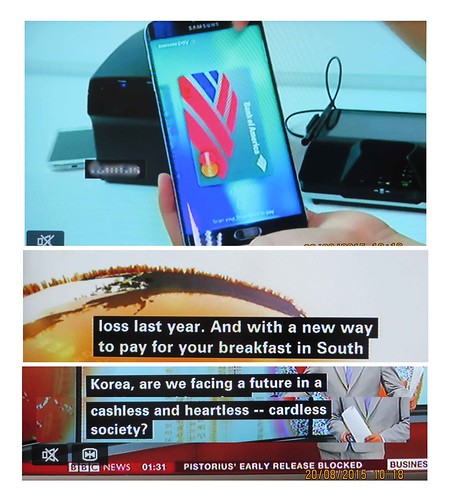
The company’s press release declared the campaign “the latest step of Visa UK’s long-term strategy to make cash ‘peculiar’ by 2020.”
There you have it. An orchestrated strategy to make us feel weird about cash. Propaganda is a key weapon of war, and all sides present themselves as liberators. Visa comes across like a paternalistic commander when assuring us that we – like a baby taking first steps – will feel a sense of achievement at liberating ourselves from the burden of cash dependence. Visa technology offers freedom without dependence or dangers.
Other propagandists join Visa. In 2014 Penny for London arrived, an apparently altruistic group set up by the Mayor’s Fund for London and Barclaycard, using charity as a hook to switch people to contactless cards on the London Underground. PayPal plastered cities with billboards claiming that “new money doesn’t need a wallet”, and a video proclaiming: “New money isn’t paper, it’s progress”. Astroturfing campaigns like No Cash Day are backed by American Express, highlighting such anti-cash themes as the environmental impact of banknotes. Other tactics include pointing out that criminals use cash, that it fuels the shadow economy, that it’s unsafe, and facilitates tax evasion.
These arguments have notable shortcomings. Criminals use many things we keep – like cars – and fighting crime doesn’t prioritise maintaining other social goods like civil liberties. The ‘shadow economy’ is a derogatory term used by elites to describe the economic activities of people they neither understand nor care about. As for safety, having your wallet cash stolen pales compared to having your savings obliterated in a digital account hack. And if you care about tax justice, start with the mass corporate tax avoidance facilitated by the formal banking sector.
However, the peculiar feature of this war is that only one side is fighting. Very few media champions defend cash. It is like a taken-for-granted public utility, whereas digital payment platforms are run by private companies with an incentive to flood the media with their key messages. When they fight this war, their target is our cultural belief in cash and the belief that its provision should be a public right.
The UK government does not plan to maintain that right and is siding with the payments industry. Their position is summed up by economist Kenneth Rogoff in his new book The Curse of Cash. He argues that, apart from facilitating crime and tax evasion, cash hampers central banks from setting negative interest rates. In the absence of cash, everyone must keep their money in the form of digital bank deposits. During recessions, central banks could then use the banking system to deliberately corrode people’s deposits via negative charges, ‘inspiring’ them to spend rather than hoard.
The emergent consensus among economic and political elites is that this is the direction to go in, but to manufacture consent for this requires a drip-drip erosion of public resistance. Hearts and minds must be shown that the change represents inevitable and desirable progress.
Anyone defending cash in this context will be labelled as an anti-progress, reactionary, and nostalgic Luddite. That’s why we must not defend cash. Rather, we should focus on pointing out that the Death of Cash means the Rise of Something Else. We are fighting a broader battle to maintain alternatives to the growing digital panopticon that is emerging all around us.
To understand this conflict, we must step back. A monetary transaction involves exchanging specific goods or services for tokens giving access to general goods and services from others. The pub landlord hands me a beer at night if I transfer tokens that allow him to get cigarettes from a shopkeeper in the morning.
There are two ways to implement this, though.
The first is to give the tokens a physical form. In this scenario, ‘getting rich’ means accumulating those physical things and ‘making a payment’ means handing them over to someone else. They are bearer instruments, which means nobody keeps a record of who owns them. Rather, whoever holds them owns them. This is your wallet with notes in it. This is cash.

Alternatively, you can use a ledger. Someone sets up a database with spaces allotted to different people. This is then used to keep a record of who has tokens. These tokens have no physical form but are written into existence. They are ‘data objects’ and are ‘moved around’ by editing the record. The keeper of the ledger thus maintains an account of what money is attributable to you, ‘keeping score’ of it for you. In this system, ‘getting rich’ means accumulating a high score on your account. ‘Making a payment’ involves identifying yourself to the keeper of the ledger via a communications system and requesting that they edit your account and the account of whoever you are paying.
Does this sound familiar? It is your bank account.
Old banks used actual books to maintain these account ledgers, but modern banks use digital databases housed in huge data centres. You then interact with them via your internet banking portal, your phone app, or by going into a branch. This is not a minor part of the monetary system. Over 90 per cent of the UK’s money supply exists nowhere but on bank databases.
It is upon this underlying infrastructure that payment card companies like Visa build their operations. They deal with situations in which someone with one bank account finds themselves in a shop owned by someone else with another bank account. Rather than the pub landlord giving me his bank details for a manual transfer, my card sends messages through Visa’s network to automatically arrange the editing of our respective accounts.
Many fintech – financial technology – startups specialise in finding ways to augment, gamify or streamline elements of this underlying infrastructure. Thus, I might use a mobile phone fingerprint reader to authorise changes to the bank databases. – ‘disruption’ merely involves putting slicker clothes on the same old emperor.
The use of high-speed communications systems to rearrange binary code information about who has what money might be new, but ledger money is as old as any bearer form. The Rai stones of the island of Yap were huge and largely unmovable stones that, while seeming like physical tokens, were a form of ledger money. Rather than being physically moved – like cash would – a record of who owned the stones was kept in people’s heads, stored in their communal memory. If the owners wished to ‘transfer’ a stone to another, they ‘edited the ledger’ of who possessed the tokens by merely informing the community. Why physically roll the stone if you can get everyone to remember that it has ‘moved’ to somebody else? The main reason that we struggle to recognise this as a form of cashlessness is that the ledger is invisible and informal.

Cashless society, though, is presented as futuristic progress rather than past history, a fashionable motif of futurists, entrepreneurs and innovation gurus. Nevertheless, while there are real trends in behaviour and tastes to be spotted in society, there are also trends in behaviour and taste among trend-spotters. They are paid to fixate upon change and have the incentive to hype minor shifts into ‘end of history’ deaths, births and revolutions. Innovation communities are always at risk of losing touch within an echo chamber of buzzwords, amplifying one another’s speculations into concrete future certainties. These prediction factories always produce the same two unprovable sentences: “In the future we will… ” and “In the future, we will no longer… “. Thus, in the future, we will all use digital payments. In the future, we will no longer use cash.
This is the utopia presented by the growing digital payments industry, which wishes to turn the perpetual mirage of a cashless society into a self-fulfilling prophecy. Indeed, a key trick to promoting your interests is to speak of them as obvious inevitabilities already underway. It makes others feel silly for not recognising the apparently obvious change.
To create a trend, you should also present it as something others demand. A sentence like “All over the world, people are switching to digital payments” is not there to describe what other people want. It’s there to tell you what you should want by making you feel in sync with them. Here’s fintech investor Rich Ricci invoking the spectre of millennials, with their strange moral power to define the future. They are repulsed by the revolting physicality of cash and feel all warm towards fintech gadgets. But these are not, on the whole, real people. They are a weapon in the arsenal of marketing departments to make older people feel prehistoric. We’re not pushing this. We’re just responding to what the new generation demands.
And so we get Visa’s Cashfree and Proud campaign. If people really were ashamed of cash, they wouldn’t need ads to tell them. Visa must engineer that shame to teach you that what you want is the same as what they want. And if you don’t want it, just remember that a cashless society is inevitable. Don’t get left behind.
But this system will leave many behind. It is hardwired to include only those with access to a bank account, and bank accounts are hosted by profit-seeking corporations that operate at scale. They have no time for your individual idiosyncrasies. They cannot make a profit off anyone who cannot easily be categorised and modelled on a spreadsheet.
So, good luck if you find yourself with only sporadic appearances in the official books of state, if you are a rural migrant without a recorded birthdate, identifiable parents, or an ID number. Sorry if you lack markers of stability if you are a rogue traveller without a permanent address, phone number or email. Apologies if you have no status symbols or are an informal economy hustler with no assets and low, inconsistent income. Condolences if you have no official stamps of approval from gatekeeper bodies, like university certificates or records of employment at a formal company. Goodbye if you have a poor record of engagements with recognised institutions, like a criminal record or a record of missed payments.
This is no small problem. The World Bank estimates that there are two billion adults without bank accounts, and even those who do have them still often rely upon the informal flexibility of cash for everyday transactions. These are people bearing indelible markers of being incompatible with formal institutional space. They are often too unprofitable for banks to justify the expense of setting them up with accounts. This is the shadow economy, invisible to our systems.
The shadow economy is not just ‘poor’ people. It’s potentially anybody who hasn’t internalised the correct state-corporate narrative of normality and anyone seeking a lifestyle outside of the mainstream. The future presented by self-styled innovation gurus has no scope for flexible, unpredictable or invisible people. They represent analogue backwardness. The future is a world of endless consumer choice built upon an inescapable digital uniformity of automated rules, a matrix outside which you can neither exist nor think.

Back in Amsterdam, I hang out with Ancilla van de Leest of the Netherlands Pirate Party. She only visits establishments that accept cash, true to her political belief in individual privacy from prying eyes.
However, it would be wrong to assume that Ancilla’s primary concern involves surveillance by a Big Brother-style bogeyman. It’s true that your spending patterns reveal much about how you actually live, and the privacy implications of having these recorded in searchable database format are only starting to be uncovered. We know that targeted individual surveillance of payments occurs by the likes of the FBI and NSA, but routinised mass surveillance could become a norm. Imagine automatic flagging systems triggered by anyone engaging in a combination of transactions deemed subversive. Tax authorities are bound to be building systems to flag discrepancies between your spending patterns and your declared profits.
It’s also true that at London fintech gatherings, the exciting visions of a cashless society occasionally come with a disclaimer that we should think about the power granted to those who control the system. Not only can payment intermediaries see every time you buy access to a porn site, but they have the ability to censor your transactions, like Visa, PayPal and MasterCard attempting to choke WikiLeaksby refusing to process people’s donations. We could imagine some harsh sci-fi scenario in which a theocratic regime issues decrees to payment processors to block anyone buying books deemed sexually deviant. Such decrees could be automatically enforced via code, with subroutines remotely triggering smart locks to place the offending miscreant under house arrest while automatically deducting a fine from their account.
Such automated dystopias should ideally be avoided, so a dose of paranoia about digital payment systems is a healthy impulse, even if it might be unwarranted.
But that isn’t really the point. What’s more important to Ancilla and me is the looming sense of an external watcher that ‘assists’, ‘guides’ or ‘helps’ you in your life, tracking and logging your moves to influence you. The watcher is not a single entity. It’s a collective array being incrementally built in stages by startups and companies worldwide as we speak. We feel it seeping deeper into our lives, a mesh of connected devices, cookies and sensors. Whether we visualise it as the benevolent eyes of a parent or the menacing eyes of a tyrant doesn’t matter. The point is that the eyes have the potential to monitor you all the time.
The proclaimed Death of Cash is thus an episode in the broader drama that is the Death of Privacy, the death of the breathing room, and the death of informal, non-measured, unaccounted-for behaviour. Every action you take must forever be attached to your digital persona, dragging a data trail extending back to the day you were born. We face creating an entire generation of people who do not know what it feels like not to be monitored.

For many economists, the War on Cash will be resolved by their favourite mystical demigod, the market. This guiding force prevails when utility-maximising producers and consumers make rational choices with perfect information about their options and total freedom to choose whether or not to exercise them. If digital payment transaction costs are lower, then the cash will rightly die.
The pristine realm of market theory is unfit to assess the dynamics of this situation. Our sense of what constitutes a legitimate choice does not form in a vacuum. We are born into social power structures that tell us what normality is and shame us for not choosing ‘correctly’. You might be a rebel who challenges prevailing cultural norms, but those norms are conditioned by those with the greatest financial and media clout. At this moment, the blaring of propaganda extolling the short-term conveniences of digital payment is dulling our critical impulses to rearrange our cultural DNA. Who is thinking about the longer-term implications of building our lives around these systems and thereby locking ourselves into dependence upon them?
Unlike a battle fought using violence, hegemony is the assertion of power by getting people to believe in it, to see it as inevitable, unassailable and normal. Visa’s four-year plan is one such exercise, and once we’ve internalised it, we’ll choose to build their power. We’ll feel strangely comforted by the MasterCard billboard endorsed by the Mayor of London. We’ll find ourselves downloading ApplePay like a dazed child accepting a gift.
So, let’s prepare for the War on Cash. Remember, this is not about romanticising the £10 notes with the Queen. This is about maintaining alternatives to the stifling hygiene of the digital panopticon being constructed to serve the needs of profit-maximising, cost-minimising, customer-monitoring, control-seeking, and behaviour-predicting commercial bureaucrats. And fear not, the Germans are onside, along with the criminals, the homeless, the street-side buskers and an army of people whose lives will never get a five-star rating on a mainstream reputation scoring system. We will forge alliances with purveyors of non-bank alternative currency systems and maintain the option to use our payment cards. Because what we fight for is precisely that. The option.
Basic Income is often promoted as an idea that will solve inequality and make people less dependent on capitalist employment. However, it will instead aggravate inequality and reduce social programs that benefit the majority of people.
At its Winnipeg 2016 Biennial Convention, the Canadian Liberal Party passed a resolution in support of “Basic Income.” The resolution, called “Poverty Reduction: Minimum Income,” contains the following rationale: “The ever growing gap between the wealthy and the poor in Canada will lead to social unrest, increased crime rates and violence… Savings in health, justice, education and social welfare as well as the building of self-reliant, taxpaying citizens more than offset the investment.”
The reason many people on the left are excited about proposals such as universal basic income is that they acknowledges economic inequality and its social consequences. However, a closer look at how UBI is expected to work reveals that it is intended to provide political cover for the elimination of social programs and the privatization of social services. The Liberal Party’s resolution is no exception. Calling for “Savings in health, justice, education and social welfare as well as the building of self-reliant, taxpaying citizen,” clearly means social cuts and privatization.
UBI has been endorsed by neoliberal economists for a long time. One of its early champions was the patron saint of neoliberalism, Milton Friedman. In his book Capitalism and Freedom, Friedman argues for a “negative income tax” as a means to deliver a basic income. After arguing that private charity is the best way to alleviate poverty, and praising the “private … organizations and institutions” that delivered charity for the poor in the capitalist heyday of the nineteenth century, Friedman blames social programs for the disappearance of private charities: “One of the major costs of the extension of governmental welfare activities has been the corresponding decline in private charitable activities.”
To Friedman and his many powerful followers, the cause of poverty is not enough capitalism. Thus, their solution is to provide a “basic income” as a means to eliminate social programs and replace them with private organizations. Friedman specifically argues that “if enacted as a substitute for the present rag bag of measures directed at the same end, the total administrative burden would surely be reduced.”
Friedman goes on to list some the “rag bag” of measures he would hope to eliminate: direct welfare payments and programs of all kinds, old age assistance, social security, aid to dependent children, public housing, veterans’ benefits, minimum-wage laws, and public health programs, hospitals and mental institutions.
Friedman also spends a few paragraphs worrying whether people who depend on “Basic Income” should have the right to vote, since politically enfranchised dependents could vote for more money and services at the expense of those who do not depend on these. Using the example of pension recipients in the United Kingdom, he concludes that they “have not destroyed, at least as yet, Britain’s liberties or its predominantly capitalistic system.”
Charles Murray, another prominent libertarian promoter of UBI, shares Friedman’s views. In an interview with PBS, he said: “America’s always been very good at providing help to people in need. It hasn’t been perfect, but they’ve been very good at it. Those relationships have been undercut in recent years by a welfare state that has, in my view, denuded the civic culture.” Like Friedman, Murray blames the welfare state for the loss of apparently effective private charity.
Murray adds: “The first rule is that the basic guaranteed income has to replace everything else — it’s not an add-on. So there’s no more food stamps; there’s no more Medicaid; you just go down the whole list. None of that’s left. The government gives money; other human needs are dealt with by other human beings in the neighborhood, in the community, in the organizations. I think that’s great.”
To the Cato Institute, the elimination of social programs is a part of the meaning of Universal Income. In an article about the Finish pilot project, the Institute defines UBI as “scrapping the existing welfare system and distributing the same cash benefit to every adult citizen without additional strings or eligibility criteria”. And in fact, the options being considered by Finland are constrained to limiting the amount of the basic income to the savings from the programs it would replace.

From a social welfare point of view, the substitution of social programs with market-based and charitable provision of everything from health to housing, from child support to old-age assistance, clearly creates a multi-tier system in which the poorest may be able to afford some housing and health care, but clearly much less than the rich — most importantly, with no guarantee that the income will be sufficient for their actual need for health care, child care, education, housing, and other needs, which would be available only by way of for-profit markets and private charities.
Looking specifically at whether Friedman’s proposal would improve the conditions of the poor, Hyman A. Minsky, a renowned and highly regarded economist, wrote the “The Macroeconomics of a Negative Income Tax.” Minsky looks at the outcome of a “social dividend,” which “transfers to every person alive, rich or poor, working or unemployed, young or old, a designated money income by right.” Minsky conclusively shows that such a program would “be inflationary even if budgets are balanced” and that the “rise in prices will erode the real value of benefits to the poor … and may impose unintended real costs upon families with modest incomes.” Any improved spending power afforded to citizens through an instrument such as UBI will be completely absorbed by higher prices for necessities.
Rather than alleviating poverty, UBI will most likely exacerbate it. The core reasoning is quite simple: the prices that people pay for housing and other necessities are derived from how much they can afford to pay in the first place. If you imagine how housing is distributed in modern capitalist society, the poorest get the worst housing, and the richest get the best. Giving everyone in the community, rich and poor alike, more money would not allow the poorest to get better housing, and it would just raise the price of housing.
If UBI came at the expense of other social programs, such as health care or child care, as Friedman intended, then the rising cost of housing would draw money away from other previously socially provisioned services, forcing families with modest incomes to improve their substandard housing by accepting worse or less childcare or healthcare, or vice versa. A disabled person whose mobility needs requires an additional expenditure on accessible housing may not have enough of the basic income left for any additional health care they also require. Yet replacing means testing and special programs that address specific needs is the big idea of UBI.
The notion that we can solve inequality within capitalism by indiscriminately giving people money and leaving the provisioning of all social needs to corporations is extremely dubious. While this view is expected among those, like Murray and Friedman, who promote capitalism, it is incompatible with anticapitalism. UBI will end up in the hands of capitalists. We will be dependent on these same capitalists for everything we need. But to truly alleviate poverty, productive capacity must be directed toward creating real value for society and not toward “maximizing shareholder value” of profit-seeking investors.

Many people don’t dispute the fact that establishment promoters of UBI are only doing it to eliminate social programs, but they imagine that another kind of basic income is possible. They call for a basic income that disregards the “deal” that Charles Murray advocates but wants UBI in addition to other social programs, including means-tested benefits, housing protections, education and child care guarantees, and so on. This view ignores the political dimension of the question. Proposing UBI, in addition to existing program mistakes, a general consensus for replacing social programs with a guaranteed income for a broad support base for increasing social programs. But, no such broad base exists.
Writing in 1943, with the wartime policies of “full employment” enjoying wide support, Michal Kalecki wrote a remarkable essay entitled “The Political Aspects of Full Employment.” Kalecki opens by writing, “a solid majority of economists is now of the opinion that, even in a capitalist system, full employment may be secured by a government spending programme.” Though he is talking about full employment, which means an “adequate plan to employ all existing labour power,” the same is true of UBI. Most economists would agree that a plan to guarantee an income for all is possible.
However, Kelecki ultimately argues that full employment policies will be abandoned: “The maintenance of full employment would cause social and political changes which would give a new impetus to the opposition of the business leaders. Indeed, under a regime of permanent full employment, ‘the sack’ would cease to play its role as a disciplinary measure. The social position of the boss would be undermined, and the self-assurance and class-consciousness of the working class would grow.”
The conflict between the worker and the capitalist, or between the rich and the poor, can not be sidestepped simply by giving people money if capitalists are allowed to continue monopolising the supply of goods. Such a notion ignores the political struggle between the workers to maintain (or extend) the “basic income” and the capitalists to lower or eliminate it to strengthen their social position over the worker and to protect the power of “the sack.”
Business leaders fight tooth and nail against any increase in social benefits for workers. Under their dominion, only one kind of UBI is possible: the one supported by Friedman and Murray, the Canadian Liberal Party and all others. They want to subject workers to bosses. The UBI will be under constant attack. Unlike established social programs with planned outcomes that are socially entrenched and difficult to eliminate, UBI is just a number that can be reduced, eliminated, or allowed to fall behind inflation.
UBI does not alleviate poverty and turns social necessities into products for profit. To truly address inequality we need adequate social provisioning. If we want to reduce means testing and dependency on capitalist employment, we can do so with capacity planning. Our political demands should mandate sufficient housing, healthcare, education, childcare and all basic human necessities. Rather than a basic income, we must demand and fight for a basic outcome — the right to life and justice, not just the right to spend.
In this special feature Steve Jampijimpa Patrick writes about YAMA, the name given to the installation currently on display as part of the exhibition Networking the Unseen at Furtherfield Gallery.
* * * * * * * * * * * *
I want to tell you about YAMA. This is the Warlpiri word for a shadow, or reflection. It’s also a word that we use to describe a meeting or a meeting-place; we gather under a tree that casts a shadow (a reflection of its shape) onto the ground, and we talk in a group – both men and women together, equally – to make decisions and to reflect on ourselves and our lives. But it’s deeper, too. In yapa (Aboriginal) culture, if someone says “you don’t have a shadow”, it means you don’t exist. All the birds, all the small animals, trees – these things all have a shadow; all of your country and everything in it; this is your universe. How can you reflect your universe? And what about you, reader? Does your homeland reflect you?
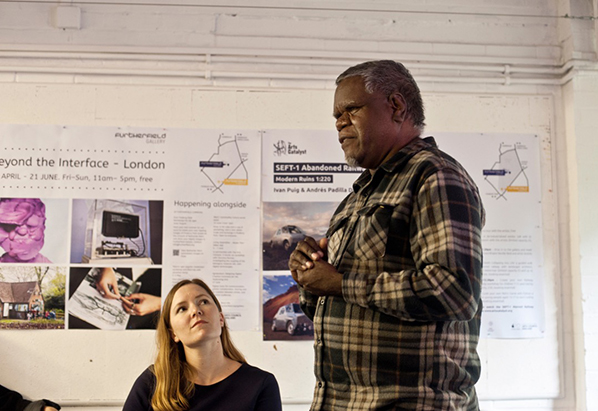
I’ve been all over the world, searching for ngurra kurlu (the home within). Each country’s, each people’s ngurra kurlu is different. If you don’t speak your language, if you don’t know your culture, the songlines of the animals in your country, how can you express yourself or where you’re from? This reflection happens through language, through dance, art, even food – that’s ngurra kurlu. There is a universe and we are its shadow.
We yapa say “don’t become Australian, become Australia”.
That’s ngurra kurlu.
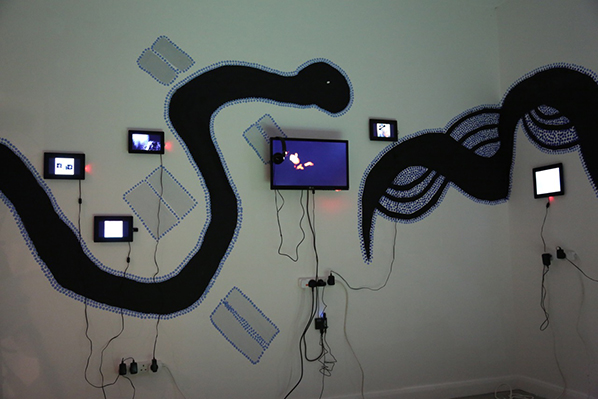
I am writing this from Germany, we (Neil Jupurrurla Cooke and I) were in England for a week working on YAMA, a multimedia installation with Napanangka (Gretta Louw) for the Networking the Unseen exhibition at Furtherfield. Every day we walked through Finsbury Park and the people we saw were really alive there, playing, walking, school children running through, watching the birds and the squirrels. But when we go into town, we feel closed up again. We went to the Horse Guard. Where I come from, the horses roam free – they are really alive. We don’t know their skin name , we don’t have a song for them because they’re feral animals, brought into our country by kardiyah (white people) – but they’re free. When we see the horses there in London trained to stand still like that, like they’re stone, we feel sad for them.
Then we look around and see those buildings round there (in Westminster). We’ve seen those buildings before. Even though we’d never been to London. They’re like underwater, you know, that coral when it dies – when it’s bleached – that’s what those buildings are like. Every thing, both living and created by the living, is a reflection of our universe. Imagine you are a little ant and you are walking through tombstones – this is how it feels for us to be in that place. I guess the people that made those towers are trying to express power, they want to have power over other people. They build those bleached towers and statues tall on columns to make the other people feel small. That’s a crazy world, when I’m coming at it from my culture.
Your home is going to reflect you and you’re going to reflect your home. So, think about your home and what it says about you.

For us, the things we look up at are the stars. We’ve always known them and learned from them. They are part of our ngurra kurlu. What about that North star that you have here in the northern hemisphere – they say it doesn’t move. Maybe that’s why you have one leader, one queen, who doesn’t change. Down in Australia, we have five emus (the southern cross) – we live by that law. We call ourselves an emu country. You bear countries reflect your stars, too. I like to think that the queen is the ultimate kurlungu (guardian) for the country, but a kurlungu needs to really look after all their people and their country. Is that what’s happening in your country?
I wonder what would happen if you brought an emu up here and just let it walk around. I’ve never seen it but I think it might start heading south. We have a word for ocean, mangku-rla, even though we’re a desert mob. This shows how ancient our songlines are – they existed before us; they created us. We were supposed to be noble savages, from the settlers’ point of view we weren’t supposed to know about the ocean or what was on the other side, but our Emu Dreaming tells the story of the emu swimming across the ocean. He was a nervous emu because he was being chased into the water by dogs. I think that was when the emu went between the continents to make relations with the ostrich and the rhea bird and the moa. There were big, flightless birds like the emu on each of the continents. In the Jardiwanpa story, the emu comes out of the water and shakes himself like a dog. This is reflected in the stars as well; our emu stars (the English name is the Milky Way) come up after the wet season.
In yapa culture, we know that we didn’t create the body: our universe, our country created us. That’s why I am a black man from Australia – my country made me like this. This is what you call evolution. You can have bears in the north, and we have emus in the south. Our countries created those beings. Yapa have always known that this is how things are created.

You live in the bear countries; even without people knowing it, they are reflecting what the bear is trying to teach them. We live by the emu. I can’t tell you what the bear is teaching you, I’d need to live here a lot longer, but you can learn to hunt the knowledge that the bear is trying to show you.
There are food sources for your stomach and there are some for your mind. Both are equally important. If you are hunting for goanna you bring it home and share it with your family and your community. If you are sitting, talking, learning that’s also hunting – you are hunting knowledge and you bring it home and share it with your people. The mind and the physical reflect each other – that’s yama.
The Australian coat of arms is meaningful to us, even though we weren’t asked to choose it. The emu is our teacher, wise and kind, and the kangaroo is like a warrior or a judge, strong and powerful. The nature of our land, our country, is reflected in this coat of arms. When I look at the English coat of arms, I see a lion and a unicorn. Do these animals come from your country? What does this coat of arms represent and what does it reflect about your country?


When I ask you to help me hunt the unicorn, will you understand what I mean?
Hunting the unicorn is a way to understand its ngurra kurlu, to try to understand the country and therefore to understand the people. After all, if you’re hunting something, you have to learn to think like the animal that you’re hunting. It’s a way to fit into the country and to feed on that country; that country nourishes you. That’s the most important skill you can have. It’s a skill to understand the prey, and to think like the prey. It’s something I never understood before. But now I do.

If you know how to reflect yourself, you can then reflect other people. Don’t try to do it back to front.
In the second of three articles about the Web 2.0 photosharing service Flickr (the first is here), I continue to make a case for the quiet but profound innovations created by the sheer scale and ease of use, of these services – something which enables self defining artist, outsider artist, hobbyist & people who would run a mile from being called an artist to share and be mutually influenced by each others work. Here I offer some notes on the beautiful, funny and humane photography of London art teacher Joseph Cartwright, who operates under the Flickr name Noitsawasp.
Very few humans directly in these images but everywhere traces, evidence of human activity. Not cold. Full of humour.
Patterns of human activity, some accidental but capable of being invested with new meaning. Some straightforwardly meaningful, interpretable. Evidence of events and activities.
Always formally engaging.
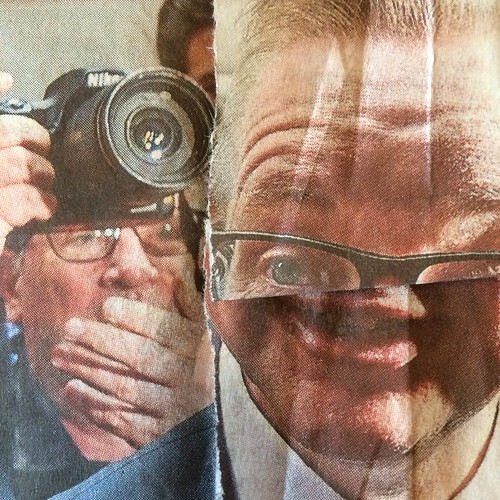
A map of a world. A map of our world. A map of the world of work, of most of us, of the 99%.
Impossible to imagine these images made on streets of a town where less than 50 languages were spoken.
What we see when we look at these is what we see when we look at art.
An invitation to narrative.
Patterns on the one hand // traces of the wake that humans leave behind them in the world.
One of those humans is Joseph C––sometimes the images are records of his interventions in the world of images––those image fold-overs or blends. Sometimes the photos are a record of him as performer, actor, in the world ( but after he has left the stage). Sometimes they seem to place us directly behind his eyes.

I think he looks quizzically at the world. Do you know him––does he look quizzically at the world?
You imagine his eyes darting around––down, to the side, up occasionally, lighting on something, some congruence of objects, pausing to decide whether to make an image…(brows knotted, a sense of pressure, the need to seize the moment…)
look at this; see through this; look into that; make that out
grids; grids; patches of light; a dictionary of cowboy terms
People nail nails, people mend things, people bend things, people break things, people clean, people wash clothes, people read, people admonish, people alert, people have funny feelings––goose bumps, shivers or feelings it’s hard to explain somehow.

I saw a pattern! It was a message to me! It was a message to you. It made me feel…oh…I can’t say what…
This empty table here; those empty chairs there
The café/condiment photos––a series––eating––so basic––and we always remember that but we also think––‘we know this kind of café too’, ‘we go here on these occasions’––and we wonder what kind of a person this serial café goer is, is this an important routine in his life, does it define him amongst others, his friends, colleagues, what does he eat, are the condiments incidental or fundamental to his café visits, does he keep his distance from the condiments, use them with discretion, does he go to the café now only or mainly for his mission to image the condiments or do his meals and his art dovetail nicely, conveniently, pleasantly here. Do his companions laugh when he takes today’s photo? Or does he eat alone?

Cables, pipes, tangles––runes, ciphers, hieroglyphs.
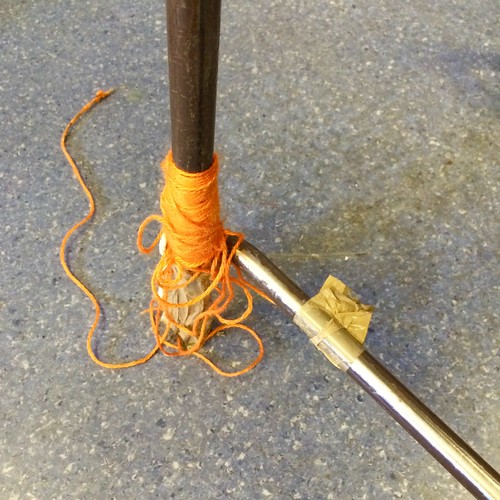
The morning was sunny. It rained. The afternoon was still warm but muggy. There was a rainbow. The sky was blue. The fence was a different blue.
Shadows, folds, stripes, other repetitive patterns. Some there, pre-intended, functional. Some found, loaned, in the process of making the photo.
Objects that are (or have been) useful or functional removed from or seen out of their usual context. (Sometimes by human agency––dumped, temporarily abandoned, or simply cropped)

Estrangement––making us see the world anew // making us remember our world anew.
Found patterns, found juxtapositions.
A lively eye and a lively mind.
Joy in colour. Grace in handling, in apportioning that colour. It’s like he finds the best tidbits and, smiling, hands them to us.
It isn’t abstracting from the world // the function is often still evident so it’s like layer upon layer of meaning and affect and confusion // the original function or action…the strange pattern it makes… its removal from its usual context.
These images lend us Joseph C’s eyes. These images lend us another human’s mind and sensibility.
When you are a child and you’re walking along by the side of a grown-up and they have important things to do or say and so you are free to look around and feel and think and wonder and also you are half their height or less so you have both the utter freedom to look where you will and you lack preconceptions about what it is you see signifies or how it ought to make you feel and on top of that you see it from an angle that will never again be natural to you without a degree of contortion. And you are become magically a kind of still, observing, feeling centre of the world.
Joseph C gives us back some of that.

Despite its image of rapid technological change, progress under capitalism has stalled. Spinning ever faster is not the same as going somewhere. Contemporary Accelerationism wants to take off the brakes, and it is enlisting art’s help to do so.
Taking its name (like every good movement) from one of its critics – Benjamin Noys claims credit for naming the historical tendency in 2008 – contemporary Accelerationism has both a philosophical and a political form with the latter only weakly related to the former. What Epistemic (philosophical) and Left (political) Accelerationism have in common is an attitude of “prometheanism”, of amplifying our capabilities, of rationally overcoming intellectual and material limits. Of hacking the systems of philosophical and political thought to find the exploits that will allow us to increase our knowledge of them, our control of them, our reach through them. Hopefully this will work out better than it did for the original Prometheus of Greek myth (or for Ridley Scott).
Contemporary Accelerationism may seem heretical compared to the “folk politics” and philosophy that it contrasts itself with but it is not (however some people may start essays) the capital-intensifying Accelerationism of 1970s continental philosophy or its killer-robot-welcoming successor in 1990s cyberculture. From the point of view of the former it is too immediately critical of capitalism and from the point of view of the latter it is an off-ramp on the road to the singularity. It is also not the pure speed of Paul Virilio’s dromology, or the experience of lack of time of the overworked neoliberal subject.

Accelerationism is a progressive attitude towards the liberation of reason and production – and therefore selectively technology – rather than the fetishisation of them. The “real” accelerationists in these senses aren’t working at Google, although they might in time exploit technology developed there. Chile’s early 1970s Cybersyn project provides an informative precedent. It sought to accelerate transition to a socialist economy using limited and almost obsolete mainframe and teleprinter technology. Its Accelerationism lay in the attempt to rationally analyse and spur growth in industry to increase the rate at which it developed, not in technofetishism.
Philosophical Accelerationism is “Epistemic Accelerationism”, represented in the writing of Ray Brassier, Reza Negarestani, Peter Wolfendale and others. This is a neo-rationalist philosophy, a programme of “maximizing rational capacity” and the ability to reason about or navigate our knowledge of the world. This is a self-revising, non-monotonic, socially situated reason very different from the logicism of 20th century rationalism and its detractors (although logics have advanced considerably as well).

Two new journals are taking an Epistemic Accelerationist approach to art and culture. In the UK, “After Us” shares a designer with former CCRU member Kode9‘s Hyperdub record label. In France, “Glass Bead” takes its name from Herman Hesse’s imaginary game of knowledge described in his novel of the same name. Both are haunted by the legacy of C. P. Snow’s 1950s “Two Cultures” of science and the humanities, with “After Us” explicitly invoking the need to reconcile them. This isn’t the first time such a move has been called for, and previous attempts make clear that scientists tend to make as bad artists as artists make scientists. The contemporary artworld is also not under-populated by transversal and interdisciplinary research and its aesthetics. Regardless, both provide thought-provoking cultural insights and resources. And the first issue of Glass Bead features, among other articles and interviews, Colombean mathematician Fernando Zalamea, whose accessible promotion of contemporary mathematics and production of a synthetic philosophy based on it deserves much wider attention.
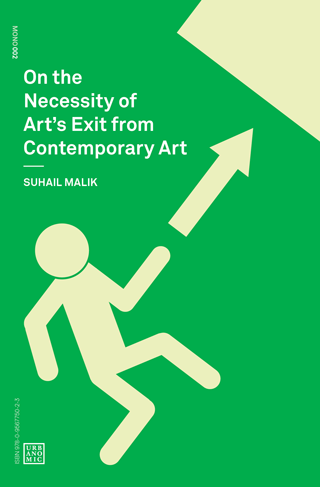
Escaping the radial velocity of asset-class zombie formalism is the focus of Suhail Malik’s “On the Necessity of Art’s Exit from Contemporary Art” (I’ll be reviewing the book for Furtherfield). Malik describes Contemporary Art’s self-image of escape (from society and art’s own limitations into a space of freedom) that disguises an inescapable and complicit recuperation of novelty. To move beyond this he proposes a strategy of exit (which contrasts interestingly with designer Benedict Singleton’s discussion of traps). This is not a seasteading-style fantasy of libertarian secession, rather it is an attempt to identify the next move in the game of art after a long impasse and to return art to a more grounded and constructive role in society.

A group centred around The New Centre For Research (whose events and video archives I cannot recommend highly enough) are seeking to apply neo-rationalism to art in order to effect just such an escape from the outsideless beige singularity of Contemporary Art. This would be an art intentionally constructed to make the rules of contemporary art and of its own construction explicit, allowing artists to reason about this and to thereby come to understand how to escape the seemingly irresistible aesthetic and political cage of contemporary art. Amanda Beech‘s “Final Machine” (2013) prefigures this kind of analysis of the structure of images and their situatedness in the networks of power that produce contemporary art. Diann Bauer‘s collaboration on the art and finance R&D project “Real Flow” is another good example. Bauer has also produced videos for Laboria Cuboniks (see below) and for accelerationism-related events. Beech, Bauer and others have held a series of discussion panels on the subject of “Art and Reason” (one) (two).

Curator and critic Mohammad Salemy has curated a series of art shows with Epistemic Accelerationist themes – “Encyclonospace Iranica” in Vancouver, “For Machine Use Only” in Vienna, and most recently “Artificial Cinema” in Prague. Each of these has created an artistic critical context for networked systems of perception and knowledge, engaging with the political possibility of their being repurposed to more emancipatory ends in the future.
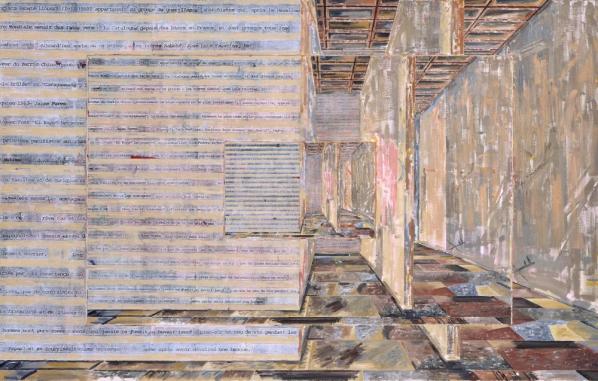
A self-aware, critical, politically committed art aware of its institutional context that is nonetheless still recognisable as art may sound like a stretch but there are precedents in the work of veteran conceptual art collective Art & Language, most obviously in their early “Index” installations and in their later “Incident In The Museum” paintings. There is another way in which Art & Language provide a precedent for the New Centre group – a decade ago they theorised genre as a means of interrupting the frictionless misrepresentations of Contemporary Art, similarly to Malik’s (and, as we shall see, Beech’s) emphasis on recategorisation.
Contemporary political Accelerationism is “Left Accelerationism”, exemplified by the writing of Nick Srnicek and Alex Williams. Initiated by the “Manifesto For An Accelerationist Politics” and fleshed out in the book “Inventing The Future“, Left Accelerationism claims that some of the technologies created by capitalism can be repurposed and even intensified to enable an achievable socialist future and unleash the creative forces in society that they currently repress. As Srnicek and Williams make clear in “Inventing The Future”, this is not in opposition to other struggles but rather a means of materially supporting them.
As a group that often struggles with basic material support, the Left Accelerationist project can hold some appeal for artists. Universal Basic Income (pursued as Srnicek and Williams propose – within rather than as a reason to dismantle the rest of the Welfare State) for example would benefit artists (and musicians, actors and other creatives) in much the same way as earlier welfare state provisions. Artists can support this, rather than having to make the specific moral case for artworld subsidies, as an effective means of solidarity.

Full automation, another of Srnicek and Williams’ proposals, is the theme of the show at Kunsthalle Wien. The diverse work included drives home that art and curation needn’t be propagandistic, uncritical or overly serious to promote or engage with Accelerationist themes.
In their essay in the book “Speculative Aesthetics” (2014), Nick Srnicek proposes an Accelerationist aesthetics of transforming a “data sublime” into forms comprehendible by human beings, an aesthetic of user interface-style efficiency and transparency rather than beauty. The example Snicek gives is of transforming a complex economic model into a tool for the manipulation of economies. In the same volume, Amanda Beech (again) argues that rather than “asking what images mean, or if it is possible to mean what we say” we should produce an art that leaves behind the category of the uncategorisable in order to unravel the political project that contemporary art is subject to.
Likewise Alex Williams’ consideration of Accelerationist aesthetics in the article “Escape Velocities” (2013) emphasises aesthetics as a means of presentation of conceptual spaces, rendering them tractable to the human imagination, as well as explicitly discussing interface aesthetics with reference to Cybersyn. They also mention the concept of Hyperstition, which we will return to below.

Laboria Cuboniks are a pseudonymous collective who have produced the “Xenofeminism” accelerated feminist manifesto. It’s a strikingly designed production (the website was designed by artist Patricia Reed) that is already inspiring artistic production. The “3rdspace” show describes itself as “a response to XF and an exploration into the potentials of technology to escape modern structures of control”, building on Promethean themes.
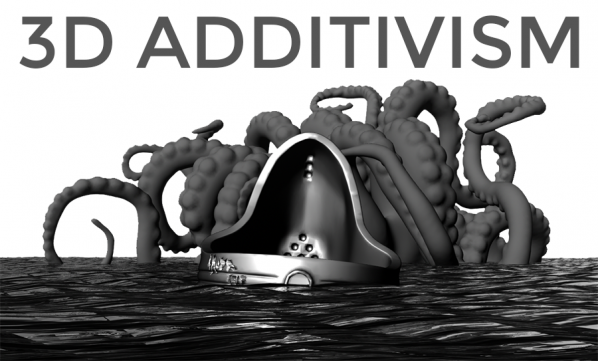
Morehshin Allahyari & Daniel Rourke have produced the Additivist Manifesto for art in the Anthropocene (the video for it features the “Urinal” 3D printable model I commissioned from Chris Webber). They “…call for you to accelerate the 3D printer and other technologies to their absolute limits and beyond into the realm of the speculative, the provocative and the weird”. This is the kind of acceleration through (and into) art that works as both epistemic and left accelerationism without merely illustrating the program of or being instrumentalised by either. It is accelerated critical theory.

And beyond the visual arts, musician Holly Herndon’s most recent album was described by collaborator Mat Dryhurst as being designed to support Left Accelerationism.
While contemporary accelerationism is at pains to signal how far removed it is from CCRU-era Nick Land (let alone their contemporary work), the CCRU’s instrumentalised mythological theory-fiction has resources that are of interest. The slippery concept of “hyperstition”, essentially self-creating science fictional or mythical entities, is key. Cyberspace is hyperstitional, as was the writing of H. P. Lovecraft, as was Neoliberalism, and the music of Hyperdub. They are all unreal entities that bootstrapped themselves into reality via the human imagination. Hyperstition is an example of rational irrationality, or at least rationalised irrationality.

Seeking to harness hyperstition for a moral or political programme has something of the air of trying to summon Cthulhu for social justice, or to turn Skynet into a phone tree, but Williams’ “Escape Velocity” mention of Hyperstition as a means of creating visions of a better future as something that will have been possible is compelling. Hyperstition should be more (mis-)used in art than it currently is, and its creation all but demands activity outside the existing artworld.

International art collective (and CCRU collaborators) Orphan Drift‘s autopoietic mythologies realised in glitch art videos, installations and writing provide a historical point of reference here.
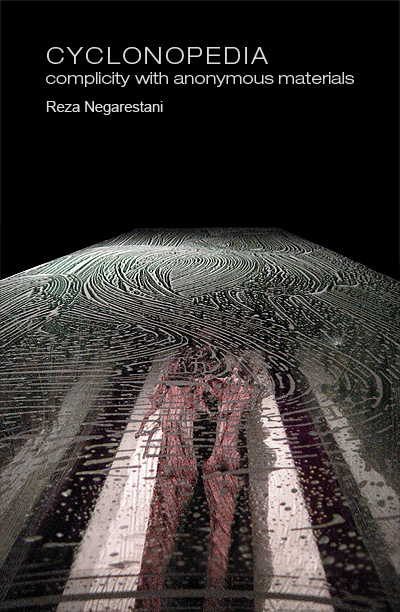
The earlier work of Reza Negarestani serves as a bridge between the CCRU era and the present. His novel of theory-fiction “Cyclonopedia“, 2008, evokes hyperstitional entities from the layers of trauma present in the politics and geology of oil and the Middle East.
In art, reason and rationality may inspire memories of dry conceptualism or stern Soviet abstraction but contemporary art’s hidden and totalising rules are no less binding and are in desperate need of exposure and critique. The task of uncovering and overcoming them presents a challenge to perception and representation that meeting will amount to much more than “art about art”. Perhaps we can use Deep Learning and neural nets to pull the ghosts of genre and medium specificity out of contemporary art then intensify them rather than make puppyslug kitsch… but that’s another story.
Left Accelerationism’s design tasks and the hyperstitional making of its future seems to have always been possible to provide more challenging alternative projects to the manufacturing of yet more zombie formalism, and as “The Promise Of Total Automation” demonstrates this needn’t take the form of uncritical propaganda.
In contrast to these approaches, I feel it’s worth asking what a direct equivalent to Left Accelerationism for Contemporary Art would look like. Which aspects of the contemporary artworld would be worth intensifying, appropriating and pushing further to create an alternative? And what would the vanishing point for such an art be in order to avoid recuperation into the generic space of Contemporary Art?
Accelerationist art is working out how to climb over the event horizon of contemporary art, helping to make a better future seem possible, analysing and transforming technocapital, and ironically intensifying the trajectories of new technology to critical excess. As the logic of neoliberalism colonizes personal space, time and identity, suggesting that we need to move faster in any way may seem perverse or complicit. Accelerationist art is part of a project to grab the wheel rather than slam on the brakes and to thereby move beyond the exhausted constraints and artistic apologetics of the logic that is eating the world.
(Updated 2016-05-18 to include more examples.)
Accelerationist Art by Rhea Myers is licensed under a Creative Commons Attribution-ShareAlike 4.0 International License.
The global financial dictatorship presents us with a paradox: while the economic transactions capable of shifting the destinies of entire countries are the result of performative language, it is language itself that, in turn, is transformed and subjected by the flows of financial markets. Such a paradox may be understood as a negative feedback loop: a relational process in which one of the actors of the relationship is amplified and expanded (the economy) while the other is weakened and submitted (language). The effects of this paradoxical feedback loop on politics are evident and clear: the linguistic exchange which feeds the public sphere, and therefore the possibility of thinking about the democratic organization of society, diminishes and becomes neutralized because of its submission to the market, up to the point of canceling politics itself. Politics, considered as a space where daily life becomes realized, is reduced to an engine which merely executes the algorithms of finance. In this reconfigured field, the common good becomes increasingly unimaginable as individuals are transformed into cellular automata: inside their bodies, the code of economic behavior and the flat, mutilated language that capitalism requires to operate frictionlessly are already inscribed.
Whoever refuses to enter life as a mere cellular automaton will be annihilated by the financial dictatorship, which is currently passing through an extremely murderous stage: necrocapitalism. Achille Mbembe claimed that the ultimate expression of sovereignty lies broadly in the power and the capacity of deciding who may live and who must die. This was known as necropolitics. Today, the dictatorship of finance prescribes a progressive and quick reduction of the sphere of politics, with the aim of canceling the restrictions that laws and codes used to impose on the flow of capital. And governments have indeed shrunk, turning thus into little more than facilitators of the unstoppable progress of capitalism. However, they have not stopped to exercise their operational capacity to kill and let live. True power has been transferred directly into the hands of capital, who now determines which lives should be halted and which should continue. The power of capital has increasingly turned into a murderous one that, nevertheless, is still executed by the officers of the old sphere of politics.
Mexico passed from necropolitics to necrocapitalism not by force but by the signatures of the presidents and ministers of finance of Mexico, the United States of America and Canada who, in 1992, signed the North America Free Trade Agreement (NAFTA). What has happened in Mexico since then? A chaotic chain of privatizations, looting and crime, all of which have been executed with a hitherto unknown intensity thanks to the almost complete destruction of the former sphere of politics.

After the forced disappearance of the 43 students of Ayotzinapa, Elisa Godínez wrote that “it is not surprising that the corporate sector is heading the demands to repress all social protests which directly affect their properties and interests, arguing that the rule of law should be respected.” [1] It is true that, in the post-NAFTA era, such a position comes as no surprise. However, the true novelty lies in the fact that now the Mexican State no longer defends only the interests of national corporations, but also those of multinationals. And this is not a minor novelty: all sorts of extraction industries, for example, have multiplied their concessions and profits thanks to such a defensive stance. And they have done so while devastating lands, ecosystems and people with almost complete impunity. According to data collected by the Red Mexicana de Afectados por la Minería (Mexican Network of Persons Affected by Mining), 450 tons of gold have been extracted from Mexico, a quantity almost three times larger than the 185 tons extracted during Spain’s colonial domination. This unprecedented looting has particularly benefited Canadian and North American companies, who make up almost 85% of all private mining concessions, while paying back a mere 1% of what they extract to the Mexican government [2].
Article 27 of the Mexican Constitution deals with the property of land, water and natural resources. It originally established that “the property of lands and water resources inside the limits of the national territory corresponds to the Nation.” Obviously, this vision had to change radically under necrocapitalism since, instead of recognizing the primordial nature of private property and the right of capitalists to posses it, it indicated that “the Nation” was, in principle, the sole owner. Now, thanks to recent reforms to Article 27, “the Nation” has acquired the right to transfer the dominion over lands and territorial waters (and, consequently, over the humans and non-humans who inhabit them) into private hands. Article 27 is today the red carpet extended by the Mexican State to welcome the financial and linguistic flows and algorithms of necrocapitalism in grand fashion.
The piece “El 27 | The 27th” is an example of what algorithmic politics can be. Far from trying to point to a possible escape from the horror and exploitation of necrocapitalism, algorithmic politics deepens its murderous potential instead. Despite its relative usefulness as a hired murderer, the traditional sphere of politics is terminally ill: it is too old to carry out rapidly and efficiently the demanding tasks of necropolitics. So, once exhaustion has completely died out its powers, politics made by humans will have to be substituted by algorithmic politics, that is: politics made by machines.
In this piece, an algorithm operates directly on the text of Article 27 in the following way: every night, after the activity at the New York Stock exchange has come to an end, a robot obtains its last closing price and its respective percent variation. If the variation is positive, another robot chooses a fragment of Article 27 randomly, translates it into English automatically, and inserts the translation into its corresponding place within the original text written in Spanish. Given enough time, the algorithm will produce a version of Article 27 fully readable in an effective – yet incorrect – English. An automated English that will already have attempted to displace humans brutally, even though they might still be fighting for a territory delimited by language only, and refusing to die. An automated English that will have already eroded a land delimited by language only, rendering it unrecognizable: torn, exploited, almost dead.
“El 27 | The 27th”: http://motorhueso.net/27
“[A] hundred reasons present themselves, each drowning the voice of the others.” (Wittgenstein, Philosophical Investigations: supra note 11 § 478).
For Part 1 click HERE.
For Part 2 click HERE.
Voice and unintelligibility play a greater, complex role in reasoning than the Left or Right accelerationists are prepared to admit, or fail to see. Establishing ones political voice is far broader and extensive than any of these thinkers take it to be, and is not simply the by-product of a phenomenological given unable to envisage any political alternative. Voice has to take priority here, for how else does one actually communicate? By this, we don’t have to take Voice to be the literal act of saying something out loud, or examining the behaviour for doing so. It can interpreted both as a metaphor and means encompassing every political act to which it can be applied; having a voice, or an opinion, hearing the public representation of someone, or of a community, wanting to being heard, letting someone have a say in the matter, etc. Above all it takes on the force of voicing ones own condition.
Might every form of modern communication then, be it a WhatsApp message, a bored glance at a meeting, cynical internet comments to nondescript mumbling, be one of ordinarily voicing our own condition? Perhaps even more so when it is mediated by an infrastructure (sometimes especially so). Both Voice and infrastructure are components of communicating indirectly, as most language games tend to do, whether face to face, face to mirror or interface.
The problem with philosophy is that the ordinary gets blamed, largely as the historical list of philosophy’s complaints almost always aim for the ordinary first as if its triviality is, by itself, not to be trusted with political or rational action. Indeed the very task of calling the ordinary to our attention, takes into account that we have lost interest in it. Perhaps it was already assumed that the market silently reduces the depth of ordinary communication and circumstance to capitalist knowledge anyway. Or maybe since ordinary life is increasingly and consistently mediated through online platforms, technology has overtaken its significance.
Yet what Ordinaryism seeks to uncover is that Voice does not constrain freedom because of its vulnerability: it is only because of vulnerability that voice expresses the freedom to reason in the first place. This is the split that severs both the sovereign rationality of Accelerationism (and Sellars), and the non-sovereign self of Ordinaryism (and Cavell). Indeed, this appears to be Cavell’s political lesson: it seems rational to want build a platform for others to air their democratic voice and decry any ineffective basis in favour something more determinate, more grounded, more inhuman. Yet freedom and justice only begins if a community is capable of ‘finding’ their own voice in the face of injustice. Likewise freedom is constrained if other voices repudiate the voice of others. There is no cognitive purchase for this, and no pre-built, implicit, or explicit ground for determining intelligibility either. So we have to ask, how else can the inhuman make itself intelligible unless it gives voice to its own condition? (As an aside, what else is philosophy but a set of specific and singular voices crying out for recognition in their appeal? A voice that may be acknowledged, yet equally repudiated? Just as the sound and look of Voice matter in reasoning, [how it persuades, how it strikes you] so too does the sound and look matter to philosophising arguments and deductions.)

The easiest way to round these political concerns up is to show how the very need to bypass the vulnerability of Voice, the need to provide an ‘answer’ or ‘solution’ to that vulnerability, is the same philosophical question that concerns solving skepticism. This is the heart of Cavell’s philosophy.
Following Naomi Scheman, the heart of transcendental inhumanism to which the epistemic accelerationists follow aims to draw attention to what underlies the possibility of our ordinary lives. But in Ordinaryism, the Cavellian rejoinder must insist that “the ordinariness of our lives cannot be taken for granted; skepticism looms as the modus tollens of the transcendentalist’s modus ponens.” (Scheman, “A Storied World”, In Stanley Cavell and Literary Studies, 2011 p.99). Whereas Accelerationism posits a renewed set of tools to re-determine intelligibility in an era of supposed ‘full automation’, Ordinaryism speaks to these same conditions but where intelligibility routinely breaks down, is endlessly brittle, always delicate, sometimes connects, but is never ensured or determined by philosophical explanation alone. What might it mean to understand the fragmented world of machines as a uniquely literary responsibility?
In other words, a future world of increased automation needs a romantic alternative. And it is sorely needed, because in this future order where automation is assumed to outpace human knowledge, or supersede it in any case (amplifying existing industries, or creating new ones) Ordinaryism speaks of new moments of doubt which constitute the skeptical fragments of ordinary life with machines. Perhaps also of machines. It might take on a specific personal form of questioning and living with what these new forms takes on; “what does this foreign mapping of data really know about me”, “what does it know about all of us?”, “Am I just being used here?”, “How can I know whether anyone is spying on me?”, “why are they ignoring me?”, “what on earth does that Tweet mean?”, “what’s happening?”, “what am I supposed to think about this”, “Why would I care about you’re doing?”, “I need to know what they’re doing.”
There are innumerable ordinary circumstances where a life with machines begins to make sense, but also starts to break down in all the same places: how might one suggest that a machine “knows” what it’s doing, or that “it knows” what to do? Where does the scalability of automated systems start to break down, and what sort of skepticism does it engender when it does? What happens when software bugs, and unpredictable acts of mis-texting chagrin habitual pattern? How might such finite points of knowledge exist, so as to understand and inhabit systemic doubt? What are the singular and specific means for how such systems are built, conceived or decided? And most of all, how might we even begin to characterise and acknowledge the voices which emerge within these systems? You might say that Ordinaryism wishes to extract acknowledgement out of the knowledge economy.
What is required then, is both a Cavellian critique of epistemic accelerationism (what potential political dangers might arise if Voice is repudiated) and why its solutions to solve skepticism through collective reasoning and self-mastery are no different from skepticism itself. But to do that, one also has to take account of how Cavell brings an alternate approach to imagining how normative rules are implicit in practice. This is not an act of opposition, more of a therapy, which might be needed, especially as politics is involved.
Now, despite the fact that Cavell’s philosophical questions work (almost) exclusively in the Wittgensteinian domain of articulating and expressing normative concepts which regulate speech and pragmatic action (beginning from his first essays Must We Mean What We Say? and his later magnum opus, The Claim of Reason) these texts don’t appear to be required reading in accelerationist and neo-rationalist circles.
Take the newly released art journal Glass Bead, whose aim is to suggest that any “…claim concerning the efficacy of art – its capacity, beyond either it’s representational function or its affectivity, to make changes in the way we think of the world and act on it – first demands a renewed understanding of reason itself.” If such a change in thinking is motivated by a renewed post-analytic approach to reason in a world of complexity (and an additional capacity for aesthetic efficacy), the continued omission of Cavell’s work into reason and aesthetics, is notable by its complete and utter absence. It’s enough to warrant the claim that certain imaginings of reason – in this case the abstract inferential game of giving and asking for reasons – are to be favoured over other types (usually with a secondary, pragmatist demand that science is the only authentic means for understanding the significance of the everyday).
In fact there’s a good reason for that omission: because Cavell discovered that he wasn’t able to ignore the threat of skepticism entirely, and instead discover it to be a truth of human rationality (is there anything more paradoxical than discovering ‘a truth’ in skepticism?). He instead sought to articulate how such concepts were not inherent features of inhuman ascension by means of inferential connection, but fragmented conditions of differentiated identity. In the eyes of the epistemic accelerationist, it’s as if there isn’t any possible option in-between some half-baked, progressive ramified global plan to expand the knowledge of human rationality, and a regressive fawning over the immediacy of sensual intuition. Fortunately, Cavell’s ‘projective’ approach to rationality questions this corrosive forced choice.
Wittgenstein’s Philosophical Investigations sets up the key differences here. Instead of using Wittgenstein’s text as an introductory tool to show how the public expression of saying something can be explained and correctly applied (as Robert Brandom pedantically attempts), Cavell paid attention to Wittgenstein’s voice, as it invokes a specific and personal literary response to what happens when we are in search of such explanatory grounds (and how they always disappoint us). Perhaps more pertinently, Wittgenstein alluded towards an effort ‘to investigate the cost of our continuous temptation to knowledge.‘ (Cavell, The Claim of Reason, p. 241) Compare this to the current neo-rational appeal which has little to no awareness that the pursuit of certain knowledge (and the unacknowledged consequences for when it will go astray) might itself be inherently unproblematic. Because reason presumably.
It’s no accident therefore that Philosophical Investigations has become one of the oddest literary feats in Western philosophy, insofar that it presents itself as a personal account, rather than a systematic one. Cavell was not only the first to prise out a Kantian insight from Wittgenstein’s text, but also to ask the simple question of why does he write like this? It’s as if every single word, every ordinary word, now takes on the full power and insight as any theoretical term of jargon: as if a theoretical vocabulary isn’t wanted or needed. Why does Wittgenstein provide provocative literary fragments to elucidate his philosophical struggles? (the infamous ‘mental cramps’) Why does he raise literary devices to flag up disappointing conclusions: where a rose possesses teeth, beetles languish in boxes, and lions speak in packs of darkness? It’s an insight which lies in acknowledging that Wittgenstein’s unique literary voice is inseparable from his philosophical ambitions. It is not that he offers an anti-skeptical account to fully fix and explain what it means to say something: nor does he posit an implicit mastering of normative concepts, whereupon said possibilities are subject to further explanation (the conditions under which cognition or experience become possible).
It’s as if the theoretical problem doesn’t come with fully understanding norms implicit in practice, but the very situation in which using words like “rules”, “freedom”, “determine”, “correct” and so on, do not have the desired theoretical effect (in the accelerationist case, freedom). These are very nice words after all, but the neo-pragmatist theory is found wanting in their full expression, sufficient to the limits given when they are spoken not as a licensed inference, but as a creative effect. Cavell’s take on language thus, is that there is always something more to words than the current practice in which they are put to use.
The appeal to Wittgenstein’s literary conditions is what motivates Cavell to suppose that his theory of norms in practice isn’t something to which words are used to line up a certain conclusion, rather, the specfic and singular non-formal ordering of ordinary words in themselves provide a certain crispness and perspicuity, as well as difficulty and confusion. As Paul Grimstad suggests:
“Cavell wonders what one would have to do to words to get out of them a certain kind of clarity; to ground their meaning in an order. A kind of literary tact—the soundof these words in this order—would then serve as the condition under which we are entitled to mean in our own, and find meaning in another’s, words. The sort of perspicacity striven for here is not a matter of lining up reasons (it would not be “formal” in the way that a proof is formal), but of an attunement to arrangements of words in specific contexts.”
As Sandra Laugier chooses to describe it, Cavell’s posing of the Ordinary Language Philosopher’s question – “What we mean when we say” arises from “what allows Austin and [the later] Wittgenstein to say what they say about what we say?” For Cavell jointly discovered a radical absence of foundation to the claims of ‘what we say’, and further still, that this absence wasn’t the mark of any lack in logical rigour or of rational certainty in the normative procedures that regulate such claims. (Laugier, Why we need Ordinary Language Philosophy – p.81)
If agreement in normative rules becomes the presupposition of mutual intelligibility, then any individual is also committed to certain consequences whereupon certain rules might fail to be intelligible. Therein lies a simple difference: the espousal of following a universally applicable rule (as Brassier holds) and everyone else wondering whether that same rule has been correctly followed.

To mean exactly what we say, or to mean anything in fact, might be contingently mismatched to the specificity of what we say and project in any given context, hence one must bare the normative challenge that *what* we mean may differ from what we say.
The ordinary is saturated with these innumerable variations of mismatch through specific and singular situations, to which our attunement is threatened: when a co-worker fails to turn up to a meeting because they misunderstood someone’s directions or when a poor sap fails to get the joke he or she is the brunt of, or when a close friend misunderstands a name in a crowded bar. These moments are not insignificant wispy moments of human limitation swallowed up in a broad history of ascension, but become the necessary exhaust that emanates from a social agreement in which the bottom of our shared communal attunement falls away. With a language, I speak, but only insofar as we are already attuned in the projections we make.
As Cavell put it in this famously long (but necessarily long) passage;
We learn and teach words in certain contexts, and then we are expected, and expect others, to be able to project them into further contexts. Nothing ensures that this projection will take place (in particular not the grasping of universals nor the grasping of books of rules), just as nothing ensures that we make, and understand, the same projections. That on the whole we do is a matter of our sharing routes of interest and feeling, modes of response, sense of humour, and of significance and of fulfilment, of what is outrageous, of what is similar to what else, what a rebuke, what forgiveness, of what an utterance is an assertion, what an appeal, when an explanation – all the whirl of activity that Wittgenstein calls “forms of life”. Human speech and activity, sanity and community, rest upon nothing more, but nothing less, than this. It is a vision as simple as it is difficult, and as difficult as it is (and because it is) terrifying. (Cavell, Must We Mean What We Say? p.52)
If the reader might allow a Zizekian-style joke here (apologies in advance), it might elucidate Cavell’s insight further than the lofty quote above: “Two guys are having an heated exchange in a bar. One goads to the other, “what would you do if I called you an arsehole?”, to which the other replies “I’d punch you without hesitation.” The first guy thinks on his feet: “well, alright, what if I thought you were an arsehole? Would you hit me then?” The second guy reflects on his reply, “well, probably not” he says, “how would I know what you’re thinking?” “That settles it then,” says the first guy, “I think you’re an arsehole.”
Although the mismatch is played to (a rather ludicrous) comical effect, it offers a way into Cavell’s strange appreciation of skepticism’s lived effect. We intuitively know these ordinary situations, ordinary utterances and yet such acts are not instances of reason ascending its limits through knowledge, but are necessary and specific instances where reason’s endless depth and vulnerability enacts itself within such limits. The intelligble process by which the concept of “I think you’re an arsehole” arises, does little only to serve how brittle the semblances between saying and thinking portray. This for Cavell produces an anxiety; and it “… lies not just in the fact that my understanding has limits, but that I must draw on them, on apparently no more ground than my own.” (Claim of Reason, p. 115).
But it also presents a shift from the commonness of ordinary language to the question of a community where that commonness resides. And for Cavell if it is the case that there’s no firmer foundation than shared practices of common speech and community, there cannot be a shared conceptual framework, so as to collectively determine an objective intelligible method of treating and avoiding skeptical claims. Thus, any instability between what we find intelligible (what we cognitively understand or grasp) and how it is expressed in what we say, is also indicative of the social and cultural conditions that sustain such vulnerabilities. This is why for Cavell, the social conditions of a language game are fundamentally aesthetic in character, because we are both attuned to the conditions of a game and the experimental moments in which one tries out new and progressive literary arrangements that push against the game’s limits.
Which is why the history of the inhuman is constitutive of skepticism as barbed wire is constitutive of blood stained fences. And in conclusion, we’ll begin a preliminary move towards a bona fide Ordinaryist alternative to epistemic accelerationism (to be fleshed out in the final part). Key to this alternative is to understand that reasoning is not explainable by rule-governed inhuman rationality, but has a hand in the general projection of words, criteria and concepts in ordinary language (and moreover how inhuman Exit threatens this reasoning). Just because political action within reasoning can often fail to be intelligible, does not render it subject to inhuman ascension.
Nonetheless, Accelerationism operates as if there’s no other type of future worth wagering on, nor any method other than the force of reason suitable enough to supply the tools required. The morality put forward hence is that the more we are able to harness our knowledge of our social and technical world, the better we will be able to effectively rule ourselves and the greater chance of a strategy to overcome capitalism. The chief rejoinders that usually face criticisms of renewing the Enlightenment, consist in labelling detractors as complicit with skepticism, misunderstanding skepticism, languishing in sophism, abandoning reason for irrationality, justification for complicity, and trading off modern knowledge for theological assumption. Brassier recently referred to this skeptical questioning as the “unassailable doxa” of the humanities, constitutive of an influential strand of 20th Century European philosophy (from Nietzsche onwards), where the desire to know is “identified with the desire to subjugate”. Brassier goes on;
This is skepticism’s perennial appeal: by encouraging us to give up the desire to know, it promises to unburden us of the labour of justification required to satisfy this philosophical desire. Thus it is not certainty that skepticism invites us to abandon, but the philosophical demand to justify our certainties.
What Brassier takes for granted however, is that refusing to adhere to the force of reason and the ongoing project of attaining knowledge does not instantly amount to embracing skepticism, or that such knowledge will always be inadequate (and a violent act). What is at stake is not *simply* an inadequacy of knowledge as a cognitive resource. To view it as this, is what Cavell associates as skepticism, even if the desire is to then overcome it, or, in some way pushing skepticism to a deeper conclusion. The issue is not sophism, but skepticism.
Cavell’s romantic inclinations towards ordinary language philosophy offers a way out of this forced choice: skepticism simply cannot be refuted in favour of a renewed inhuman anti-skepticism. Entertaining skeptical doubt isn’t something which philosophers are especially adept at, treating it as an intellectual error to refute or ward off afterwards. Skepticism inhabits itself as an everyday, ordinary occurrence, equally puzzling and troubling, eternally unsatisfied and yet utterly enticing. It is a strange, yet equally relentless human drive to repress and reject the very attuned conditions that sustain intelligibility: conditions which also contain the ability to attune to one another’s projections.
In consideration of the fact that Accelerationism wants to conceive our conditioned intelligibility as a product of rule-governed knowledge this poses problems worthy of the best tragedies the humanities have to offer. Here’s Cavell’s take on the matter (my emphasis):
I do not […] confine the term [“skepticism”] to philosophers who wind up denying that we can ever know; I apply it to any view which takes the existence of the world to be a problem of knowledge […]. I hope it will not seem perverse that I lump views in such a way, taking the very raising of the question of knowledge in a certain form, or spirit, to constitute skepticism, regardless of whether a philosophy takes itself to have answered the question affirmatively or negatively. (Cavell, The Claim of Reason, p.46).
Brassier would probably lambast this certain condition as a conformist view of ‘I should or ought to live my skepticism’, such that it hides an implicit refusal to investigate or question these forms (leading to various, inexorable ‘end of’ philosophies). But in doing so he takes on, at least in Cavell’s eyes, the compulsive epistemic assurances that skepticism compels. By implication Brassier’s endorsement of an anti-skepticism hides the fragility and depth of normative claims, and that claims are always voiced and projected. The problem with espousing rules for generating normative freedom is that a rule is neither an explanation nor a foundation – it is simply there (note that in saying this Cavell does not deny any rigour, moral or political commitments to normative rules). What Brassier and Accelerationism share is to answer a source of disquiet; that the validity of our normative claims seem to be based on nothing deeper than ourselves, or how words are put. And this attempt to reject Cavell’s insight, to erase skepticism once and for all, backfires only by reinforcing it.

Cavell’s treatment of skepticism is that it must be reconfigured away from an entrenched view of epistemological justification as a product of certainty: or that the existence of other minds, objects, procedures, processes and worlds can be reduced to problems of (and for) knowledge. The head on effort to defeat skepticism allows us to think we have explanations when in fact we lack them. Or put better, the idea that we can theorise a clean break from skepticism is itself a form of skepticism. The point is that we clearly can approach communities, other minds, systems and communities which often appear incomprehensible, unintelligible; but such appearances are features of vulnerability, and vulnerable grounds which we depend on nonetheless. Yet change only occurs not because we’re certain about the knowledge we possess, but in response to others whose involvement happens to be beyond my intellectual attempt to know them with certainty. There is nothing more uncertain than a response to alterity.
Politics operates exactly in this way, coming to terms with ones immediate response to injustice, not in “knowing” it or offering an explanation, but by acknowledging it. The “folk” vulnerabilities that Srnicek and Williams find ineffective are constitutive of intelligible injustices that we must acknowledge in order to engage at all. Nothing guarantees this. This is the central point: reasoning with the inhuman, requires a human appeal to acknowledge another – or put differently, making the inhuman intelligible requires that we acknowledge the voice of the inhuman (and equally that this same voice can reject our appeals). After all, what use is a politics based on the epistemic assurances of knowledge, if such knowledge can be regularly doubted?
What Brassier doesn’t acknowledge is that both his position and the skepticism he attacks, are guilty of the same premise: the longing for a genuine inhuman knowledge, without acknowledgment. This appeals to something greater than the everyday which gives voice to such justifications. Nihilism might be fun, but at some point its political actions soon becomes silent to its own screams, as it spins into a void of its own making. The ordinary prevails.
Cavell suggests that this philosophical impetus towards the inhuman is inherent to the skeptical habits of philosophical drive, for there is:
…inherent to philosophy a certain drive to the inhuman, to a certain inhuman idea of intellectuality, or of completion, or of the systematic; and that exactly because it is a drive to the inhuman, it is somehow itself the most inescapably human of motivations. (Conant, “An Interview with Stanley Cavell,” in Fleming & Payne, eds., The Sense of Stanley Cavell, 1989)
Unlike most ordinary language philosophers, Cavell has always been clear that the appeal to ordinary language is not the same as refuting skepticism (as some disciples of Wittgenstein might have it). Nothing is more skeptical, more aversive to the everyday that the “human wish to deny the condition of human existence” and that “as long as the denial is essential to what we think of the human, skepticism cannot, or must not, be denied.” (Cavell, In Quest of the Ordinary, 1988, p. 5) In fact, most of Accelerationism’s Promethean attempts in fully maximising the human drive to transcend itself, were preempted by Cavell: as the skeptics’s treatment of the world (and others) is endless, completely prone to acceleration. One might say, acceleration is built into skepticism when the human mind convinces itself that the world is divorced and devoid of meaning – it encounters nothing but the meaningless of itself. It becomes a tragic temptation which the human creature carries out, an internal argument that it can’t quite relinquish. Or as Cavellian scholar, Stephen Mulhall puts it simply. “the denial of fintiude is finitude’s deepest impulse.” (Mulhall, The Self and its Shadows, 2013, p.48)

Accelerationism becomes a tragedy. A tragedy of never quite knowing what knowledge is enough, or when (it’s tragic enough that in theorising the emancipatory potentials of technology, it hasn’t appeared to go any further than incessantly arguing about it with others on blogs and Facebook threads – this author included).
However this shouldn’t be too much of a surprise when you have a political movement which shares an enthusiasm for building AI systems that are (quoting Mark Zuckerberg early last year); “better than humans at our primary senses: vision, listening”. When Facebook’s CEO thinks it’s unproblematic to invent a future sending unmediated telepathic thoughts to each other using technology (and your response to this is that it’s merely constrained by neo-liberal market forces) skepticism has reached a new apex. Ordinaryism makes no conservative attempt to preserve some fabled image of humanism located outside of technology, nor provide any Heideggerian technological lament, but instead reflect on what this tragic apex of skepticism will mean for us, what it says about our condition, and how the vulnerabilities of Voice make themselves known nonetheless. More than anything, how will this new apex of skepticism change the ordinary?
No doubt the Left-Accelerationist’s hearts are in the right places: but nonetheless, the dangers become obvious. If the solution to overcoming capitalism takes on the same inhuman skeptical impulses for epistemological certainty that constitute it, what exactly stops the Left-accelerationist’s proposals from being used for reactionary purposes? What sort of decisions must it undertake to control the ordinary, and to that effect, the ordinary voices of others who might doubt their knowledge?
This is why Cavell takes skepticism to not only be the denial of reason having any epistemic certainty, but the entire explanatory quest for epistemic certainty tout court. Both are latent philosophical expressions of what he calls ‘the skeptical impulse’ and both inhabit the very denial of this impulse whilst also becoming its mode of expression. The problem with attaining knowledge of the world, isn’t knowledge, but its theoretical desire for knowledge as certainty. Brassier would have you believe that any deviation from the emancipating Platonic discipline of ascending human finitude – the desire to know – risks disengaging reason from mastering the world. Whereas in the ordinary, reasoning becomes essential because it can never master the world, only inhabit its projections. Under ordinary circumstances reason can only appeal, in numerous and multifaceted paths, experimenting with different kinds and types of intelligibility taken from a shared linguistic attunement. It’s ability to appeal is never achieved as ascendancy, but by the endless vulnerabilities of ordinary language. Intelligibility is a continual, vulnerable task, who failures become the engines for relentless re-attunement with others and the world. Exactly ‘what’ is said, ‘how’ something is said, can make all the difference: and in politics, especially so.
Reason shouldn’t and doesn’t progress by ascending itself, it progresses by tiptoe. It re-engages with the world critically, and can only appeal to others in doing the same. The moral desire of Ordinaryism is exactly this: not to exit the world, but to be in it, to be present to it, and give it and others a voice which might make that desire intelligible, so as to modify the present situation. This is why we always have to acknowledge what we say when. To show how the world attracts itself to us and how it does so in each singular and specific case. When the future comes, it’ll emerge (as it always does) in some sort of vulnerable ordinary way.
Refuting skepticism, is in itself a performative expression that simply repeats skepticism; it denies the very truth and reality of living a skeptical existence, that knowledge as certainty is an ongoing disappointment. Quoting Sami Pihlstrom, “…there is no skeptical failure here requiring a “solution”; the attempt to offer a solution is as misguided as the skeptic who asks for it.” (Pihlstrom , Pragmatic Moral Realism: A Transcendental Debate, 2005, p. 76). Once the fight to close down skepticism is enacted, accelerationism encourages its major conditions – that the problem of knowledge about the world, of other minds, of systems, global insecurities, economics becomes a problem of certainty. And yet, at the same time, Accelerationism neglects skepticism’s fundamental insight that there are specific and important problems about the role of knowledge which might have to be acknowledged. It neglects the truth of skepticism. We live our skepticism. Daily.
The surprising conclusion that arises from this quagmire, is that the skeptic is in fact right – and yet, simultaneously, skepticism is fundamentally wrong. Well, not exactly wrong: just a refusal to accept that the human creature is also a finite creature, or as Cavell put it, skepticism manifests itself as “…the interpretation of metaphysical finitude as intellectual lack.” (Cavell, In Quest of the Ordinary, 1988, p.51). As Áine Mahon puts it, “Cavell’s strategy is paradoxical: he strips s[k]eptical doubt of its power precisely by showing that it is right…. the skeptic’s doubt results from a *misunderstanding* of the truth she discovers.” (Mahon, The Ironist and the Romantic, 2014, p. 23). He takes skepticism to not only be a standing menace that denies an ordinary intimacy with the world, but also as a necessity to acknowledge ones finitude. For Ordinaryism too, also challenges political immediacy that Srnicek and Williams lament, but does so on the grounds of renewed intimacy with the ordinary. The issue is not binary: either of knowing or not-knowing, but of acknowledging (and regrettably, failing to acknowledge). The ordinary is grounded, not on knowledge (implicit or explicit), explanation, proof, logic, nor material, it’s grounded on nothing more and nothing less, than the acknowledgement of the world.
For the skeptic is in fact right, because everyday knowledge is vulnerable: the existence of the external world, other minds, and God falls outside the scope of what language can prove. Wittgenstein’s criteria can tell us what things are, but not whether things actually exist or not. This, however, does not mean that Cavell doubts the existence of things, and especially not the existence of other minds. It means that ultimately, such modes of existence must be accepted and received: moreover they have to be recovered and acknowledged.
Bracketing the abstraction here, one can immediately look to timely instances of ordinary life, in which Cavell’s ideas on skepticism seem at first distant, and then suddenly intuitive. Consider the natural, anxious reality of parenting for example (interwoven within a broad tapestry of anxiousness). I speak of first time parenting predominantly here: for doesn’t the very task of living with skepticism, responsibility and finitude, become central to the activities of childrearing and all attempts to find clear answers to the contingency, uncontrollability and unpredictability it engenders? It’s not the normative fault of parents for wanting to find something deeper, clearer and surer in order to solve the anxiousness that childrearing brings: but yet equally nothing solves it either. But there isn’t any normative basis, or universal demand for suggesting that a parent ‘ought’ to know, or ought to justify an explanation on the act of learning how to parent effectively. One simply does so, but in doing so, skepticism is not refuted, or made to temporarily vanish by competent practices alone: it is lived. More importantly, it is lived with others who also live it.
This is what Brassier’s anti-skeptical demands of accelerationism gets wrong: it makes the wrong normative demands on what ‘ought’ or ‘must’ be attained for the conditions of intelligibility to function. He makes little contention in suggesting that skepticism might also be understood as a failure to accept human finitude (Cavell, In Quest of the Ordinary, p.327), than it is a failure to justify one’s certainty in knowing. Nothing is more skeptical than the precarious efforts to reconstruct human language and communication on a more ‘rational’ or more ‘justified’ foundation, one which would avoid any need for a less tidy, ambiguous, disruptive – and above all – vulnerable aspect of ordinary expression.
It completely bypasses any option that having access to other minds and the things of this world can operate on anything other than certain knowledge. No doubt we have knowledge, and it runs deep, but it also has clear limits. As Cavell brilliantly words it; “the limitations of our knowledge are not failures of it.” (Cavell, The Claim of Reason: p. 241) Is there anything that undermines the accelerationist premise more than the ill-fated attempt to pit human knowledge against an inhuman idea of knowledge? Or if it appears that computation has no limits, neither should humans? Of course the issue here is staked in the idea that computational reason is a transcendental destiny of human knowledge, when in ordinary practice, it automates all the same vulnerabilities that chagrin us daily.

By implication any form of skeptical utterance or speech becomes unintelligible, meaningless, and thus not amenable to normative, rational ascension. By another, machines operate in a weird inhuman world of untapped knowledge, which humans are yet to match their conditions to. But this is not just an accurate reflection of ordinary speech, it’s not even an accurate reflection on how computers work as a specific and singular thing.
Epistemic Accelerationism falls into a skeptical trap – whilst all the while, masquerading itself in as a new heroic anti-skeptical saviour of reason: when knowledge becomes disappointing or fails, it flips into a binary skeptical register of an either/or: either we have knowledge or not at all. But whilst the skeptic realises that true knowledge cannot be attained, they opt for the total withdrawal from any access to the world whatsoever. Anti-skepticism takes on the basic contours of this view, and opts to simply refute skepticism wholesale, reducing the world to laws of thought.
The result of unexpectedly reinforcing skepticism is not (as the skeptic and anti-skeptic thinks) that the world becomes unknowable, or we lose the capacity to claim anything, but that we ourselves become unintentionally mute and unknowable to others. In political terms, this has much to do with how the sovereign usurps the voice of its subjects, rejecting the acknowledgement and attunements of a shared world, evading the responsibility of others to speak politically for themselves by losing the ability to express a political voice. It omits the possibility of an alternative exemplar voicing injustice on behalf of members within a community.
A claim’s meaning is a function, only in its specific use in a specific context but a specific speaker. Epistemic Accelerationism, in speaking to a universal inhuman knowledge evades any sort of position that attempts to speaks on behalf of others, or allowing others to speak, by speaking on behalf of no-one. Except probably machines. With speaking in general, claims of reason are more about saying something as a literary responsibility for what we say (and the specific literary insecurities for how it will be treated, communicated) than it is playing a game of giving and asking for reasons (in what sense is there even a ‘we’ in a game of giving and asking for reasons?). Making claims intelligible means paying attention to such ordinary literary conditions.
For Cavell, acknowledgment operates as a wider form of knowledge which cannot be a function of certainty. Acknowledgement is a delicate concept, specifically created to oppose the idea that intellectualist knowledge attains entirely new information about the world. Instead we acknowledge, that is, re-conceptualise things that have always been before us: what (or that) we already know. What we ordinarily know, as if we approached it for the first time, can suddenly become vulnerable. Therein perhaps provides a putatively solid difference for what aesthetic claims do, separate to scientific ones; science provides new knowledge about the world, aesthetics re-conceptualises what we already know. Influenced by Cavell (and equally Arendt and Butler), Rosine Kelz, encourages this insight, stating that;
…it is precisely when we come into contact with others that the finitude of knowledge and understanding most sharply comes into focus. [Cavell] maintains that communication can not only potentially fail, but that indeed the failure to grasp and communicate ‘fully’ is a defining feature of the human condition, [and]… is mired by our inability to control not only what the other understands or acknowledges, but also by an unwanted ‘excess’ where what we say always reveals more than what we intend. (Rosine Kelz, The Non-Sovereign Self, 2015, p.80).
In the face of political injustice, acknowledgement might take on the marginalisation of race, gender, migration, class. We can only know these political injustices, not through certainty, but by paying attention to particular situations we already acknowledge and respond to (in the same way the ordinary language philosopher responds to how the literary responsibility of ordinary language is specifically voiced and projected). As Cavell puts it in this famous passage:
How do we learn that what we need is not more knowledge but the willingness to forgo knowing? For this sounds to us as though we are being asked to abandon reason for irrationality… or to trade knowledge for superstition… This is why we think skepticism must mean that we cannot know the world exists, and hence that perhaps there isn’t one… Whereas what skepticism suggests is that since we cannot know the world exists, its presentness to us cannot be a function of knowing. The world is to be accepted as the presentness of other minds is not to be known, but acknowledged. (Cavell, Must We Mean what We Say?, p. 324)
‘Justification’, ‘political change’ and ‘practice’ in this regard, must also be reconfigured by the same method of acknowledgement and presentness. Because skepticism and anti-skepticism start from the same desire, they provide greater explanatory positions than they actually can. Anti-Skepticism’s “self-portrait […] tends to [..] scientize itself, claiming, for example greater precision or accuracy, or intellectual scrupulousness than, for practical purposes, we are forced to practice in our ordinary lives.” (Cavell, In Quest of the Ordinary, 1988, p. 59). Or is accelerationism still pretending that philosophers, futurists and scientists have special access to knowledge that bearers of ordinary language fail to possess?
Cavell’s point is that there is knowledge in acknowledgment, but one that is ethically responsive and politically culpable in projecting political change into the world. This is politically significant insofar as acknowledging someone or something isn’t a practice of seeing what we had previously missed, or not known, but takes on the role of an admission: a confessional quality to it. After all in confessing, you don’t offer an explanation for your reasons and claims, you can’t be certain about them: you can only persuade, or at best describe how it is with you. But there is a wider, ethical and political issue that splits apart the task of certainty in knowledge and the vulnerability faced (and facing) us in acknowledgment – and it has a polarising effect when reason is limiting. As Cavell puts it;
A ‘failure to know’ might just mean a piece of ignorance, an absence of something, a blank. A ‘failure to acknowledge’ is the presence of something, a confusion, an indifference, a callousness, an exhaustion, a coldness. (Cavell, Must We Mean what We Say?, p. 264)
This is at the core of Ordinaryism’s return to a progressive romanticism. Having the philosophical demand to justify our reasons is perfectly respectable: but in attempting to force this task because the demands of thought have failed to know the world, is something else entirely.
It will require a Romantic return for philosophy to become literature, not in the literal sense of imprisoning a subject in language, but the complete opposite, insofar as “literature” names the tension between the projection of words and their future applications. Nowhere is this more perspicuous than in the use of online platforms, and our increasing reliance on them for sharing communities. In this new sense, Ordinaryism – in its most romantic set of moods – sets itself an alternative task, which as Cavell puts it, “the task of bringing the world back as to life.” (In Quest of the Ordinary, p.52f) as if we became astonished with a quiet, naive disbelief that the world and ordinary communication existed at all, or took it to be obvious. But a more helpful way to look at it, is that Ordinaryism is open to modes of expression that require acknowledgement of something beyond the reach of conceptual assertion, both of human creatures that reason in a shared social practice and of the world. Regrettably these are possibilities which Accelerationism and the history of the Enlightenment rule out a priori.
The question that follows, one that for Cavell was too early to consider, is why our current technological situation has made us think otherwise? To what extent has the freedom to Exit become entirely obsessed with a certainty of knowledge that smart technologies supposedly provide? And why is Voice, (understood in these terms as ‘ineffective’ and indirect ‘human’ communication) now viewed with suspicion and redundancy? To provide an insight requires understanding how the eventual ordinary can arrive under the hood of explicit awareness: and how such Cavellian themes of projection, acknowledgment and attunement now play different, albeit, new defining roles in lives insatiably entangled with digital culture, infrastructure, automation and computation.
By any standard, our response to the future will be established by our changed attitude to reason and freedom. When faced with the onslaught of the Anthropocene, and diminishing opportunities to establish a progressive alternative of change, we might need to be clearer with how reasoning comes to emerge: is it through the self-determination of ascension or the persistent acknowledgement of its vulnerabilities?
Robert Jackson continues with a second journey into the realms of Accelerationism and Ordinaryism. Having articulated how Accelerationism merges Enlightenment principles in a supposed age of automation, Jackson interrogates its philosophical roots by suggesting that the core motivation behind its key approach embraces skepticism (even if the explicit method is to reject skepticism in favour of increasing applications of knowledge) – whereas what Ordinaryism suggests (following Cavell) is that skepticism cannot be refuted nor endorsed, only inhabited as a salient vulnerable conditon. The political implications of this division are telling and can be extrapolated through the freedom to Exit (inhuman acceleration) versus the freedom to find ones Voice (Ordinary appeal).
“But who is the authority when all are masters?” (Cavell, The Claim of Reason, p. 180).
For part 1 click HERE.
For part 3 click HERE.
In its philosophical usage ‘skepticism’ [i] hardly surfaces, if at all, in the contemporary Accelerationist lexicon. This is to be expected: as its political aspirations are organised by a cascade of philosophical trajectories designed to either refute skepticism, or as ordinaryism will claim, not bother to take it seriously enough.
Ordinaryism and Accelerationism approach familiar problems, even familiar desires, from familiar starting points, yet ultimately arrive at different conclusions. Most notably the political desire to overcome the intellectual chagrin of postmodern skepticism. Exactly what sort of overcoming is required feeds the conflict put forward: a conflict which has its history in the activity of reasoning as referenced earlier between Wilfrid Sellars and Stanley Cavell’s divulging and unique approaches to post-analytical knowledge.
Part 2 explores the following discord: Accelerationism (specifically its neo-rationalist, epistemic variant) builds a collection of political arguments which in order to work, have to refute skepticism. This is akin to (but not conflated with) the removal of skepticism in political emancipation through the practical competency of conceptual, normative reasoning. Ordinary, everyday experience is only considered as a human constraint that can be overcome or explained by a technological inhuman sovereignty of collective reasoning, where linguistic practice is essentially procedural, explanatory, functional and rule-governed. Alex Williams put it this way in his 2013 essay ‘Escape Velocities’;
Accelerationism in this guise is the project of maximizing rational capacity—the contents of knowledge about the world—and enabling the ramification of the conceptual space of reason… Enlightenment, rather than entailing an edifying reassurance of the humanistic order, instead gradually but irreparably modifies the manifest image of ourselves-in-the-world, stripping back the comforting homilies of humanism to reveal, Terminator-style, the gleaming bones of Sellars’s empty, formalist, rational subject lying beneath.
Ultimately Ordinaryism and Accelerationism want the same outcome though: the progressive aim for a better future in the face of the immediate everyday. But whereas Accelerationism thinks this can be achieved through the ascension of reason, Ordinaryism thinks it can be achieved only by acknowledging reason’s vulnerability. We must attend and attune to a diurnal world and others around us through the emotional exposure of claims rather than the Promethean expanse of the stars. Ordinaryism interrogates this force of Accelerationist reasoning and seeks a romantic alternative located in the epistemic, ethical and aesthetic priorities of responsiveness, alterity, otherness and appeal that are constitutive of the everyday and its fusion with technology. The larger attempt calls for the everyday to be reclaimed whilst surrounded by the purported effects of a ‘knowledge economy’. How is it that everytime we appeal for a new future, we are really appealing for a ‘new normal’?

The diagnosis establishes itself in the role of skepticism: and for Ordinaryists, skepticism cannot be refuted – only inhabited. Epistemic doubt has to be lived and coped with. The Cavellian lesson of the ordinary is that the world isn’t to be known, but to be acknowledged: a viewpoint which, presumably, would make the accelerationist hairs stand on end. But this not to say that ordinary acknowledgement – the everyday in general – is tantamount to political complicity and illusive habit. Ordinaryism only establishes an interest in what Cavell terms the eventual everyday, against the actual everyday of common sense, responding to the ordinary as if it appeared to us for the first time. Our relationship to others, and of the world, isn’t an exercise of philosophical skill which can be explained or solved because of an intellectual error, with its ambiguities swiped aside or viewed as insufficiently limiting. Nor is this condition indicative of ‘ordinary beliefs’ in public consensus whilst experts and technicians manipulate the structural groundwork behind the scenes: it is central to the democratic possibilities of all political activity. Bringing Cavell’s views of skepticism into focus allows us to acknowledge that politics is not well-serviced from a detached epistemological point of view: or an inhuman, impersonal space of reasons. One might wish to ask, why should any appeal to the strange tendencies of the inhuman take priority, when the familiar is equally as strange?
And following Cavell, the ‘ordinary’ in this view, is taken from the ordinary language philosopher’s commitment to reasoning. It appeals to “what we should say when..”: that any ordinary voice, what we ordinarily say, ordinarily mean, ordinarily know, has the same authority as any other when responding to what a situation calls for. Moreover, with ordinary language philosophy’s technique (in particular its leading practitioner J.L. Austin), one can simply take an instance of a word, used with certainty (I am free, I know) pick out all the ordinary, ambivalent uses philosophers don’t bother addressing, only to reveal as if for the first time, what it is we ordinarily accept everyday.
It’s a radical challenge that has a loose origin in Romanticism, but can be hinted at through punctuated periods of twentieth century philosophy. However the idiosyncratic musings of Wittgenstein interest us here, or at least those brought into fruition by Cavell’s masterpiece The Claim of Reason building towards later work on Emerson. Cavell remains indispensable here insofar as his collective, idiosyncratic view imparts a view of language, justification and reasoning based on the never-ensured acknowledgement of one other (and the claims of what we ordinarily say through one’s voice), in each specific and singular case of reasoning. This will be opposed against a neo-rational appeal to a universal inhuman force, waging on some quasi-guarantee that reason is alien, determinate and self-correcting.
In the space given I won’t be able to replicate the philosophy here at its most sophisticated, so we’ll have to settle for a more general level of enquiry that collates various, repeated aspects of the conflict involved. The remarks put forward will hopefully show why a Cavellian normative ‘Voice’ or ordinary appeal is an indispensable political tool, only because it treats skepticism seriously as an ordinary task in a world of increasing automation, not to superseded by a warped view of technology that can overcome it. Ordinaryism sheds a Cavellian insight that our relationship with technology fundamentally pivots on living our skepticism: inhabiting our condition, acknowledging our vulnerability, making ourselves intelligible to others, desiring an intimacy with things and establishing a voice to do so. The additional requirement here, comes to terms with the notion that skepticism isn’t a unique feature of ordinary language projected onto the world (as Cavell held), but is now operationalised in machinic systems. This is explicitly against an accelerationist insight, that machines operationalise the ascension of inhuman reason.
The problem is that Accelerationist reasoning simply refuses to consider skepticism as a problem, ridicules the everyday and instead pines for an inhuman, rule-bound determination of normative governance, which the ordinary cannot achieve. By doing so, it appears unconcerned with political dangers once the voice of others is rendered insufficient: that we could fail to acknowledge others, unwittingly presenting our relationships to knowledge and of other minds as unproblematic.
This unorthodox schism on reasoning can be exposed into a more contemporary technical conflict vying for political, philosophical and technological priority – call it, the freedom to Exit (inhuman acceleration) versus the freedom to find ones Voice (Ordinary appeal). The claim being that all political repercussions of Exit versus Voice pivot on whether you can refute skepticism, or inhabit its condition.
Over two years ago, Stanford University lecturer and entrepreneur Balaji S. Srinivasan delivered a speech at the 2013 Startup School event, entitled “Silicon Valley’s Ultimate Exit” (Transcript here). His talk was noteworthy for galvanising Silicon Valley cohorts into a usual online futurist catatonic stupor. But like all effective presentations Srinivasan delivered one simple, established idea into a contemporary setting and did so with honesty and gusto. Silicon Valley’s seemingly unstoppable knack for disrupting nearly all forms of cultural production and communication can be unpacked from an insight in 1970s political science.
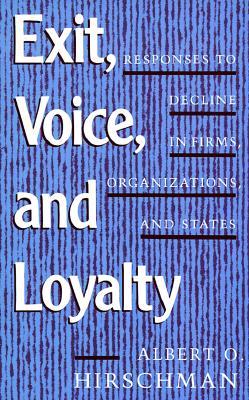
Srinivasan paid tribute to the landmark libertarian 1970 treatise “Exit, Voice, and Loyalty: Responses to Decline in Firms, Organi[s]ations, and States” by Albert O. Hirschman, in which the author stated the following economic conjecture: When any particular form of human system culturally designed to offer a service (a business, charity, government, country, state, school, etc.) experiences a decrease in quality, they have two options for freedom; either Exit or Voice. Put simply, Exit is the attempt to withdraw completely from the relationship provided with the aim of joining or starting up another, whereas Voice gives the customer the right to reform the existing relationship through protest and complaint.
Hirschman used these two options as a prism for opening up a range of economic and political outcomes that encapsulate ones freedom, equally emphasising that such models were mutually exclusive, operating in a parallel stop-start fashion. He understood Exit to be exclusively libertarian where freedom was guided under the economic freedom of the market, where decline could be corrected by ‘better’ services. Voice became the political freedom to confront existing decline by reforming the system within. Unpacked into differing global contexts, Exit vs. Voice shifts into multiple flavours of freedom, emanating from the same source. For a consumer, Exit manifests itself as the freedom to take your business elsewhere, whereas Voice is sending off a complaint form. For a country, Exit becomes emigration whereas Voice becomes the democratic right to vote. In the case of lobbying, Exit expresses itself as the think tank, whilst Voice emerges as the grassroots protest.
However Srinivasan took Hirschman’s options and gave the distinction a new technological edge relatable to an age of platforms, code, startups and disruption. Srinivasan suggested that Exit is a meta-concept which Silicon Valley has implicitly adopted, subsuming Voice without eliminating it (and perhaps even amplifying the latter). It is the hidden gear behind the Valley’s dominance, from various startup successes to the inherent properties of code itself. He cites the fact that Larry Page and Sergey Brin could never have reformed Microsoft from within, and so had to found Google by attaining the freedom to exit Microsoft completely, taking the sustained knowledge of their peers and independently crafting something smarter and better. Similarly, in software engineering if Voice operates as a patch designed to reform existing functional problems, Exit is the fork designed to splinter an existing platform of ineffective decline into a separate, and (presumably) more effective one.

But Srinivasan’s talk was essentially in support with ‘ultimate exit’ – the idea that the United States itself was completely beyond libertarian reform, and that Silicon Valley would in the next 10 years have to secede, and launch its own independent platform if it wanted to maintain freedom. Srinivasan’s rationale (which has solidified its popularity since 2013) is that if you can do it with a startup why not an entire country? It’s not exactly a pipe dream wither. A failed startup called Blueseed already sought funding in order to attempt such a feat, but it was eventually postponed. Blueseed was the closest attempt at creating an ultimate Exit, where a purposely built cruise liner, sailing twelve nautical miles from San Francisco, would allow entrepreneurs to create their own businesses without the need for a U.S work visa. Earlier still, a 2005 startup called SeaCode promised something similar, but similarly folded due to insufficient funding.
In the eyes of the Valley though, the Exit strategy has successfully challenged existing industries anyway; including Hollywood (through Netflix), print and television outlets (through social media), city transport (through Uber), currencies (through Bitcoin and Blockchain), healthcare (The Quantified Self movement), and even simple objects (3-D printing). Before the backlash hit the fan, Srinivasan’s foresaw that the only future worth betting on would involve building “an opt-in society, ultimately outside the United States, run by technology.” Who is John Galt? Presumably Balaji S. Srinivasan.
Randian fetishes aside Exit versus Voice is a clever forced choice. It’s designed to organise a schism in contemporary political thought where cultural activities and labour are increasingly wedded to automation: from casual acts of ordinary communication, to the darkest depths of hidden encryption. It’s a schism which the theoretical movement of Accelerationism is borne out from, despite the clear difference of its political goals and the varying flavours bundled with its name. Replacing Srinivasan’s libertarian freedom for a hard left emancipatory stance, Exit is now construed as engineering a post-capitalist exit, and ‘opting-out’ becomes inventing and repurposing technological infrastructure towards emancipation without losing any of the inhuman significance that got it there.
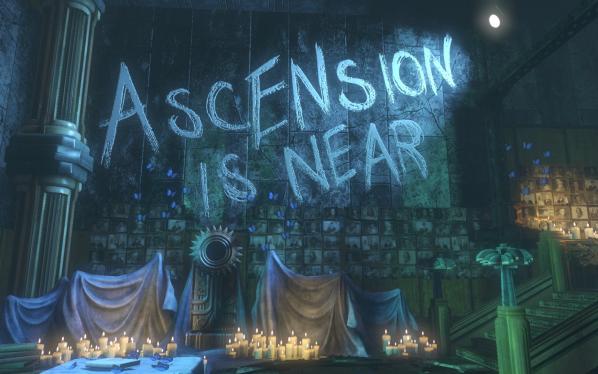
What is it however that philosophically separates the contemporary Left accelerationist position from previous iterations unable to grasp the future, or have resisted such attempts? We are of course reminded of such post-structural flights of fancy, (accelerationist musings of Lyotard, Deleuze and Guattari) to the experimental Cybernetic Cultural Research Unit (CCRU) whose famous figureheads included Nick Land & Sadie Plant. As many have already written, Land has become the quintessential prophet of the contemporary ‘Exit’ strategy (both in his early philosophical work, and later activities) understanding capitalism to be the ultimate engine of inhuman freedom. If our manifest fate is destined to head towards a technological singularity, it has only been put on ice because of meddling Marxists and (in his eyes) a dribbling progressive State. Having reorganised his views into neo-reactionism (NR-x), (which Srinivasan’s talk contributes to and in no small part, influentially gravitated a great number of libertarians towards), Land has one goal: the full realisation of ultimate exit. As Park MacDougald put it last year, Land’s;
Laissez-faire, in this view, is doomed to failure as soon as it’s up for a vote. Rather than accept creeping democratic socialism (which leads to “zombie apocalypse”), Land would prefer to simply abolish democracy and appoint a national CEO. This capitalist Leviathan would be, at a bare minimum, capable of rational long-term planning and aligning individual incentive structures with social well-being (CEO-as-Tiger-Mom). Individuals would have no say in government, but would be generally left alone, and free to leave. This right of “exit” is, for Land, the only meaningful right, and it’s opposed to democratic “voice,” where everyone gets a say, but is bound by the decisions of the majority — the fear being that the majority will decide to self-immolate.
Shockingly, Land’s NR-x demands the elimination of democratic voice altogether because, in his view, economically and socially effective governments legitimize themselves eschewing any appeal for a democratic voice. There isn’t any need for a voice if, like a commercial service, you can just exit your government and join a better one. So long as the functional technocratic inhuman is maximally realised there can be no room for moralism, sentimentality or suffering, for these are the very human traits which hold back our genuine freedom. Bending the market to fit human empathic needs will be futile. The sustained requirement for humans to lend a voice of political appeal is simply too ineffective to halt the inhuman onslaught of capitalist acceleration.
Cemented into the freedom to Exit is the implicit determination that all global technological progress (and its inherent possibilities as production) is bound up with the invisible, impersonal rigour of inhuman market competition, which democratic voice has little hope of addressing, let alone overthrowing. In Land’s view, capitalism is akin to an inhuman non-conceptual alien automatically programming human behaviour in order to drive it forward. This strange, foreign compulsiveness is integral to our dystopian future and Land’s job is to let the tap run (or more accurately, don’t pull the charger out).
So with Land’s current brand of libertarianism leaning more to the right than someone whose right leg has just been blown off, the political ground to develop a Left accelerationism has been given renewed impetus. As Peter Wolfendale previously pointed out, both positions jointly agree that capitalist production and modern developments of social justice are utterly incompatible, and the site of their incompatibility combined with technological expertise is what motivates both to conceive of an Exit: but crucially the discord between them comes from which set of principles should be exited from, and what sort of freedom is called for;
The right thinks that the accelerative emancipatory force is nothing other than capitalism itself, whereas the left thinks that capitalism is an adaptive and plastic obstacle suppressing a deeper emancipatory dynamic. It is in essence a disagreement about freedom: what it is to have it, what it is to enhance it, and whether there is anything we can do about it.
What both forms of freedom inhabit is to construct an exit from the limitations of the current status quo entrenched in reaction, resistance, refusal and reform. If the force of ‘Exit’ is what both movements share, then they also share the same schism of opposing Voice. And in one name or another, this is exactly what Nick Srnicek and Alex Williams have dubbed ‘folk politics’: political methods which eschew inhuman knowledge, global reach, feedback and technological infrastructure favouring instead outdated methods of reform, simplicity, horizontal plurality, immediacy and reactive protest (the 2008 Occupy protests being one example of many). In short, politics that might be associated with the demands of Voice. They may not wish to call it Voice, or be opposed to Voice democratically, and might even propose that it has some sort of place in contemporary political struggle. However, their opposition to a certain form of phenomenological immediacy in authentic resistance (which Voice might certaintly inhabit), carries all the connotations of leftist action they find strategically moribund. Reform and resistance are no longer the sole legitimate leftist options to overcome capitalism.
Their logic is two fold – 1.) reforming the capitalist system through protest, localism and critique alone has become useless at furthering leftist goals, often resulting in unashamed defeatism. Human acts of immediate protest and localism are no longer any match for the long term planning of inhuman complexity that global capitalism has become. The left simply sets itself up to fail.
2.) In light of this failure, contemporary leftist politics has a choice: either reduce political action to a relatable human local level, or embrace complex conceptual mediacy of capitalist process. In adopting the latter, the technological tools at our disposal afforded by capitalism must now invent alternative platforms repurposing leftist change, rather than chastised as oppressive, skeptical limits inherent to it. The left can no longer solely rely on ‘having a voice’ which appeals to habitual sit-ins and sporadic acts of resistance: it must invent alternative methods of infrastructure that will eventually abandon the need for capitalism, overcoming leftist resistance and reform completely (think André Gorz, but with Big Data and Apps).
The output of that challenge operates through various interlocking projects:
—Political theories for how a post-capitalist world that abolishes work can not only be made intelligible but be feasibly engineered (see Srnicek and Williams in their recently released publication ‘Inventing the Future: PostCapitalism and A World Without Work’ published by Verso). To be clear Srnicek and Williams entirely abandon the term ‘Accelerationism’, or ‘Left-accelerationism’ not specifically because of disagreement, but to alleviate widespread confusion.
—Renewed commitments to nineteenth/twentieth century cosmicism that manifests in a post-Earth future. Or alternatively treating science fiction as a necessary path towards a real exit (in its absolute form, exiting the Earth). (See Benedict Singleton’s Maximum Jailbreak)
—Regrounded developments in feminist strategies (see the recent xeno-feminist (XF) manifesto), by the anonymous collective Laboria Cuboniks which in their words asks that “Reason, like information, wants to be free, and patriarchy cannot give it freedom. Rationalism must itself be a feminism. XF marks the point where these claims intersect in a two-way dependency. It names reason as an engine of feminist emancipation, and declares the right of everyone to speak as no one in particular.”
—New strategies for art that oppose contemporary art’s global hegemony (See the forthcoming publication ‘On the necessity of Art’s Exit from Contemporary Art) by Suhail Malik. One might see a recent influence in Holly Herndon’s song “An Exit” which is describes Malik’s exit as “rather than act in angry opposition to an existing aesthetic or marketplace, we just walk away, facing towards the future”.

Yet, the lynchpin that passes through these varying outputs has one additional philosophical goal: one that has reshifted the political site upon which inhuman freedom can be realised through an interconnected philosophy beginning to rethink contemporary forms of reasoning, knowledge and rationalism.
What gives the Left accelerationists an injection of substance is not merely repeating Marxist demands that capitalism is an unjust, unequal system which promotes corpulent wealth, but that it primarily holds back the progressive and explanatory capacities of inhuman reasoning and technological progress (or at least that Voice, under this view, can only ever be the immediate starting point for an inhuman ascension).
Simply put, Left-accelerationism recognises both the lack of freedom and rationality and seeks to restore both in a more contemporary guise: the normative aim of constructing political freedom in ever greater inhuman measures. Thus the additional impulsion of Srnicek and Williams’ project stresses that the only method of overcoming capitalism is to self-master our epistemological knowledge of it , in order to apply methods that structure leverage towards rational self-determination. Here one almost tastes the accelerationist contempt for Leftist skepticism, and all of its appeals to doubt that have become complicit in contemporary forms of political action undermining progressive futurist thought. Skepticism for them, only bestows reason with a staggering lack of imagination and of lives that entirely accept the limits of neo-liberal stupor wrought by epistemic immediacy and affirmationist philosophies (distancing itself from the vitalist aspects of Deleuze and Guattari plays a key developmental role here).
The philosophical appeal toward a universal rationalist epistemology supports accelerationism’s desire to reengage with the Enlightenment project, where freedom becomes the binding of oneself to a universal rational rule (that must include and surpass capitalist and economic development) together with an adherence to that rule. More importantly the universalisation required must be a movement of Promethean ascension which promotes, as Williams puts it alongside Srnicek in an interview with Mohammed Salemy: “the idea that through our knowledge of the world and through political struggle, too, we can open new ways of being free that were unavailable to us before.” Inhuman Exit is rescued from the libertarian darkness of the NR-x hand, and into the clutches of unending rigorous collective reasoning. Inhuman freedom is repurposed away from compulsive slavery of alien market forces, to an alien rationality of a free rational subject that might exit from capital. The only alien demand is an inhuman demand to self-master our own possibilities towards rejecting capitalism (towards a post-capitalist future).
Williams has previously suggested that the twin thinkers of epistemic accelerationism are Ray Brassier and Reza Negarestani (whether these thinkers agree is another matter). Both are highly influenced by Land, and both are committed to an anti-skeptical method of gaining knowledge about the world, where the freedom to reason emerges as rule-governed, practical, revisable, autonomous and collective, not reducible to the manifest experience of humanity yet central to its emergence. Their neo-rationalism repeats the enlightenment’s desire to explain and act on the collective determinacy of the human epistemological condition outside any specific context.
The freedom to self-master an Exit lends its the support for a universal rationalist epistemology as enshrined within Sellars pragmatism (as outlined in Part 1 ). In this guise freedom becomes, according to Brassier, “… not simply the absence of external determination but the agent’s rational self-determination in and through its espousal of a universally applicable rule.” For complicated reasons Sellars sets out a pragmatist view of reasoning which is defined by its anti-skepticism as much as its Promethean promise (dependent on which thread of influence you follow). What makes such freedom a feature of pragmatism is that rationality is understood as an inherently social linguistic activity as well as a rule-based resource for expanding collective knowledge. Freedom through reasoning is grounded in essentially public and social normative practices of communication, that account for the correctness and incorrectness of ordinary linguistic usage and function. The accelerationist motivation is compelled by a pragmatist sensibility that rationality is founded by the capacity of a community to ‘agree in’ statements and judgements as normative commitments and entitlements. This domain from which freedom resides, and where it can be emancipated from, lies in a shared conceptual framework of utility.
The notion that human creatures are defined by living in a normative space of reasons has obvious overlapping concerns with the origins of philosophy, but only really found its teeth in the Enlightenment. The idea that I, as a rational subject can apply a certain concept means I must be committed to or bound by certain consequences. This can be traced through Plato and Aristotle, although the history takes its initial cue from Kant who understood human concepts to be uniquely and fundamentally normative, despite their finite status. Hegel then builds on Kant’s normative insight, eschewing the acknowledgement of finitude, by showing how freedom emerges from normative constraints inherent to discursive social statuses. Or putting it differently, developing an insight that the creation and generation of ideas and concepts arise in a shared normative medium. Freedom is thus, socially expressive, constitutive of norms and rules that already govern and constrain it, yet also subject to generative possibilities which it entertains. As Robert Pippin puts it;
… the problem of freedom, and in the Kantian/Hegelian tradition […] means being able somehow to own up to, justify, and stand behind one’s deeds (reclaim them as my own), and that involves (so it is argued) understanding what it is to be responsive to norms, reasons.(Pippin, The Persistence of Subjectivity: On the Kantian Aftermath, 2005, p. 11)
One of the most influential Hegelian ideas that the epistemic accelerationists have adopted (amongst others) is that without any justification, inferred assertion or claim – let alone a political claim – intelligible forms of progressive political action or agency are out of the question. No human communication occurs, principally, within the sole reducible product of a human individual, but as a distinctly social progressive achievement of reason and that ordinary modes of intelligibility have to be cemented in normative commitments of correctness. The job of philosophy is to offer an explanation constitutive of the very normative system it seeks to explain. Recoding these Kantian and Hegelian insights is said to establish and explain the inner workings of what we mean when we say something.
Clearly, the real reason why such Sellarsian normative accounts are useful is that they are characteristic of many philosophical attempts to comprehend language through a systematic and explainable structure, fully applying the force of reason with practices that commit effective conceptual action. It strips the rational subject back until it finds the primitive inhuman, artificial, functional, rational ‘machine’ guiding the system through the freedoms of feedback and function: What Sellars demarcates as the sapient, normative space of reasons (doing something for a reason) is understood to be completely separate from the sentient, causal nature of reasons (doing something because of a reason). Norms of reasoning cannot, like natural laws, suggest what will happen, but instead what ought to happen, and pinpoint shared, rational outcomes that can be correctly drawn from certain assumptions.
Responsibility and recognition cannot make sense outside of its social, discursive emergence, as is the case of any concept whatsoever, for concepts themselves are characteristically normative. Judgements that express knowledge are distinctively responsible and moreover they express themselves as social commitments. Normative claims and reasons are usually understood as not only bearing commitments and entitlements that take place in discursive behaviour, holding others as responsible, relating to an ideal, rule or standard: they are part and parcel of what it is to be a rational subject. Normative claims are taken to be reciprocal recognitions between human creatures who then take other assertions to be reciprocally rational and assertive to normative ideals, and thus expressive freedom is generated and determined. Thought and expression in this light, begins to give us a manifest grip on a non-perceptual world, which isn’t typically manifest (the dual roles of Sellars’ Manifest Image and Scientific Image provide this ‘grip’). The application of the concept, establishes what is correct as opposed to what might be taken to be phenomenally correct (and thus potentially wrong).
No wonder then this view appeals to general artificial intelligence as a futurist necessity, because sapience must be understood as different from the natural order. This is where Sellars’ anti-skepticism becomes obvious: not only reducing all human voice and communication to a primitive, determinate and rule-governed inhuman process which silently determines our linguistic activity, but at the same time, fully unleashing its ability to explain all possibilities of human communication, as well as what it means to freely communicate at all. It is distinctive that this peculiar inhuman force determines how we ought to act, only insofar as we can conceive it – seeing language this way is what demarcates the normative from the naturalistic, acting on norms is dependent on our recognition of them. Voice and speech simply becomes subordinate to this normative demarcation, because what we say is reducible to what can be thought.
This expressive toolkit for establishing a rational grip on non-perceptible systems in the world is necessary for epistemic-accelerationism. Like Land it commits to the idea that intelligence is wholly functional, but not tied to the machine of the free market, but the machine of rationality (which Land abhors). If it is the case that an inhuman grip of capitalism evades human representation, and with climate change becoming an ever greater non-human concern, then the entrenched political tactics of Voice, the task of the human, must embrace the promethean progress of science and technology and ascend our current cognitive resources accordingly. Srnicek thinks we can do this by returning to Fredric Jameson’s cognitive mapping – “the means to make our own world intelligible to ourselves through a situational understanding of our own position.” Other theorists express the same premise, but in different flavours: the field, the plot, the thread, the yarn. All yearn for the same process: the ongoing project to expand our cognitive intelligibility so that the left can master, identify, calculate and classify invisibly complex systems so as to change them for the better.
However, before we start (or try to start) building space programs and hedge funds for the Left there is a problem. Giving up on Voice becomes far too hasty, insofar as the accelerationist view of Voice is inherently predicated on function, it undermines the very intelligibility it desperately craves. There is a greater depth and vulnerability to Voice that must be addressed which stretches further than the quagmires of reform and resistance. If political intelligibility is predicated on problems of knowledge, questions surrounding what happens to political voice appear to be eradicated. So what happens to it? What might take on the form of addressing normative claims which speak on behalf of others? What might be the unintended political effects of “everyone speaking for no-one in particular”. How does this affect the silenced, who wish to make themselves known, rather than ‘being known’?
It’s easy for the epistemic accelerationists to address political authority if reason’s ascension can be established, but the harder questions arise if reason’s authority is primarily established by vulnerability.
[i] – I’m adopting the American spelling of skepticism here, in large part, because it’s easier to quote from Cavell texts for susequent sections.
“I-love-you: the figure refers not to the declaration of love,
to the avowal,
but to the repeated utterance of the love cry.”
Roland Barthes, The Lover’s Discourse. Fragments, 1977.
Designed and published online on October 14th 2004[1], restored for The Wrong (Again) on November 1st 2015, the website I Love You by French artist Jacques Perconte[2] is not only a wonderful achievement of his research on image files visualization through the Internet, but also a fundamental piece of artwork for three reasons: first, it crystallizes a history of audiovisual technologies in the web age; next, it allows the analysis of his singular inventions on plasticity which are shaped by the offensive processes and techniques Perconte has developed until 2015; finally, it makes explicit the artist’s constant will to put the body to the test of digital technologies (in this case the partner’s body) and to literally inject life (each and every thought, interest, feeling, emotion, excitement, and desire aroused in him by the beloved body).
Two events in 2003 gave birth to this piece: a publication proposal from French publisher Didier Vergnaud of a book with the digital photographs of bodies he had been taking tirelessly; and his romantic encounter with the woman who would become his partner, muse and model, Isabelle Silvagnoli. I Love You merges two stories, two passions. The one with Isabelle blooms in May 2003[3]; at this time, Perconte has already an extensive experience of digital technologies that he had developed since 1995[4].
At the Bordeaux University, when Perconte notices that a computer is connected to the rest of world, he becomes aware of the technical and aesthetic issues of the digital network, issues largely ignored at this time. His quick mastering of how the web operates leads to a decisive work on “the digital bodies”: three image generator websites (ncorps) and four films made by re-filming multiple loops of these animated pictures. This series denotes that Perconte has assimilated four essential dimensions of the digital.
First, he notes the image exists primarily in the state of a compressed digital signal that needs to be displayed; the signal recorded and stored as a file is a model, shaped by algorithms; its visualizations change only according to the codecs and the supports. Next, he distinguishes the human dimension of the web: the bodies of the users surfing the Internet on their computers and interlinking one another.
Then, the material dimension: the computers interconnected by an abundance of servers all around the world which produces a random digital time; indeed Perconte noticed the connection time to the hosting server of his websites was unpredictable since the answering time fluctuated according to the Internet traffic density, the connection’s and the browser’s qualities, and the computer’s performance executing the query.
So he notices the fantastic system failures: “when the first JPEGs popped up on websites, it wasn’t unusual for a picture to be only partially displayed. Sometimes, this happened to produce strange distortions in the image. (…) Every now and then, the image would totally turn into an abstract composition with amazing colors.”[5] Consequently, these fluctuations of display reveal a prodigiously fertile field of investigation: recoding the visualization. Finally, the web can be defined by the coexistence of places, bodies, machines, protocols and programs interacting in complex ways as an evolving ecosystem. Thus, a device aimed at transforming models could be designed (model meaning both the person the artist reproduces with forms and images and the coded reduction), as GIF or JPEG sequences animated on a website. Since the parameters involved in the visualization of these sequences are renewed at each connection, Perconte knows these metamorphosis will be unlimited and give birth to n bodies [corps]). This research allowed Perconte to establish, by 1996, a stable platform aimed at recoding the visualization within the web to ultimately break the limitations of the model’s code into which the digital signal is reduced.

As he undertakes assembling photographs of Isabelle for the book project (38 degrés), this experience of the web will come back to him. The collection of several thousands digital pictures springs from the extensive exploration of the beloved body’s patterns and the obtained signals he looped (he retakes the displayed pictures several times), in an attempt to test the representation of love. The problem is twofold. On the one hand, this collection can only be unlimited since the observation is inexhaustible as he puts it: “when I think about her body, I dream of landscapes so large that one gets lost completely, there is so much to recognize, kilometers of skin where warmth rules, a soft, almost empty desert. Beauty, immensity where every vibration of light pushes the colors to reveal themselves in new ways. The variations (…) are endless.”[6] Furthermore, despite experimental photography techniques, he quickly reaches the limits of how much an image is capable of expressing absolute love. In order to find and visualize this love present within these files, Perconte selects and ranks hundreds of these images in a database and places them in an ecosystem on the web.
Perconte developed a server-side program by writing an open source application in PHP, the love writing program[7], in order to quantify the love present in the source code of these digital images displayed on the web. Love being unquantifiable by definition, the artist must add an arbitrary but rigorous calculation. This quantification is performed by the application triggered when a user clicks on one of the images of the collection: it calculates a specific variable by taking into account all the physical parameters of the connection but also the mathematical constants of proportions and universal harmony – ∏ and F (the golden section); then the application opens the image file, transforms it as a hexadecimal code and substitutes every occurrence of the sought value by the phrase “I Love You,” thus changing the architecture of the code describing the image. The browser requested to visualize the image compiles the modified code, but can only display it partially, at the cost of radical visual transformations, such as reconfigurations pixel structures, the emergence of new colors resulting in the reinterpretation of original motifs or subjects; the greater the amount of pure love, the more intense the abstraction. The motifs of the beloved body can mingle or merge entirely with the figuration of love. The browser is sometimes unable to visualize the image resulting in the appearance of a broken icon with a quote from Roland Barthes: “To try to write love is to confront the muck of language: that region of hysteria where language is both too much and too little, excessive (…) and impoverished (…).”[8]The broken icon evokes a digital iconoclasm, but furthermore signifies the limitations of visualization protocols that have been overtaken by an overflow inexpressible love. This substitution in the image source code of a value by the literal writing of love, raises the Perconte’s program to a “loveware.”[9]
Not only has Perconte given life to this website, but he has been maintaining it for the eleven years he has been sharing his life with his partner. First and foremost, he constantly upgrades it. Indeed, he programmed on February 14th 2005 an “I Love You Collection” of all the “I Love You’s” which will be written in the images’ source code; from this description, the “Love Counter” determines the number of “I Love You’s” and their transposition in bytes: “This is a concrete and scientific way to know as precisely as possible how much love is streamed online, and more importantly how much love is contained in this work. Every time a picture is displayed and the code modified by love messages, the counter is updated. The more time goes by, the more love grows.”[10] Thus, the users themselves, without suspecting it, testify to the history of this Perconte’s love for his partner, write this love, perpetuate and amplify it. Donating his images to the network, leaving it to others to speak for him, the artist is no longer the excessive delirious lover (wonderfully described by Barthes[11]), but one who loves. Then, the artist updates his website on a regular basis.
For each exhibition he replaces the image collection and operates small technical changes in order to avoid falling behind on the developments of the web. Furthermore, he designed a photographic exhibition of this work started in 2003, It’s All About Love, from January 17th to April 17th 2008 in Pessac, where he gives to the public a synthesis and extension of the project, in the form of prints and animations on iPods[12]. Finally, he undertakes a complete restoration of the website in 2015. Indeed, I Love You has suffered from a rapid disruption of the web and the visualized pictures often began to show large gray patches. The invitation from The Wrong gave him the opportunity to get back to this core piece. The solution – consisting in placing the website in its original technological context, that is to say, on a server with the same configurations as in 2004 – was met with refusal from the web hosting providers. This is how he decided to work with one of his students of Chalon-sur-Saône, Garam Choi, a true code virtuoso, in order to rethink the programming of the website according to a large principle which governs web in recent years.
From the beginning of the web until the posting of I Love You, applications were executed by servers. However, with the exponential increase in web traffic, servers quickly became overloaded; moreover, computers have seen their computing power and storage soar while other programming languages, like JavaScript, gained importance. Thus, the logic that governed web-programming moved applications to the client-side. Choi and Perconte have therefore developed identically, from the original program in PHP, an application written in JavaScript so that it could be interpreted on the client-side, while maintaining the database on a server. The issue at stake was to create a dialogue between the server and the client-side application, especially to quantify the number of “I Love You’s” and write it into the database. Indeed, server specifications entail technological obstacles as soon as the instructions are not in compliance with the protocol. But the artist was quickly able to find a way to instruct the program to circumvent the prohibitions. Indeed, not only does he operates the substitution technique to modify the images source codes, but uses it as a trick to fool the server. The idea is to do it as if the client were loading an image from the server to display it; but the called address executes instead a script, in other words, instead of the image URL, the number of “I Love You’s” is shown.

The website restoration therefore takes hold of the website’s programming in the 2010’s, but reinvents it with ingenuity. It also alerts the Internet user on how some multinationals IT companies (Apple, Google) consider the universality of the net: Chrome hinders some images display, while Safari denies their visualization. Also, in the latter case, Perconte and Choi have provided the following message to the attention of the user: “Safari is not ready for love. It’s still blind.” On the contrary, the Firefox browser, developed by a global open-source community, allows optimal operation of I Love You at the exact replica of the first 2004 version. Indeed, Mozilla defends a free Internet that would be “a global public resource that must remain open and accessible” in which “everyone should be able to shape the Internet and their own experiences on the Internet.”[13] That is why the growing love of I Love You does not only symbolize the artist in his couple, but elevates itself to a principle of universal union and intimate communion through the web: a set of values that affirm a convivial conception of society resisting consumerist models imposed by technical industries, and taking the power of the Web back in the hands of all users.
I Love You is therefore crucial for the Internet user, the historian, the media theorist, the film analyst, the archivist and the curator of the twenty-first century. It invents a thought of the program as a plasticity fertilization tool through digital visualization technologies understood as open and unstable. It successfully manages to offer bright and virtuoso processes and techniques of recoding, exciting insights on the operation of some display supports and devices, along with their history and unrelenting criticism, and the refined and infinite visual writing of the story of a man in love through a limitless range of radical visual forms generating a pure aesthetic delight. It is an artwork that lives and grows thanks to the Internet users as a digital lining of a relationship blossoming in the world, and which, since it has adapted and transformed to the changing technological environment, becomes the figurehead of a libertarian conception of the Internet and digital technologies in general.
Warmest thanks to Nicole Brenez, Gaëlle Cintré, Kamilia Kard,
Filippo Lorenzin, Zachary Parris,
Jacques Perconte and Isabelle Silvagnoli.
(In)exactitude in Science : http://inexactitudeinscience.com
and I Love You : http://iloveyou.38degres.net
Text is translated from the first french extended edition : http://www.debordements.fr/spip.php?article431